Inseego NVWE725 Dual-Band CDMA / EVDO Modem Card User Manual book
Novatel Wireless Inc Dual-Band CDMA / EVDO Modem Card book
Inseego >
Contents
Manual 4

www.dell.com | support.dell.com
FILE LOCATION: C:\Documents and Settings\reggie_davis\Desktop\Projects-07\BEN\Source\title.fm
DELL CONFIDENTIAL – PRELIMINARY 1/25/07 – FOR PROOF ONLY
Template Last Updated - 7/01/2005
Dell™ Latitude™ D630
User’s Guide
Model PP24L

FILE LOCATION: C:\Documents and Settings\reggie_davis\Desktop\Projects-07\BEN\Source\title.fm
DELL CONFIDENTIAL – PRELIMINARY 1/25/07 – FOR PROOF ONLY
Notes, Notices, and Cautions
NOTE: A NOTE indicates important information that helps you make better use of your computer.
NOTICE: A NOTICE indicates either potential damage to hardware or loss of data and tells you how to avoid the
problem.
CAUTION: A CAUTION indicates a potential for property damage, personal injury, or death.
If you purchased a Dell™ n Series computer, any references in this document to Microsoft
®
Windows
®
operating systems are not applicable.
____________________
Information in this document is subject to change without notice.
© 2007 Dell Inc. All rights reserved.
Trademarks used in this text: Dell, the DELL logo, Inspiron, Dell Precision, Dimension, OptiPlex, Latitude, PowerEdge, PowerVault,
PowerApp, ExpressCharge, TravelLite, Strike Zone, Wi-Fi Catcher, Dell MediaDirect, XPS, and Dell OpenManage are trademarks of Dell
Inc.; Core and Intel are registered trademarks of Intel Corporation; Microsoft, Outlook, and Windows are registered trademarks of Microsoft
Corporation; Bluetooth is a registered trademark owned by Bluetooth SIG, Inc. and is used by Dell under license; TouchStrip is a trademark
of UPEK, Inc.; EMC is a registered trademark of EMC Corporation; ENERGY STAR is a registered trademark of the U.S. Environmental
Protection Agency. As an ENERGY STAR partner, Dell Inc. has determined that this product meets the ENERGY STAR guidelines for energy
efficiency.
Other trademarks and trade names may be used in this document to refer to either the entities claiming the marks and names or their products.
Dell Inc. disclaims any proprietary interest in trademarks and trade names other than its own.
Model PP24L
February 2007 P/N P134851 Rev. A00

Template Last Updated - 10/13/2005 Contents 3
FILE LOCATION: C:\Documents and Settings\reggie_davis\Desktop\Projects-07\BEN\Source\bookTOC.fm
DELL CONFIDENTIAL – PRELIMINARY 1/25/07 – FOR PROOF ONLY
Contents
1 Finding Information . . . . . . . . . . . . . . . . . . . . . . . . . . . . 11
2 About Your Computer . . . . . . . . . . . . . . . . . . . . . . . . . . . 15
Front View . . . . . . . . . . . . . . . . . . . . . . . . . . . . . . . . . . . . 15
Left Side View . . . . . . . . . . . . . . . . . . . . . . . . . . . . . . . . . . 18
Right Side View . . . . . . . . . . . . . . . . . . . . . . . . . . . . . . . . . 20
Back View . . . . . . . . . . . . . . . . . . . . . . . . . . . . . . . . . . . . 21
Bottom View . . . . . . . . . . . . . . . . . . . . . . . . . . . . . . . . . . . 24
3 Transferring Information to a New Computer . . . . . . . . . . 27
Microsoft® Windows® XP . . . . . . . . . . . . . . . . . . . . . . . . . . . 27
Running the Files and Settings Transfer Wizard With the Operating System Media
27
Running the Files and Settings Transfer Wizard Without the Operating System Media
28
Microsoft Windows Vista™ . . . . . . . . . . . . . . . . . . . . . . . . . . . 29
Easy Transfer Cable for Windows Vista . . . . . . . . . . . . . . . . . . 29
4 Using a Battery . . . . . . . . . . . . . . . . . . . . . . . . . . . . . . . 33
Battery Performance . . . . . . . . . . . . . . . . . . . . . . . . . . . . . . . 33
Checking the Battery Charge . . . . . . . . . . . . . . . . . . . . . . . . . . 34
Dell™ QuickSet Battery Meter . . . . . . . . . . . . . . . . . . . . . . . 34
Microsoft® Windows® Power Meter . . . . . . . . . . . . . . . . . . . 34
Charge Gauge. . . . . . . . . . . . . . . . . . . . . . . . . . . . . . . . 34
Low-Battery Warning . . . . . . . . . . . . . . . . . . . . . . . . . . . . 35
Conserving Battery Power . . . . . . . . . . . . . . . . . . . . . . . . . . . . 35
Power Management Modes . . . . . . . . . . . . . . . . . . . . . . . . . . . 35
Standby and Sleep Mode . . . . . . . . . . . . . . . . . . . . . . . . . . 35

4Contents
FILE LOCATION: C:\Documents and Settings\reggie_davis\Desktop\Projects-07\BEN\Source\bookTOC.fm
DELL CONFIDENTIAL – PRELIMINARY 1/25/07 – FOR PROOF ONLY
Hibernate Mode. . . . . . . . . . . . . . . . . . . . . . . . . . . . . . . 36
Configuring Power Management Settings . . . . . . . . . . . . . . . . . . . 36
Accessing Power Options Properties . . . . . . . . . . . . . . . . . . . 37
Charging the Battery . . . . . . . . . . . . . . . . . . . . . . . . . . . . . . . 37
Replacing the Battery . . . . . . . . . . . . . . . . . . . . . . . . . . . . . . 37
Storing a Battery . . . . . . . . . . . . . . . . . . . . . . . . . . . . . . . . . 38
Battery Errors. . . . . . . . . . . . . . . . . . . . . . . . . . . . . . . . . . . 38
5 Using the Keyboard . . . . . . . . . . . . . . . . . . . . . . . . . . . . 39
Numeric Keypad . . . . . . . . . . . . . . . . . . . . . . . . . . . . . . . . . 39
Key Combinations . . . . . . . . . . . . . . . . . . . . . . . . . . . . . . . . 39
System Functions . . . . . . . . . . . . . . . . . . . . . . . . . . . . . . 39
Battery . . . . . . . . . . . . . . . . . . . . . . . . . . . . . . . . . . . 40
Display Functions . . . . . . . . . . . . . . . . . . . . . . . . . . . . . . 40
Power Management . . . . . . . . . . . . . . . . . . . . . . . . . . . . 40
Microsoft® Windows® Logo Key Functions. . . . . . . . . . . . . . . . 40
Touch Pad . . . . . . . . . . . . . . . . . . . . . . . . . . . . . . . . . . . . 41
Customizing the Touch Pad and Track Stick . . . . . . . . . . . . . . . . 42
Changing the Track Stick Cap . . . . . . . . . . . . . . . . . . . . . . . . . . 42
6 Using the Display. . . . . . . . . . . . . . . . . . . . . . . . . . . . . . 43
Adjusting Brightness. . . . . . . . . . . . . . . . . . . . . . . . . . . . . . . 43
Using the Ambient Light Sensor . . . . . . . . . . . . . . . . . . . . . . . . . 43
Switching the Video Image . . . . . . . . . . . . . . . . . . . . . . . . . . . 44
Setting Display Resolution and Refresh Rate . . . . . . . . . . . . . . . . . . 44
Dual Independent Display Mode . . . . . . . . . . . . . . . . . . . . . . . . 45
Swapping Primary and Secondary Displays . . . . . . . . . . . . . . . . . . 45

Template Last Updated - 10/13/2005 Contents 5
FILE LOCATION: C:\Documents and Settings\reggie_davis\Desktop\Projects-07\BEN\Source\bookTOC.fm
DELL CONFIDENTIAL – PRELIMINARY 1/25/07 – FOR PROOF ONLY
7 Setting Up and Using Networks . . . . . . . . . . . . . . . . . . . 47
Connecting a Network or Broadband Modem Cable . . . . . . . . . . . . . . 47
Setting Up a Network in the Microsoft® Windows® XP Operating System . . 47
Setting Up a Network in the Microsoft Windows Vista™ Operating System . 48
Wireless Local Area Network . . . . . . . . . . . . . . . . . . . . . . . . . . 48
What You Need to Establish a WLAN Connection . . . . . . . . . . . . . 48
Checking Your Wireless Network Card. . . . . . . . . . . . . . . . . . . 48
Setting Up a New WLAN Using a Wireless Router and a Broadband Modem 49
Connecting to a WLAN . . . . . . . . . . . . . . . . . . . . . . . . . . . 50
Mobile Broadband (or Wireless Wide Area Network) . . . . . . . . . . . . . 52
What You Need to Establish a Mobile Broadband Network Connection . 52
Checking Your Dell Mobile Broadband Card . . . . . . . . . . . . . . . . 52
Connecting to a Mobile Broadband Network . . . . . . . . . . . . . . . 53
Enabling/Disabling the Dell™ Mobile Broadband Card . . . . . . . . . . 53
Managing Your Network Settings Through the Dell QuickSet Location Profiler 53
Dell Wi-Fi Catcher™ Network Locator . . . . . . . . . . . . . . . . . . . . . 54
Microsoft® Windows® Firewall . . . . . . . . . . . . . . . . . . . . . . . . 54
8 Using Multimedia . . . . . . . . . . . . . . . . . . . . . . . . . . . . . 55
Playing Media . . . . . . . . . . . . . . . . . . . . . . . . . . . . . . . . . . 55
Copying Media . . . . . . . . . . . . . . . . . . . . . . . . . . . . . . . . . . 56
How to Copy Media . . . . . . . . . . . . . . . . . . . . . . . . . . . . . 57
Using Blank Media . . . . . . . . . . . . . . . . . . . . . . . . . . . . . 57
Helpful Tips . . . . . . . . . . . . . . . . . . . . . . . . . . . . . . . . . 58
Adjusting the Volume . . . . . . . . . . . . . . . . . . . . . . . . . . . . . . 58
Adjusting the Picture . . . . . . . . . . . . . . . . . . . . . . . . . . . . . . 59
Microsoft® Windows® XP Operating System . . . . . . . . . . . . . . . 59
Microsoft Windows Vista™ Operating System . . . . . . . . . . . . . . . 59
9 Using Cards . . . . . . . . . . . . . . . . . . . . . . . . . . . . . . . . . 61
Card Types . . . . . . . . . . . . . . . . . . . . . . . . . . . . . . . . . . . . 61
PC Cards . . . . . . . . . . . . . . . . . . . . . . . . . . . . . . . . . . 61

6Contents
FILE LOCATION: C:\Documents and Settings\reggie_davis\Desktop\Projects-07\BEN\Source\bookTOC.fm
DELL CONFIDENTIAL – PRELIMINARY 1/25/07 – FOR PROOF ONLY
Smart Cards . . . . . . . . . . . . . . . . . . . . . . . . . . . . . . . . . 61
Card Blanks . . . . . . . . . . . . . . . . . . . . . . . . . . . . . . . . . 61
Extended Cards . . . . . . . . . . . . . . . . . . . . . . . . . . . . . . . 61
Installing a PC Card . . . . . . . . . . . . . . . . . . . . . . . . . . . . . . . 62
PC Card . . . . . . . . . . . . . . . . . . . . . . . . . . . . . . . . . . . 62
Removing a Card or Blank . . . . . . . . . . . . . . . . . . . . . . . . . . . . 62
10 Securing Your Computer. . . . . . . . . . . . . . . . . . . . . . . . . 65
Security Cable Lock . . . . . . . . . . . . . . . . . . . . . . . . . . . . . . . 65
Smart Card . . . . . . . . . . . . . . . . . . . . . . . . . . . . . . . . . . . . 65
About Smart Cards . . . . . . . . . . . . . . . . . . . . . . . . . . . . . 66
Installing a Smart Card . . . . . . . . . . . . . . . . . . . . . . . . . . . 66
Passwords . . . . . . . . . . . . . . . . . . . . . . . . . . . . . . . . . . . . 67
About Passwords . . . . . . . . . . . . . . . . . . . . . . . . . . . . . . 67
Using a Primary (or System) Password. . . . . . . . . . . . . . . . . . . 68
Using an Administrator Password . . . . . . . . . . . . . . . . . . . . . 69
Using a Hard Drive Password . . . . . . . . . . . . . . . . . . . . . . . 69
Trusted Platform Module (TPM) . . . . . . . . . . . . . . . . . . . . . . . . . 70
Enabling the TPM Feature . . . . . . . . . . . . . . . . . . . . . . . . . 70
Security Management Software. . . . . . . . . . . . . . . . . . . . . . . . . 70
Activating the Security Management Software . . . . . . . . . . . . . . 71
Using the Security Management Software. . . . . . . . . . . . . . . . . 71
Computer Tracking Software . . . . . . . . . . . . . . . . . . . . . . . . . . 71
If Your Computer Is Lost or Stolen . . . . . . . . . . . . . . . . . . . . . . . . 71
Cleaning Your Computer . . . . . . . . . . . . . . . . . . . . . . . . . . . . . 73
Computer, Keyboard, and Display . . . . . . . . . . . . . . . . . . . . . 73
Touch Pad . . . . . . . . . . . . . . . . . . . . . . . . . . . . . . . . . . 73
Mouse. . . . . . . . . . . . . . . . . . . . . . . . . . . . . . . . . . . . 73
Floppy Drive . . . . . . . . . . . . . . . . . . . . . . . . . . . . . . . . . 74
CDs and DVDs. . . . . . . . . . . . . . . . . . . . . . . . . . . . . . . . 74

Template Last Updated - 10/13/2005 Contents 7
FILE LOCATION: C:\Documents and Settings\reggie_davis\Desktop\Projects-07\BEN\Source\bookTOC.fm
DELL CONFIDENTIAL – PRELIMINARY 1/25/07 – FOR PROOF ONLY
11 Troubleshooting . . . . . . . . . . . . . . . . . . . . . . . . . . . . . . 75
Dell™ Technical Update Service . . . . . . . . . . . . . . . . . . . . . . . . 75
Dell Diagnostics . . . . . . . . . . . . . . . . . . . . . . . . . . . . . . . . . 75
When to Use the Dell Diagnostics . . . . . . . . . . . . . . . . . . . . . 75
Starting the Dell Diagnostics From Your Hard Drive . . . . . . . . . . . . 75
Starting the Dell Diagnostics from the Drivers and Utilities Media . . . . 76
Dell Diagnostics Main Menu . . . . . . . . . . . . . . . . . . . . . . . . 77
Dell Support Utility. . . . . . . . . . . . . . . . . . . . . . . . . . . . . . . . 78
Accessing the Dell Support Utility . . . . . . . . . . . . . . . . . . . . . 78
Clicking the Dell Support Icon . . . . . . . . . . . . . . . . . . . . . . . 78
Double-Clicking the Dell Support Icon . . . . . . . . . . . . . . . . . . . 79
Drive Problems . . . . . . . . . . . . . . . . . . . . . . . . . . . . . . . . . . 79
Media drive problems. . . . . . . . . . . . . . . . . . . . . . . . . . . . 79
If you cannot eject the CD, CD-RW, DVD, or DVD+RW drive tray . . . . . 80
If you hear an unfamiliar scraping or grinding sound . . . . . . . . . . . 80
Hard drive problems . . . . . . . . . . . . . . . . . . . . . . . . . . . . 80
E-Mail, Modem, and Internet Problems . . . . . . . . . . . . . . . . . . . . . 80
Error Messages . . . . . . . . . . . . . . . . . . . . . . . . . . . . . . . . . 81
IEEE 1394 Device Problems . . . . . . . . . . . . . . . . . . . . . . . . . . . 85
Keyboard Problems . . . . . . . . . . . . . . . . . . . . . . . . . . . . . . . 85
External Keyboard problems . . . . . . . . . . . . . . . . . . . . . . . . 86
Unexpected characters. . . . . . . . . . . . . . . . . . . . . . . . . . . 86
Lockups and Software Problems . . . . . . . . . . . . . . . . . . . . . . . . 86
The computer does not start up . . . . . . . . . . . . . . . . . . . . . . 87
The computer stops responding . . . . . . . . . . . . . . . . . . . . . . 87
A program stops responding or crashes repeatedly . . . . . . . . . . . . 87
A program is designed for an earlier Microsoft® Windows® operating system 87
A solid blue screen appears . . . . . . . . . . . . . . . . . . . . . . . . 87
Other software problems . . . . . . . . . . . . . . . . . . . . . . . . . . 87
Memory Problems . . . . . . . . . . . . . . . . . . . . . . . . . . . . . . . . 88
Network Problems . . . . . . . . . . . . . . . . . . . . . . . . . . . . . . . . 88
General . . . . . . . . . . . . . . . . . . . . . . . . . . . . . . . . . . . 89
Wireless Local Area Network (WLAN) . . . . . . . . . . . . . . . . . . . 89
Mobile Broadband (Wireless Wide Area Network) . . . . . . . . . . . . 89

8Contents
FILE LOCATION: C:\Documents and Settings\reggie_davis\Desktop\Projects-07\BEN\Source\bookTOC.fm
DELL CONFIDENTIAL – PRELIMINARY 1/25/07 – FOR PROOF ONLY
PC Card Problems . . . . . . . . . . . . . . . . . . . . . . . . . . . . . . . . 90
Power Problems . . . . . . . . . . . . . . . . . . . . . . . . . . . . . . . . . 90
Ensuring Sufficient Power for Your Computer . . . . . . . . . . . . . . . 91
Docking Power Considerations. . . . . . . . . . . . . . . . . . . . . . . 91
Printer Problems . . . . . . . . . . . . . . . . . . . . . . . . . . . . . . . . . 92
Scanner Problems . . . . . . . . . . . . . . . . . . . . . . . . . . . . . . . . 92
Sound and Speaker Problems . . . . . . . . . . . . . . . . . . . . . . . . . . 93
No sound from integrated speakers . . . . . . . . . . . . . . . . . . . . 93
No sound from external speakers . . . . . . . . . . . . . . . . . . . . . 93
No sound from headphones . . . . . . . . . . . . . . . . . . . . . . . . 93
Touch Pad or Mouse Problems . . . . . . . . . . . . . . . . . . . . . . . . . 94
Video and Display Problems. . . . . . . . . . . . . . . . . . . . . . . . . . . 94
If the display is blank . . . . . . . . . . . . . . . . . . . . . . . . . . . . 94
If the display is difficult to read . . . . . . . . . . . . . . . . . . . . . . . 95
If only part of the display is readable . . . . . . . . . . . . . . . . . . . . 95
12 System Setup Program. . . . . . . . . . . . . . . . . . . . . . . . . . 97
Overview . . . . . . . . . . . . . . . . . . . . . . . . . . . . . . . . . . . . . 97
Viewing the System Setup Screens . . . . . . . . . . . . . . . . . . . . . . . 97
System Setup Screens . . . . . . . . . . . . . . . . . . . . . . . . . . . . . . 97
Commonly Used Options . . . . . . . . . . . . . . . . . . . . . . . . . . . . . 98
Changing the Boot Sequence. . . . . . . . . . . . . . . . . . . . . . . . 98
Changing Printer Modes . . . . . . . . . . . . . . . . . . . . . . . . . . 99
Changing COM Ports . . . . . . . . . . . . . . . . . . . . . . . . . . . . 99
13 Reinstalling Software. . . . . . . . . . . . . . . . . . . . . . . . . . 101
Drivers . . . . . . . . . . . . . . . . . . . . . . . . . . . . . . . . . . . . . 101
What Is a Driver? . . . . . . . . . . . . . . . . . . . . . . . . . . . . . 101
Identifying Drivers . . . . . . . . . . . . . . . . . . . . . . . . . . . . 101
Reinstalling Drivers and Utilities . . . . . . . . . . . . . . . . . . . . . 102
Using the Hardware Troubleshooter Tool . . . . . . . . . . . . . . . . . . . 104
Microsoft Windows XP . . . . . . . . . . . . . . . . . . . . . . . . . . 104

Template Last Updated - 10/13/2005 Contents 9
FILE LOCATION: C:\Documents and Settings\reggie_davis\Desktop\Projects-07\BEN\Source\bookTOC.fm
DELL CONFIDENTIAL – PRELIMINARY 1/25/07 – FOR PROOF ONLY
Microsoft Windows Vista . . . . . . . . . . . . . . . . . . . . . . . . . 105
Restoring Your Operating System . . . . . . . . . . . . . . . . . . . . . . . 105
Using Microsoft® Windows® System Restore . . . . . . . . . . . . . . 105
Using the Operating System Media. . . . . . . . . . . . . . . . . . . . 106
14 Adding and Replacing Parts . . . . . . . . . . . . . . . . . . . . . 109
Before You Begin. . . . . . . . . . . . . . . . . . . . . . . . . . . . . . . . 109
Recommended Tools . . . . . . . . . . . . . . . . . . . . . . . . . . . 109
Turning Off Your Computer . . . . . . . . . . . . . . . . . . . . . . . . 109
Before Working Inside Your Computer . . . . . . . . . . . . . . . . . . 109
Hinge Cover . . . . . . . . . . . . . . . . . . . . . . . . . . . . . . . . . . 111
Keyboard . . . . . . . . . . . . . . . . . . . . . . . . . . . . . . . . . . . . 111
Internal Card With Bluetooth® Wireless Technology. . . . . . . . . . . . . 113
Coin-Cell Battery . . . . . . . . . . . . . . . . . . . . . . . . . . . . . . . . 114
Memory. . . . . . . . . . . . . . . . . . . . . . . . . . . . . . . . . . . . . 115
Wireless Local Area Network (WLAN) Card . . . . . . . . . . . . . . . . . 120
Mobile Broadband Card . . . . . . . . . . . . . . . . . . . . . . . . . . . . 122
Subscriber Identity Module (SIM) Card . . . . . . . . . . . . . . . . . . . . 125
Hard Drive . . . . . . . . . . . . . . . . . . . . . . . . . . . . . . . . . . . 126
Media Bay . . . . . . . . . . . . . . . . . . . . . . . . . . . . . . . . . . . 128
Removing Media Bay Devices . . . . . . . . . . . . . . . . . . . . . . 128
FCM (Flash Cache Module) . . . . . . . . . . . . . . . . . . . . . . . . . . 128
15 Dell™ QuickSet . . . . . . . . . . . . . . . . . . . . . . . . . . . . . 131
16 Traveling With Your Computer. . . . . . . . . . . . . . . . . . . . 133
Identifying Your Computer . . . . . . . . . . . . . . . . . . . . . . . . . . . 133
Packing the Computer . . . . . . . . . . . . . . . . . . . . . . . . . . . . . 133
Travel Tips . . . . . . . . . . . . . . . . . . . . . . . . . . . . . . . . . . . 133

10 Contents
FILE LOCATION: C:\Documents and Settings\reggie_davis\Desktop\Projects-07\BEN\Source\bookTOC.fm
DELL CONFIDENTIAL – PRELIMINARY 1/25/07 – FOR PROOF ONLY
Traveling by Air . . . . . . . . . . . . . . . . . . . . . . . . . . . . . . 134
17 Getting Help . . . . . . . . . . . . . . . . . . . . . . . . . . . . . . . . 135
Obtaining Assistance . . . . . . . . . . . . . . . . . . . . . . . . . . . . . 135
Technical Support and Customer Service . . . . . . . . . . . . . . . . 135
DellConnect . . . . . . . . . . . . . . . . . . . . . . . . . . . . . . . . 135
Online Services . . . . . . . . . . . . . . . . . . . . . . . . . . . . . . 136
AutoTech Service . . . . . . . . . . . . . . . . . . . . . . . . . . . . . 136
Automated Order-Status Service . . . . . . . . . . . . . . . . . . . . . 137
Problems With Your Order . . . . . . . . . . . . . . . . . . . . . . . . . . . 137
Product Information . . . . . . . . . . . . . . . . . . . . . . . . . . . . . . 137
Returning Items for Warranty Repair or Credit . . . . . . . . . . . . . . . . 137
Before You Call. . . . . . . . . . . . . . . . . . . . . . . . . . . . . . . . . 138
Contacting Dell. . . . . . . . . . . . . . . . . . . . . . . . . . . . . . . . . 140
18 Specifications . . . . . . . . . . . . . . . . . . . . . . . . . . . . . . . 163
19 Appendix . . . . . . . . . . . . . . . . . . . . . . . . . . . . . . . . . . 169
FCC Notice (U.S. Only) . . . . . . . . . . . . . . . . . . . . . . . . . . . . . 169
FCC Class B . . . . . . . . . . . . . . . . . . . . . . . . . . . . . . . . 169
Macrovision Product Notice. . . . . . . . . . . . . . . . . . . . . . . . . . 170
Glossary . . . . . . . . . . . . . . . . . . . . . . . . . . . . . . . . . . . . . 171
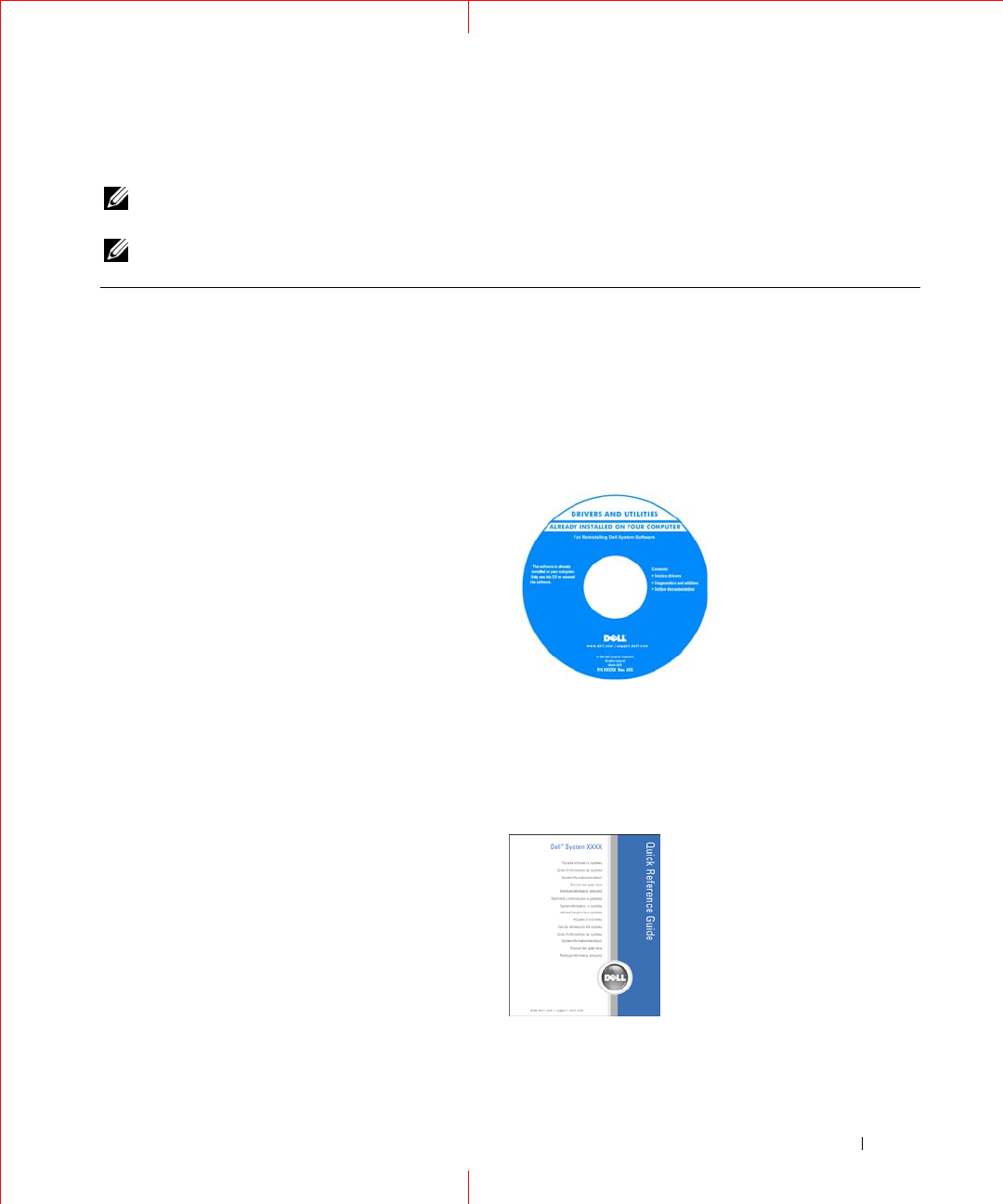
Finding Information 11
FILE LOCATION: C:\Documents and Settings\reggie_davis\Desktop\Projects-07\BEN\Source\findinfo.fm
DELL CONFIDENTIAL – PRELIMINARY 1/25/07 – FOR PROOF ONLY
Finding Information
NOTE: Some features or media may be optional and may not ship with your computer. Some features or media may
not be available in certain countries.
NOTE: Additional information may ship with your computer.
What Are You Looking For? Find It Here
• A diagnostic program for my computer
• Drivers for my computer
• My device documentation
• Notebook System Software (NSS)
Drivers and Utilities Media (also known as ResourceCD)
NOTE: The Drivers and Utilities media may be optional and
may not ship with your computer.
Documentation and drivers are already installed on your
computer. You can use the media to reinstall drivers (see
"Reinstalling Drivers and Utilities" on page 102) or to run
the Dell Diagnostics (see "Dell Diagnostics" on page 75).
Readme files may be
included on your media to
provide last-minute
updates about technical
changes to your computer
or advanced technical-
reference material for
technicians or experienced
users.
NOTE: Drivers and documentation updates can be found at
support.dell.com.
• How to set up my computer
• Basic troubleshooting information
• How to run the Dell Diagnostics
• How to open my computer
Quick Reference Guide
NOTE: This document may be optional and may not ship with
your computer.
NOTE: This document is available as a PDF at
support.dell.com.
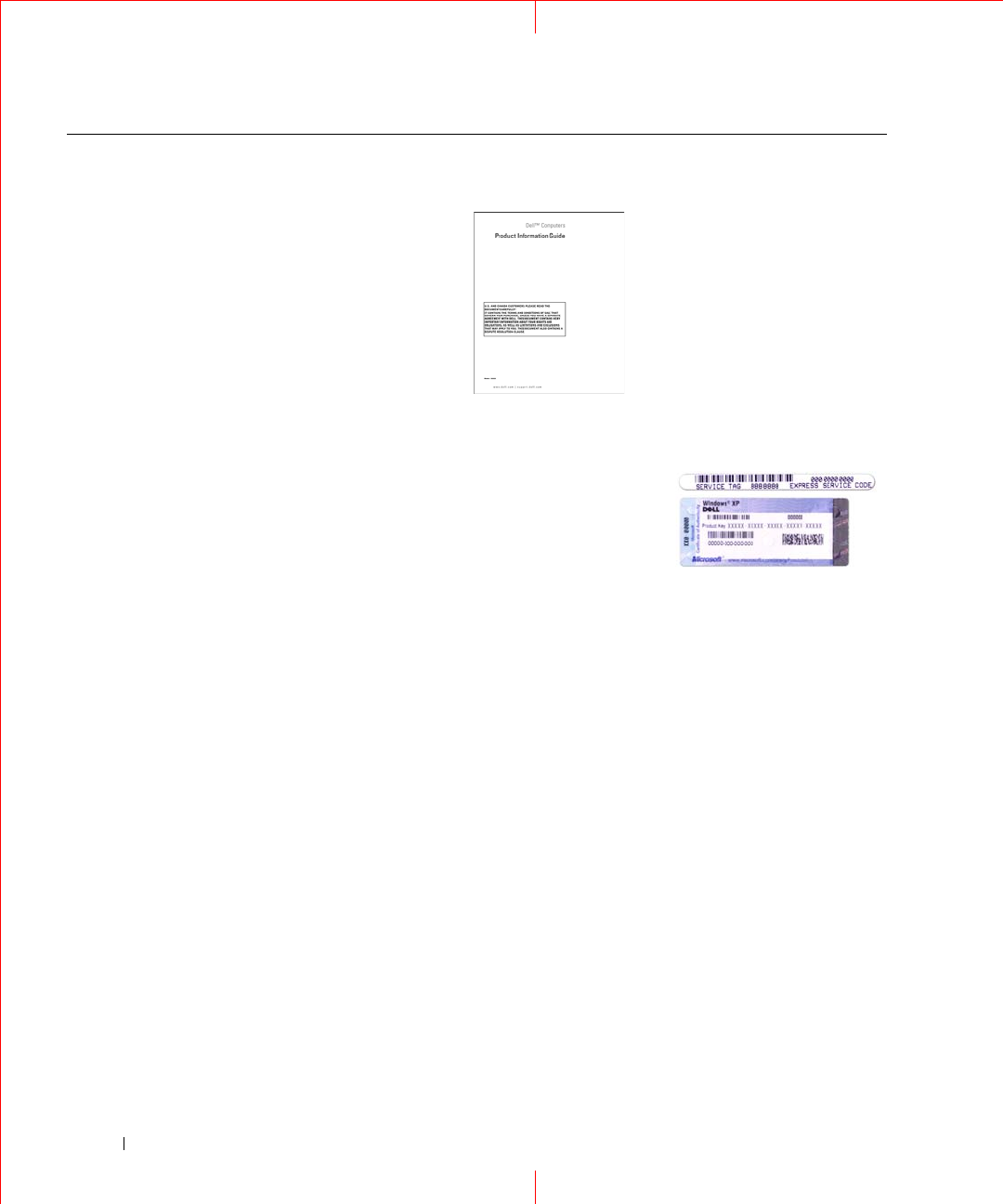
12 Finding Information
FILE LOCATION: C:\Documents and Settings\reggie_davis\Desktop\Projects-07\BEN\Source\findinfo.fm
DELL CONFIDENTIAL – PRELIMINARY 1/25/07 – FOR PROOF ONLY
• Warranty information
• Terms and Conditions (U.S. only)
• Safety instructions
• Regulatory information
• Ergonomics information
• End User License Agreement
Dell™ Product Information Guide
• Service Tag and Express Service Code
• Microsoft Windows License Label
Service Tag and Microsoft
®
Windows
®
License
These labels are located on your computer:
• Use the Service Tag to identify your computer when you
use
support.dell.com
or contact support.
• Enter the Express Service Code to direct your call when
contacting support.
What Are You Looking For? Find It Here

Finding Information 13
FILE LOCATION: C:\Documents and Settings\reggie_davis\Desktop\Projects-07\BEN\Source\findinfo.fm
DELL CONFIDENTIAL – PRELIMINARY 1/25/07 – FOR PROOF ONLY
• Solutions — Troubleshooting hints and tips, articles
from technicians, and online courses, frequently asked
questions
• Community — Online discussion with other Dell
customers
• Upgrades — Upgrade information for components, such
as memory, the hard drive, and the operating system
• Customer Care — Contact information, service call and
order status, warranty, and repair information
• Service and support — Service call status and support
history, service contract, online discussions with
technical support
• Dell Technical Update Service — Proactive e-mail
notification of software and hardware updates for your
computer
• Reference — Computer documentation, details on my
computer configuration, product specifications, and
white papers
• Downloads — Certified drivers, patches, and software
updates
• Notebook System Software (NSS)— If you reinstall the
operating system for your computer, you should also
reinstall the NSS utility. NSS provides critical updates
for your operating system and support for processors,
optical drives, USB devices, and so on. NSS is necessary
for correct operation of your Dell computer. The
software automatically detects your computer and
operating system and installs the updates appropriate
for your configuration.
Dell Support Website — support.dell.com
NOTE: Select your region or business segment to view the
appropriate support site.
To download Notebook System Software:
1
Go to
support.dell.com
, select your region or business
segment, and enter your Service Tag.
2
Select
Drivers & Downloads
and click
Go
.
3
Click your operating system and search for the keyword
Notebook System Software
.
NOTE: The support.dell.com user interface may vary
depending on your selections.
• Software upgrades and troubleshooting hints —
Frequently asked questions, hot topics, and general
health of your computing environment
Dell Support Utility
The Dell Support Utility is an automated upgrade and
notification system installed on your computer. This
support provides real-time health scans of your computing
environment, software updates, and relevant self-support
information. Access the Dell Support Utility from the
icon in the taskbar.
• How to use Windows XP
• How to work with programs and files
• How to personalize my desktop
Windows Help and Support Center
1
Click
Start
→
Help and Support
.
2
Type a word or phrase that describes your problem and
click the arrow icon.
3
Click the topic that describes your problem.
4
Follow the instructions on the screen.
What Are You Looking For? Find It Here

14 Finding Information
FILE LOCATION: C:\Documents and Settings\reggie_davis\Desktop\Projects-07\BEN\Source\findinfo.fm
DELL CONFIDENTIAL – PRELIMINARY 1/25/07 – FOR PROOF ONLY
• Information on network activity, the Power Management
Wizard, hotkeys, and other items controlled by Dell
QuickSet.
Dell QuickSet Help
To view
Dell QuickSet Help
,
right-click the QuickSet
icon in the Microsoft® Windows® taskbar.
For more information on Dell QuickSet, see "Dell™
QuickSet" on page 131.
• How to reinstall my operating system
Operating System Media
NOTE: The Operating System media may be optional and may
not ship with your computer.
The operating system is already installed on your computer.
To reinstall your operating system, use the Operating
System media (see "Reinstalling Windows" on page 107).
After you reinstall your
operating system, use the
optional Drivers and
Utilities media
(ResourceCD) to reinstall
drivers for the devices that
came with your computer.
Your operating system
product key label is located
on your computer.
NOTE: The color of your media varies based on the operating
system you ordered.
What Are You Looking For? Find It Here
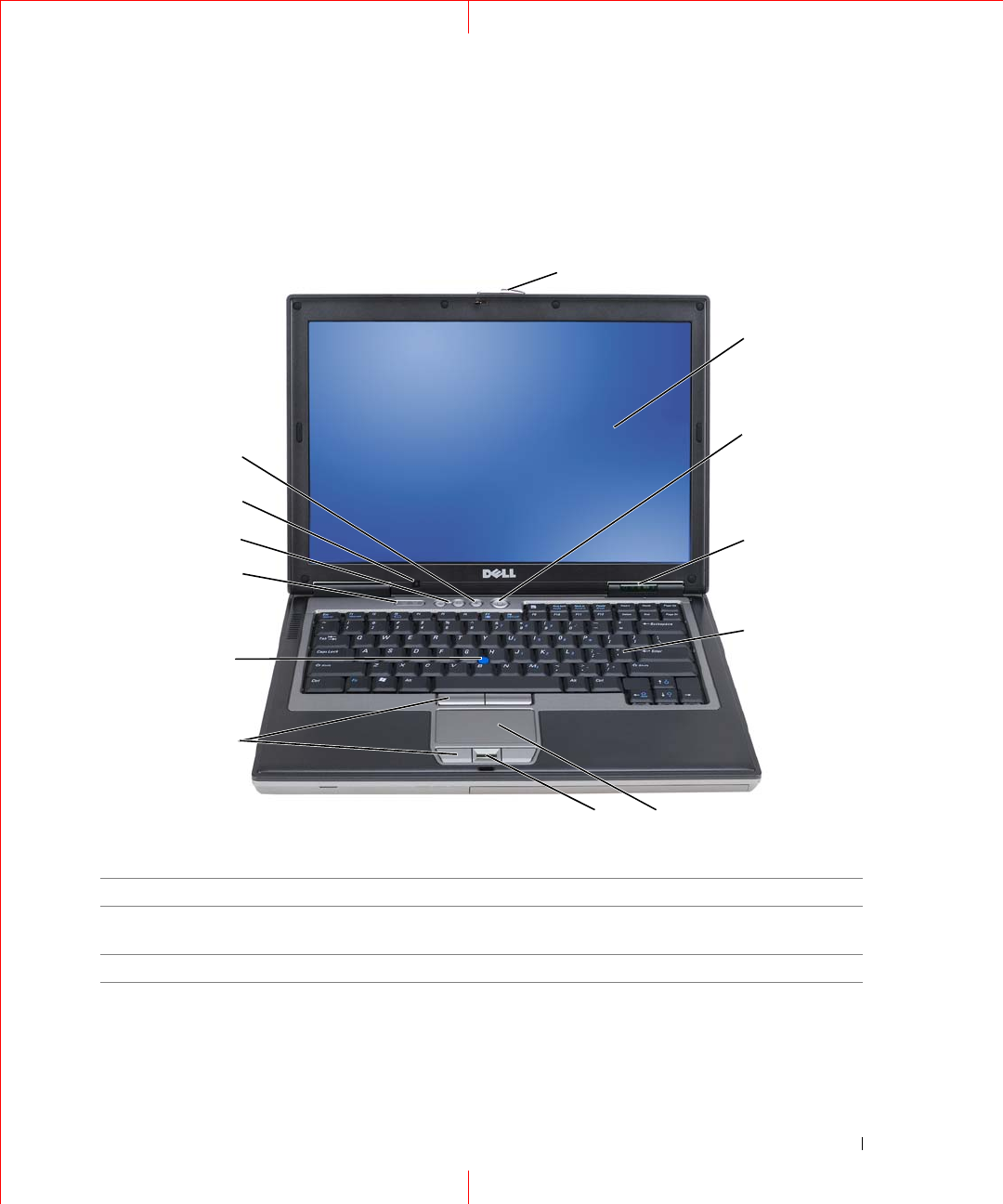
About Your Computer 15
FILE LOCATION: C:\Documents and Settings\reggie_davis\Desktop\Projects-07\BEN\Source\about.fm
DELL CONFIDENTIAL – PRELIMINARY 1/25/07 – FOR PROOF ONLY
About Your Computer
Front View
1display latch 2display 3power button
4device status lights 5keyboard 6touch pad
7fingerprint reader (optional) 8touch pad buttons/track stick
buttons
9track stick
10 keyboard status lights 11 volume control buttons 12 ambient light sensor
13 mute button
1
5
2
10
6
11 4
12
3
8
13
9
7
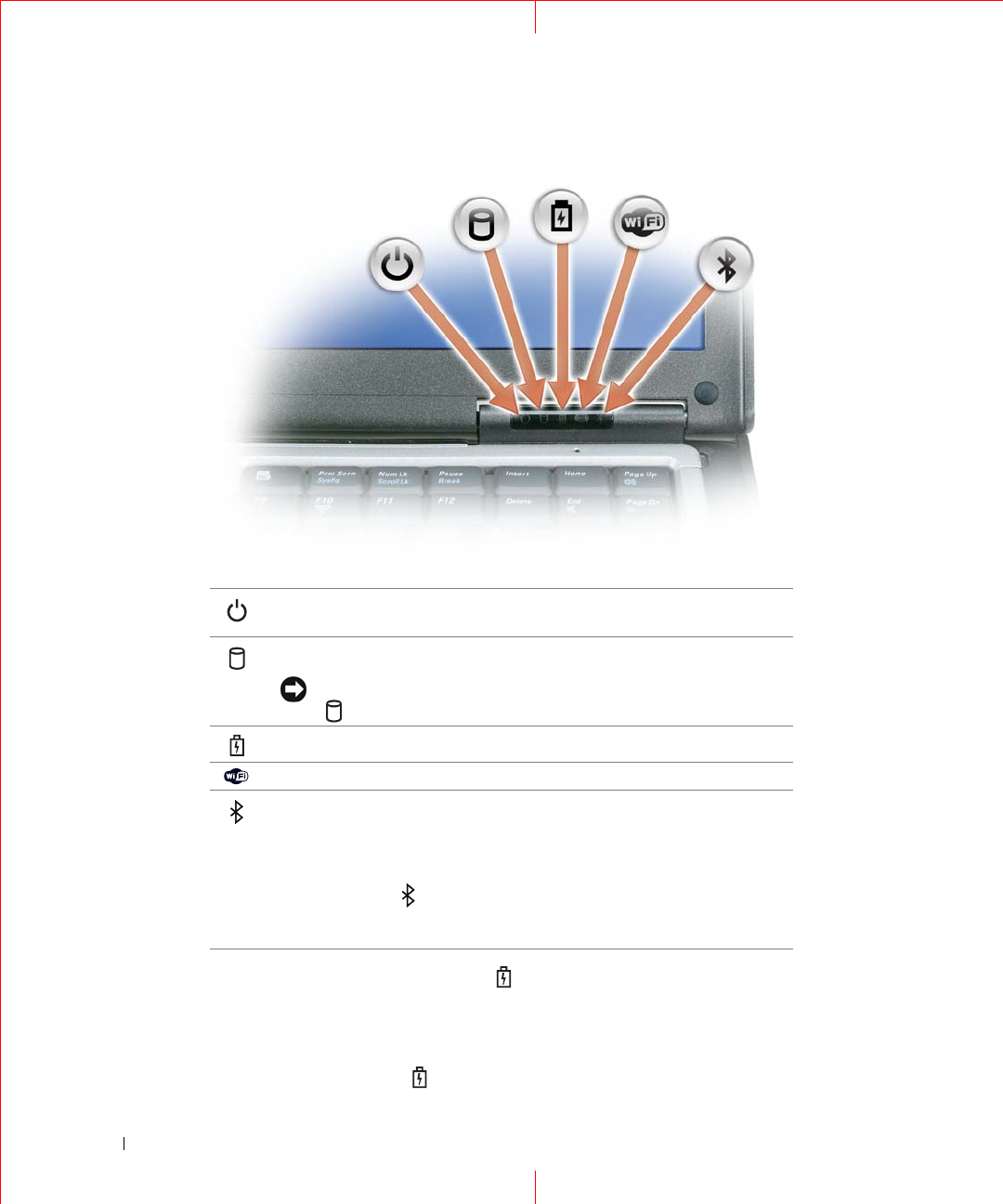
16 About Your Computer
FILE LOCATION: C:\Documents and Settings\reggie_davis\Desktop\Projects-07\BEN\Source\about.fm
DELL CONFIDENTIAL – PRELIMINARY 1/25/07 – FOR PROOF ONLY
DEVICE STATUS LIGHTS
If the computer is connected to an electrical outlet, the light operates as follows:
– Solid green: The battery is charging.
– Flashing green: The battery is almost fully charged.
– Off: The battery is adequately charged (or external power is not available to charge the battery).
If the computer is running on a battery, the light operates as follows:
Turns on when you turn on the computer and blinks when the computer is
in a power management mode.
Turns on when the computer reads or writes data.
NOTICE: To avoid loss of data, never turn off the computer while the
light is flashing.
Turns on steadily or blinks to indicate battery charge status.
Turns on when wireless devices are enabled.
Turns on when Bluetooth® wireless technology is enabled. To enable or
disable Bluetooth wireless technology, move the wireless switch to the "on"
position. See "wireless switch" on page 19 for more information.
NOTE: Bluetooth wireless technology is an optional feature on your
computer, so the icon turns on only if you ordered Bluetooth wireless
technology with your computer. For more information, see the documentation
that came with your Bluetooth wireless technology.
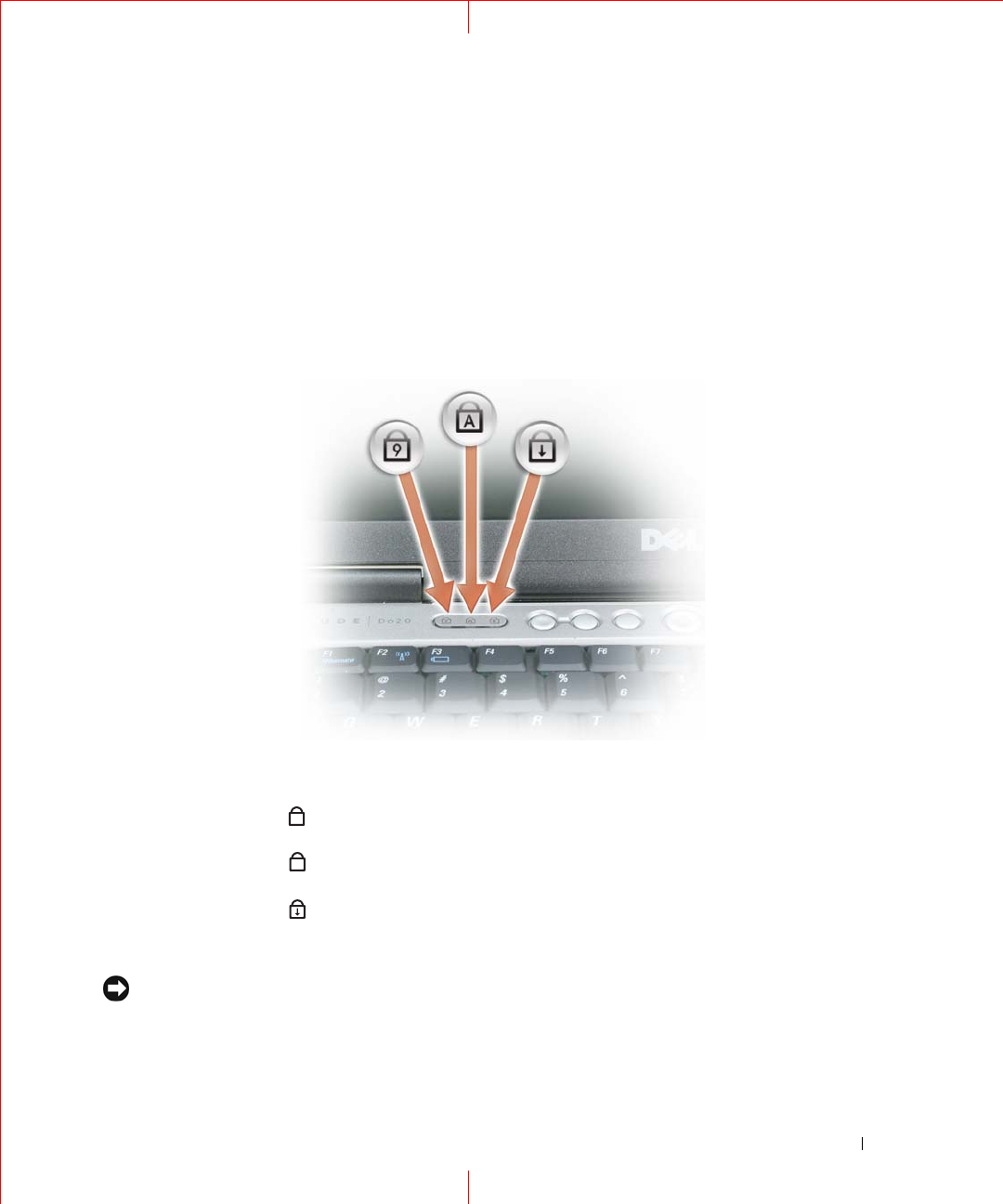
About Your Computer 17
FILE LOCATION: C:\Documents and Settings\reggie_davis\Desktop\Projects-07\BEN\Source\about.fm
DELL CONFIDENTIAL – PRELIMINARY 1/25/07 – FOR PROOF ONLY
– Off: The battery is adequately charged (or the computer is turned off).
– Flashing orange: The battery charge is low.
– Solid orange: The battery charge is critically low.
DISPLAY —For more information about your display, see "Using the Display" on page 43.
DISPLAY LATCH —Keeps the display closed.
DISPLAY LATCH BUTTON —Press this button to release the display latch and open the display.
KEYBOARD —The keyboard includes a numeric keypad as well as the Microsoft® Windows® logo key. For
information on supported keyboard shortcuts, see "Using the Keyboard" on page 39.
KEYBOARD STATUS LIGHTS
The green lights located above the keyboard indicate the following:
POWER BUTTON —Press the power button to turn on the computer or to enter or exit a power management mode.
NOTICE: To avoid losing data, shut down your computer instead of pressing the power button.
FINGERPRINT READER (OPTIONAL)—Helps to keep your Dell™ computer secure. When you slide your finger over
the reader, it uses your unique fingerprint to authenticate your user identity. For information on how to activate and
use the security management software that controls the fingerprint reader, see "Security Management Software" on
page 70.
Turns on when the numeric keypad is enabled.
Turns on when the uppercase letter function is enabled.
Turns on when the scroll lock function is enabled.
9
A
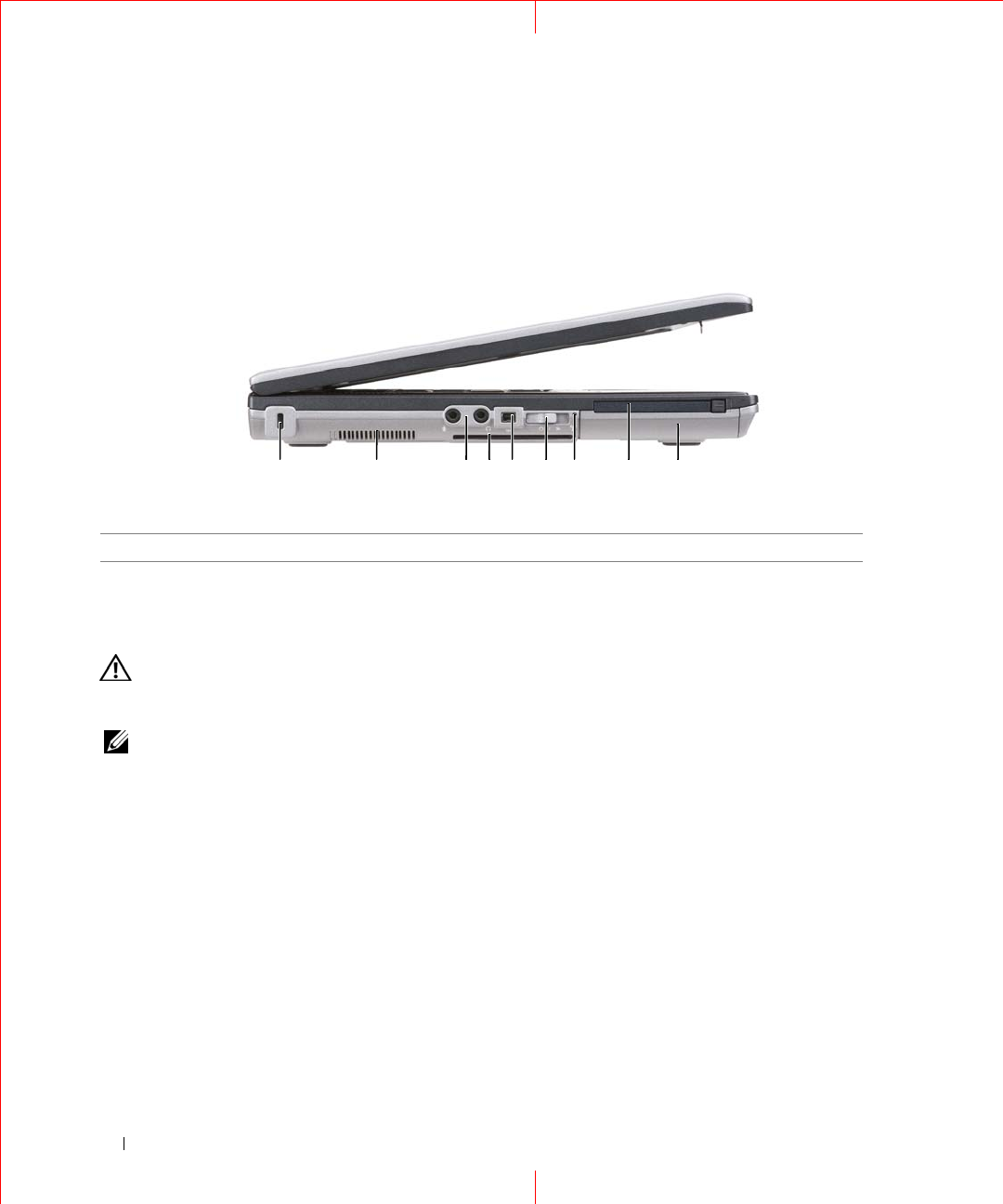
18 About Your Computer
FILE LOCATION: C:\Documents and Settings\reggie_davis\Desktop\Projects-07\BEN\Source\about.fm
DELL CONFIDENTIAL – PRELIMINARY 1/25/07 – FOR PROOF ONLY
AMBIENT LIGHT SENSOR —Detects available environmental light and automatically increases or decreases the
display backlighting to compensate for low-light and high-light environments. Press the <Fn> and left-arrow keys to
enable or disable the sensor ("Using the Ambient Light Sensor" on page 43).
Left Side View
AIR VENTS —The computer uses an internal fan to create airflow through the vents, which prevents the computer
from overheating.
CAUTION: Do not block, push objects into, or allow dust to accumulate in the air vents. Do not store your Dell
computer in a low-airflow environment, such as a closed briefcase, while it is running. Restricting the airflow
can damage the computer or cause a fire.
NOTE: The computer turns on the fan when the computer gets hot. Fan noise is normal and does not indicate a
problem with the fan or the computer.
SECURITY CABLE SLOT —Lets you attach a commercially available antitheft device to the computer (see "Security
Cable Lock" on page 65).
1security cable slot 2air vents 3audio connectors (2)
4smart card slot (with blank) 51394 connector 6wireless switch
7Wi-Fi Catcher™ light 8PC Card slot 9hard drive
1 2 3 65 7 84 9
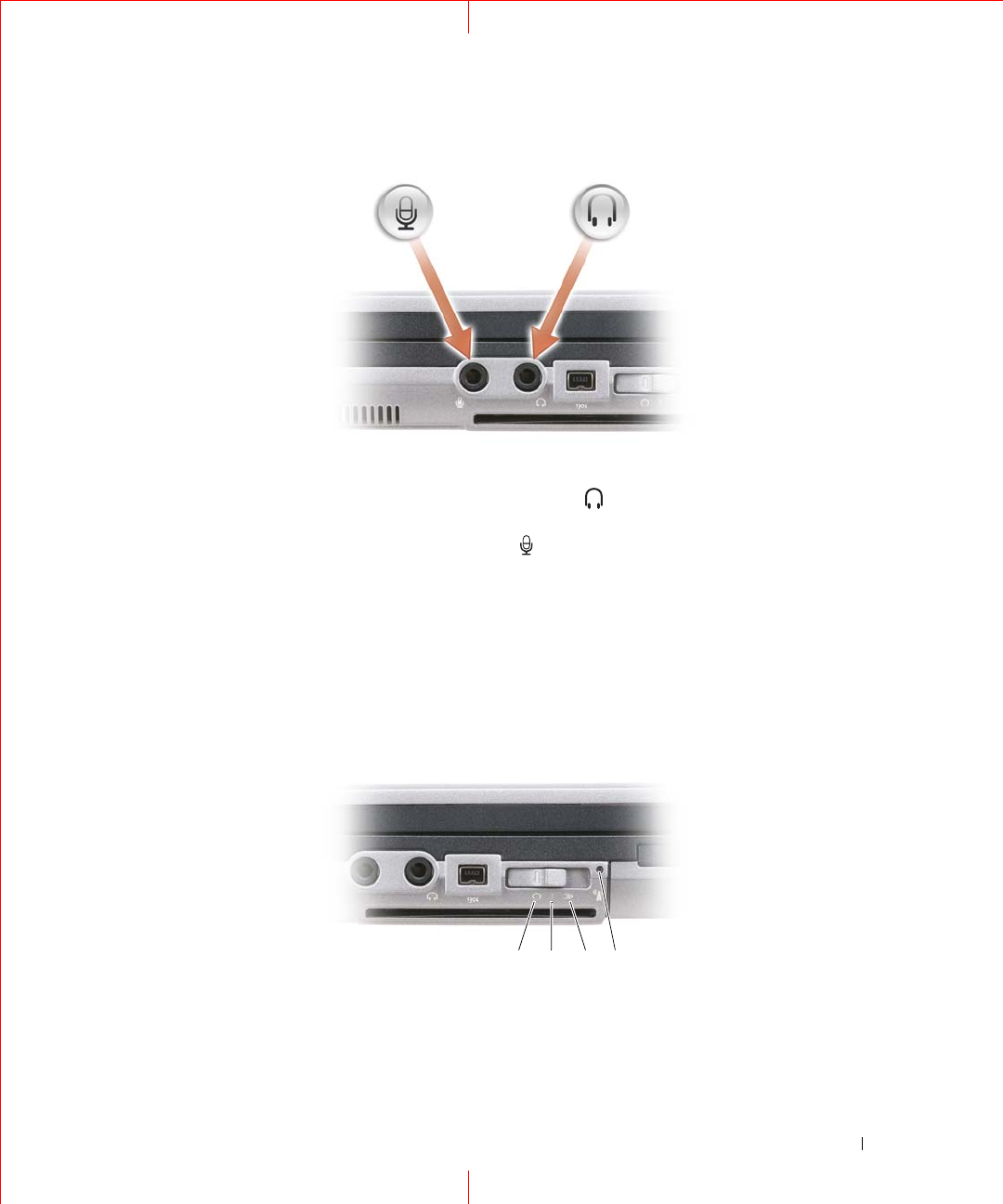
About Your Computer 19
FILE LOCATION: C:\Documents and Settings\reggie_davis\Desktop\Projects-07\BEN\Source\about.fm
DELL CONFIDENTIAL – PRELIMINARY 1/25/07 – FOR PROOF ONLY
AUDIO CONNECTORS
SMART CARD SLOT (WITH BLANK)—Supports one smart card. Smart cards provide a variety of functions,
including security features and data storage. The blank prevents foreign matter from entering the interior of the
computer when a smart card is not installed in the smart card slot. For more information and instructions on
removing the blank, see "Smart Cards" on page 61.
WIRELESS SWITCH —When enabled through Dell QuickSet, this switch can scan for a wireless LAN (WLAN) in
your vicinity. You can also use it to rapidly turn off or on any wireless devices such as WLAN cards and internal cards
with Bluetooth wireless technology (see "Dell Wi-Fi Catcher™ Network Locator" on page 54).
Attach headphones or speakers to the connector.
Attach a microphone to the connector.
1 2 3 4
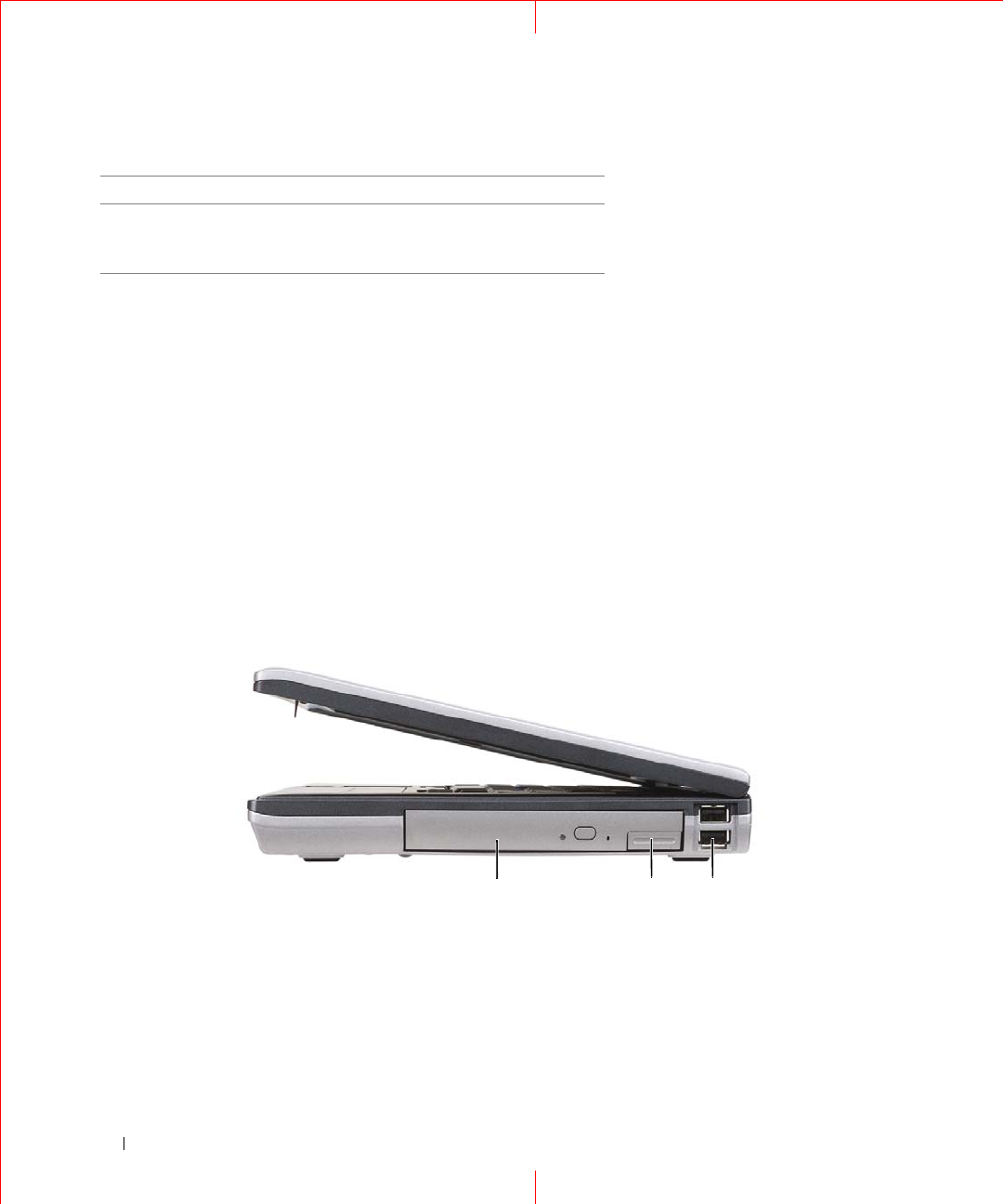
20 About Your Computer
FILE LOCATION: C:\Documents and Settings\reggie_davis\Desktop\Projects-07\BEN\Source\about.fm
DELL CONFIDENTIAL – PRELIMINARY 1/25/07 – FOR PROOF ONLY
WI-FI CATCHER™ LIGHT —The light operates as follows:
– Flashing green: Searching for networks
– Solid green: Strong network found
– Solid yellow:
Weak network found
– Flashing yellow: Error
– Off: No signal found
PC CARD SLOT —Supports one PC Card, such as a modem or network adapter. The computer ships with a blank
installed in the slot to prevent foreign matter from entering the computer interior when a card is not installed (see
"Card Types" on page 61).
HARD DRIVE —Stores software and data.
Right Side View
MEDIA BAY —Supports a floppy or an optical drive, second battery, second hard drive, or a Dell TravelLite™
module (see "Using Multimedia" on page 55).
DEVICE LATCH RELEASE —Press the latch release to eject any device installed in the media bay.
1"off" position Disables wireless devices
2"on" position Enables wireless devices
3"momentary" position Scans for WLAN networks (see
"Dell Wi-Fi Catcher™ Network
Locator" on page 54)
4Wi-Fi Catcher light
1optical drive in media bay 2media-bay device latch release 3USB connectors (2)
12 3
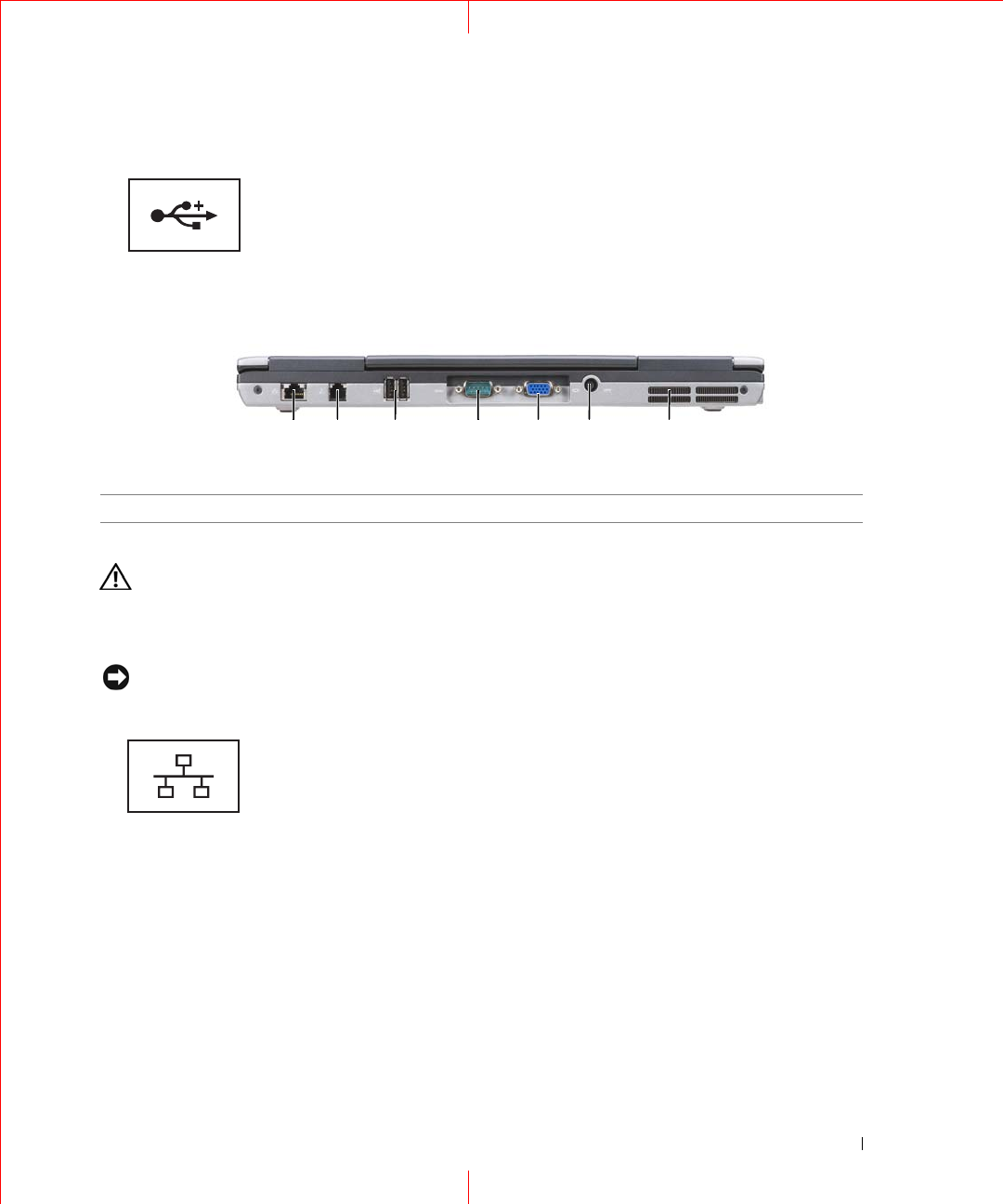
About Your Computer 21
FILE LOCATION: C:\Documents and Settings\reggie_davis\Desktop\Projects-07\BEN\Source\about.fm
DELL CONFIDENTIAL – PRELIMINARY 1/25/07 – FOR PROOF ONLY
USB CONNECTORS
Back View
CAUTION: Do not block, push objects into, or allow dust to accumulate in the air vents. Do not store your
computer in a low-airflow environment, such as a closed briefcase, while it is running. Restricting the airflow
can damage the computer or cause a fire.
NETWORK CONNECTOR (RJ-45)
NOTICE: The network connector is slightly larger than the modem connector. To avoid damaging the computer, do
not plug a telephone line into the network connector.
Connect USB devices, such as a mouse, keyboard, or printer.
1network connector (RJ-45) 2modem connector (RJ-11) 3USB connectors (2)
4serial connector 5video connector 6AC adapter connector
7air vents
Connects the computer to a network. The two lights next to
the connector indicate status and activity for wired network
connections.
For information on using the network adapter, see the device
user’s guide supplied with your computer.
1 2 63 4 75
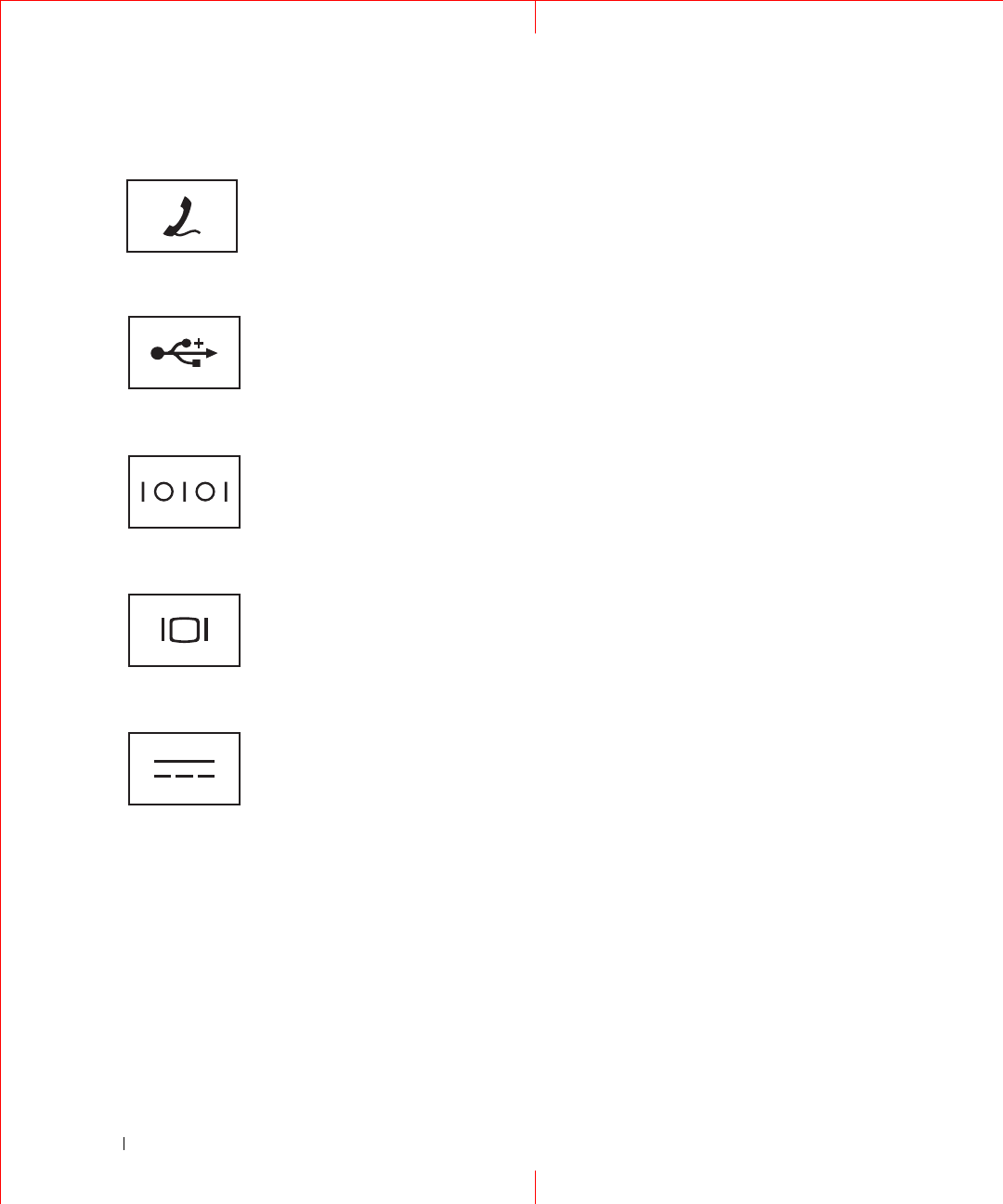
22 About Your Computer
FILE LOCATION: C:\Documents and Settings\reggie_davis\Desktop\Projects-07\BEN\Source\about.fm
DELL CONFIDENTIAL – PRELIMINARY 1/25/07 – FOR PROOF ONLY
MODEM CONNECTOR (RJ-11)
USB CONNECTORS
SERIAL CONNECTOR
VIDEO CONNECTOR
AC ADAPTER CONNECTOR
Connect the telephone line to the modem connector.
For information on using the modem, see the online modem
documentation supplied with your computer (see "Finding
Information" on page 11).
Connects USB devices, such as a mouse, keyboard, or
printer.
Connects serial devices, such as a mouse or handheld device.
Connects video devices, such as a monitor.
Connects an AC adapter to the computer.
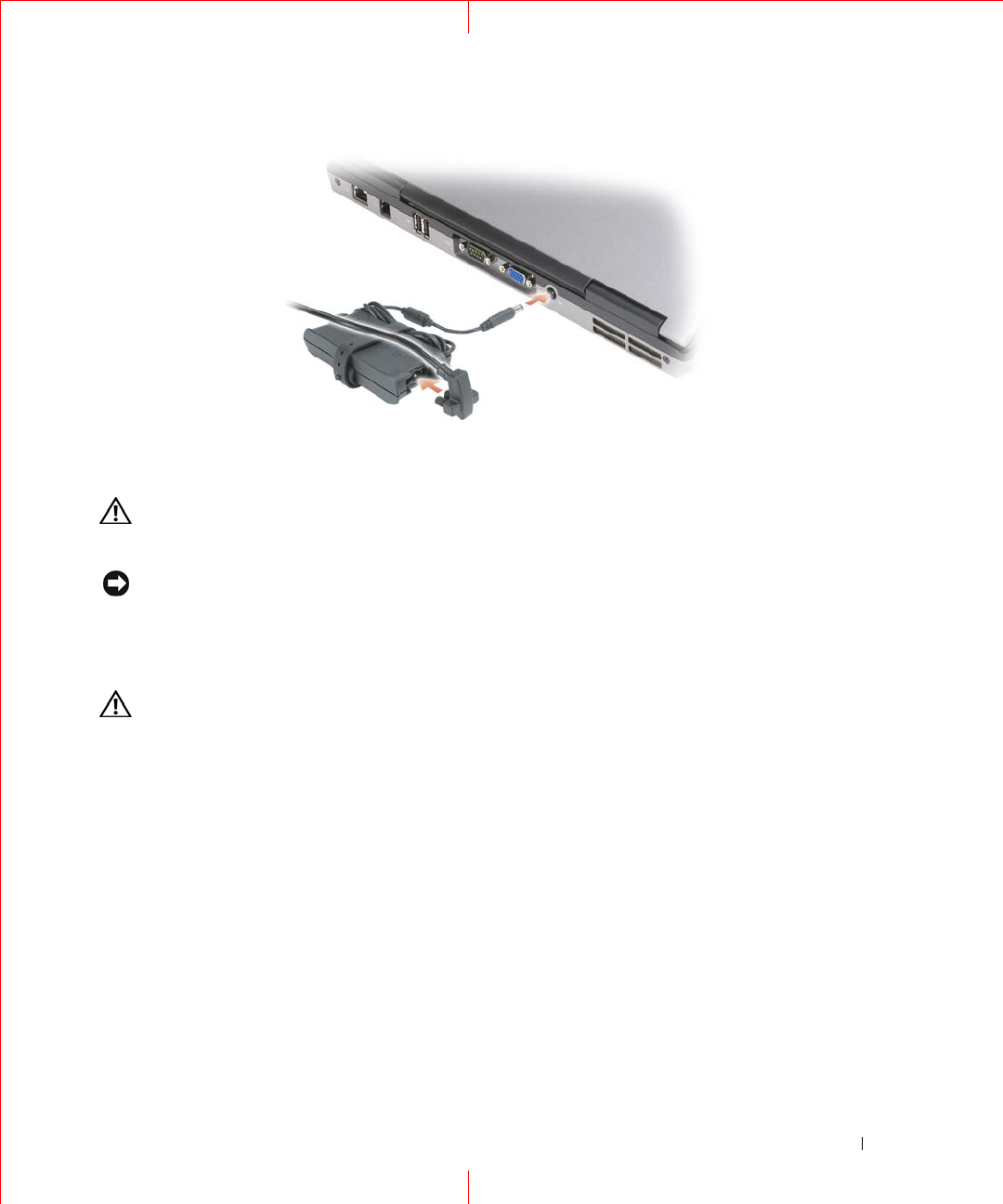
About Your Computer 23
FILE LOCATION: C:\Documents and Settings\reggie_davis\Desktop\Projects-07\BEN\Source\about.fm
DELL CONFIDENTIAL – PRELIMINARY 1/25/07 – FOR PROOF ONLY
The AC adapter converts AC power to the DC power required by the computer. You can connect the AC adapter
with your computer turned either on or off.
CAUTION: The AC adapter works with electrical outlets worldwide. However, power connectors and power
strips vary among countries. Using an incompatible cable or improperly connecting the cable to the power strip
or electrical outlet may cause fire or equipment damage.
NOTICE: When you disconnect the AC adapter cable from the computer, grasp the connector, not the cable itself,
and pull firmly but gently to avoid damaging the cable. When you wrap the AC adapter cable, ensure that you follow
the angle of the connector on the AC adapter to avoid damaging the cable.
AIR VENTS —The computer uses an internal fan to create airflow through the vents, which prevents the computer
from overheating.
CAUTION: Do not block, push objects into, or allow dust to accumulate in the air vents. Do not store your
computer in a low-airflow environment, such as a closed briefcase, while it is running. Restricting the airflow
can damage the computer or cause a fire.
1
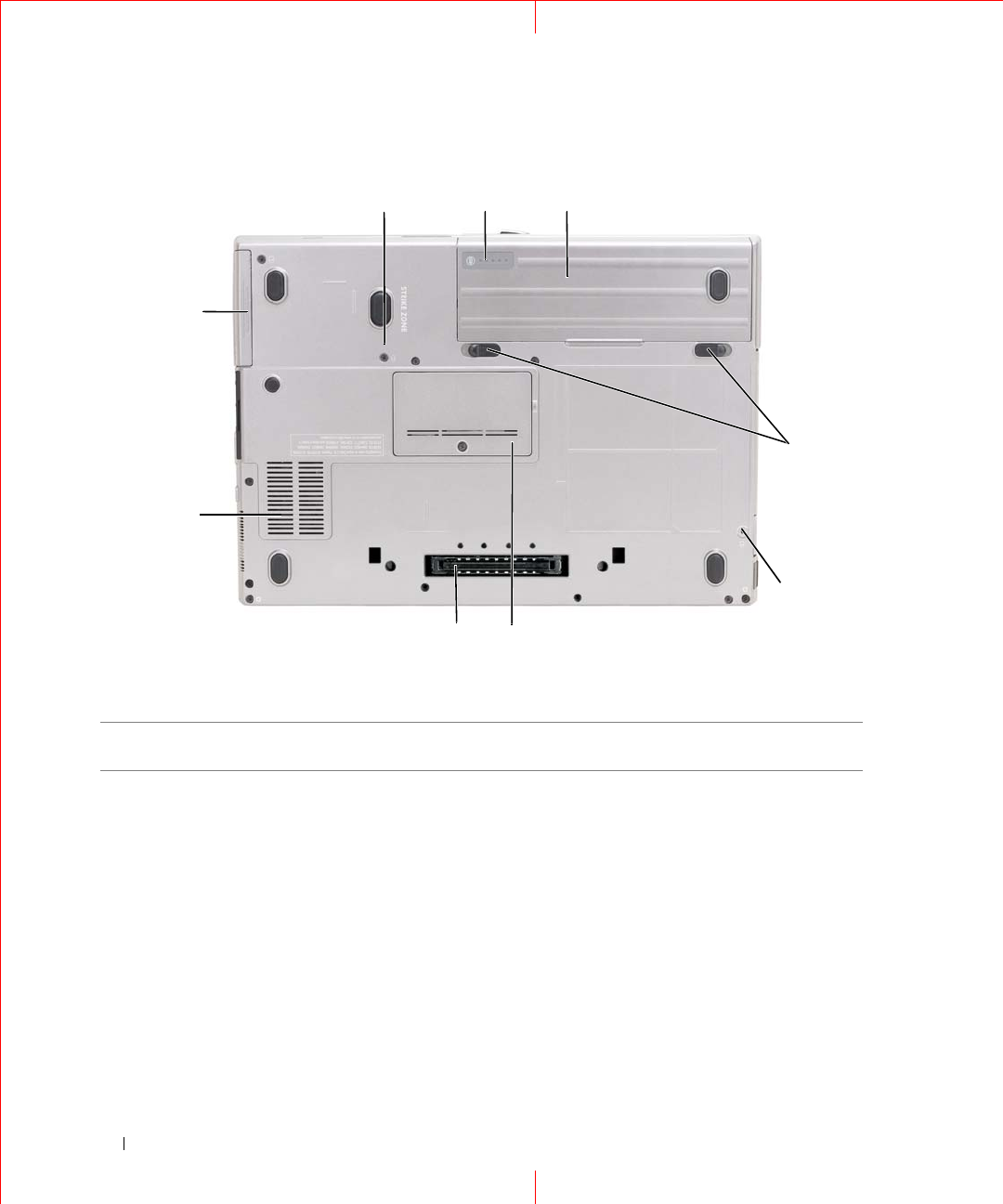
24 About Your Computer
FILE LOCATION: C:\Documents and Settings\reggie_davis\Desktop\Projects-07\BEN\Source\about.fm
DELL CONFIDENTIAL – PRELIMINARY 1/25/07 – FOR PROOF ONLY
Bottom View
BATTERY CHARGE GAUGE/HEALTH GAUGE —Provides information on the battery charge (see "Checking the
Battery Charge" on page 34).
BATTERY —When a battery is installed, you can use the computer without connecting the computer to an
electrical outlet (see "Using a Battery" on page 33).
BATTERY-BAY LATCH RELEASES —Releases the battery (see "Replacing the Battery" on page 37 for instructions).
DEVICE LOCKING SCREW —If present, locks devices, such as an optical drive, in place.
DOCKING-DEVICE CONNECTOR —Lets you attach your computer to a docking device. See the Dell documentation
that came with your docking device for more information.
MEMORY MODULE COVER —Covers the compartment that contains the second memory module connector
(DIMM B) (see "Memory" on page 115).
1battery charge gauge/health
gauge
2battery 3battery-bay latch releases (2)
4device locking screw (if
present)
5memory module cover 6docking-device connector
7air vents 8hard drive 9device locking screw
7
6
1
5
2
8
3
4
9

About Your Computer 25
FILE LOCATION: C:\Documents and Settings\reggie_davis\Desktop\Projects-07\BEN\Source\about.fm
DELL CONFIDENTIAL – PRELIMINARY 1/25/07 – FOR PROOF ONLY
AIR VENTS —The computer uses an internal fan to create airflow through the fan air vents, which prevents the
computer from overheating.

26 About Your Computer
FILE LOCATION: C:\Documents and Settings\reggie_davis\Desktop\Projects-07\BEN\Source\about.fm
DELL CONFIDENTIAL – PRELIMINARY 1/25/07 – FOR PROOF ONLY

Transferring Information to a New Computer 27
FILE LOCATION: C:\Documents and Settings\reggie_davis\Desktop\Projects-07\BEN\Source\transfer.fm
DELL CONFIDENTIAL – PRELIMINARY 1/25/07 – FOR PROOF ONLY
Transferring Information to a New Computer
You can use your operating system wizards to help you transfer files and other data from one computer
another. For instructions, see the following section that corresponds to the operating system your
computer is running.
Microsoft® Windows® XP
The Microsoft Windows XP operating system provides the Files and Settings Transfer wizard to move
data from a source computer to a new computer. You can transfer data such as:
• E-mail messages
• Toolbar settings
•Window sizes
• Internet bookmarks
You can transfer the data to the new computer over a network, serial connection, or on removable media
such as a writable CD.
NOTE: You can transfer information from the old computer to the new computer by directly connecting a serial
cable to the input/output (I/O) ports of the two computers. To transfer data over a serial connection, you must
access the Network Connections utility from the Control Panel and perform additional configuration steps, such as
setting up an advanced connection and designating the host computer and the guest computer.
For instructions on setting up a direct cable connection between two computers, see Microsoft Knowledge Base
87uArticle #305621, titled How to Set Up a Direct Cable Connection Between Two Computers in Windows XP. This
information may not be available in some countries.
For transferring information to a new computer, you must run the Files and Settings Transfer Wizard.
You can use the optional Operating System media for this process or you can create a wizard disk with the
Files and Settings Transfer Wizard.
Running the Files and Settings Transfer Wizard With the Operating System Media
NOTE: This procedure requires the Operating System media. This media is optional and may not be included with
all computers.
To prepare the new computer for the file transfer:
1
Start the
Files and Settings Transfer Wizard.
2
When the
Files and Settings Transfer Wizard
welcome screen appears, click
Next
.
3
On the
Which computer is this?
screen, click
New Computer
and click
Next
.
4
On the
Do you have a Windows XP CD?
screen, click
I will use the wizard from the Windows XP CD
and click
Next
.

28 Transferring Information to a New Computer
FILE LOCATION: C:\Documents and Settings\reggie_davis\Desktop\Projects-07\BEN\Source\transfer.fm
DELL CONFIDENTIAL – PRELIMINARY 1/25/07 – FOR PROOF ONLY
5
When the
Now go to your old computer
screen appears, go to your old or source computer. Do
not
click
Next
at this time.
To copy data from the old computer:
1
On the old computer, insert the Windows XP
Operating System
media.
2
On the
Welcome to Microsoft Windows XP
screen, click
Perform additional tasks
.
3
Under
What do you want to do?
, click
Transfer files and settings
.
4
On the
Files and Settings Transfer Wizard
welcome screen, click
Next
.
5
On the
Which computer is this?
screen, click
Old Computer
and click
Next
.
6
On the
Select a transfer method
screen, click the transfer method you prefer.
7
On the
What do you want to transfer?
screen, select the items you want to transfer and click
Next
.
After the information has been copied, the
Completing the Collection Phase
screen appears.
8
Click
Finish
.
To transfer data to the new computer:
1
On the
Now go to your old computer
screen on the new computer, click
Next
.
2
On the
Where are the files and settings?
screen, select the method you chose for transferring your
settings and files and click
Next
.
The wizard reads the collected files and settings and applies them to your new computer.
When all of the settings and files have been applied, the
Finished
screen appears.
3
Click
Finished
and restart the new computer.
Running the Files and Settings Transfer Wizard Without the Operating System Media
To run the Files and Settings Transfer Wizard without the Operating System media, you must create a
wizard disk that will allow you to create a backup image file to removable media.
To create a wizard disk, use your new computer with Windows XP and perform the following steps:
1
Click
Start
→
Files and Settings Transfer Wizard
.
2
When the
Files and Settings Transfer Wizard
welcome screen appears, click
Next
.
3
On the
Which computer is this?
screen, click
New Computer
→
Next
.
4
On the
Do you have a Windows XP CD?
screen, click
I want to create a Wizard Disk in the following
drive
→
Next.
5
Insert the removable media, such as a writable CD, and click
OK
.
6
When the disk creation completes and the
Now go to your old computer
message appears,
do not
click
Next
.
7
Go to the old computer.
To copy data from the old computer:

Transferring Information to a New Computer 29
FILE LOCATION: C:\Documents and Settings\reggie_davis\Desktop\Projects-07\BEN\Source\transfer.fm
DELL CONFIDENTIAL – PRELIMINARY 1/25/07 – FOR PROOF ONLY
1
On the old computer, insert the wizard disk.
2
Click the
Start
→
Run
.
3
In the
Open
field on the
Run
window, browse to the path for
fastwiz
(on the appropriate removable
media) and click
OK
.
4
On the
Files and Settings Transfer Wizard
welcome screen, click
Next
.
5
On the
Which computer is this?
screen, click
Old Computer
→
Next
.
6
On the
Select a transfer method
screen, click the transfer method you prefer.
7
On the
What do you want to transfer?
screen, select the items you want to transfer and click
Next
.
After the information has been copied, the
Completing the Collection Phase
screen appears.
8
Click
Finish
.
To transfer data to the new computer:
1
On the
Now go to your old computer
screen on the new computer, click
Next
.
2
On the
Where are the files and settings?
screen, select the method you chose for transferring your
settings and files and click
Next
. Follow the instructions on the screen.
The wizard reads the collected files and settings and applies them to your new computer.
When all of the settings and files have been applied, the
Finished
screen appears.
3
Click
Finished
and restart the new computer.
NOTE: For more information about this procedure, search support.dell.com for document #PA1089586 (How Do I
Transfer Files From My Old Computer to My New Dell Computer Using the Microsoft® Windows® XP Operating
System?).
NOTE: Access to the Dell™ Knowledge Base document may not be available in some countries.
Microsoft Windows Vista™
Easy Transfer Cable for Windows Vista
1
Insert the Easy Transfer Cable for Windows Vista Application Software media into the computer you
are transferring data from.
2
Follow the on-screen instructions until you are prompted to connect the Transfer Cable.
3
Connect the Easy Transfer Cable to the source computer.
You are prompted to select a device option.
4
Continue until you are prompted to plug the other end of the Easy Transfer Cable into the destination
computer.
The screen indicates that a connection has been made.

30 Transferring Information to a New Computer
FILE LOCATION: C:\Documents and Settings\reggie_davis\Desktop\Projects-07\BEN\Source\transfer.fm
DELL CONFIDENTIAL – PRELIMINARY 1/25/07 – FOR PROOF ONLY
5
At the computer you are transferring data from, follow the on-screen instructions to select the settings
and files you want to transfer.
6
You will come to a screen that indicates you are ready to transfer files.
7
From the destination computer, view the transfer and wait for the indication that the transfer is
complete.
8
Select
Close
.
You are prompted to restart the computer.

Transferring Information to a New Computer 31
FILE LOCATION: C:\Documents and Settings\reggie_davis\Desktop\Projects-07\BEN\Source\transfer.fm
DELL CONFIDENTIAL – PRELIMINARY 1/25/07 – FOR PROOF ONLY
9
Select
Yes
.
The computer reboots and the transfer is complete.

32 Transferring Information to a New Computer
FILE LOCATION: C:\Documents and Settings\reggie_davis\Desktop\Projects-07\BEN\Source\transfer.fm
DELL CONFIDENTIAL – PRELIMINARY 1/25/07 – FOR PROOF ONLY

Using a Battery 33
FILE LOCATION: C:\Documents and Settings\reggie_davis\Desktop\Projects-07\BEN\Source\battery.fm
DELL CONFIDENTIAL – PRELIMINARY 1/25/07 – FOR PROOF ONLY
Using a Battery
Battery Performance
NOTE: For information about the Dell warranty for your computer, see the Product Information Guide or separate
paper warranty document that shipped with your computer.
For optimal computer performance and to help preserve BIOS settings, operate your Dell™ portable
computer with the main battery installed at all times. One battery is supplied as standard equipment in
the battery bay.
NOTE: Because the battery may not be fully charged, use the AC adapter to connect your new computer to an
electrical outlet the first time you use the computer. For best results, operate the computer with the AC adapter
until the battery is fully charged. To view battery charge status, check the Power Meter in Power Options (see
"Accessing Power Options Properties" on page 37).
Battery operating time varies depending on operating conditions. You can install an optional second
battery in the media bay to significantly increase operating time.
NOTE: Battery operating time (the time the battery can hold a charge) decreases over time. Depending on how
often the battery is used and the conditions under which it is used, you may need to purchase a new battery during
the life of your computer.
NOTE: It is recommended that you connect your computer to an electrical outlet when writing to a CD or DVD.
Operating time is significantly reduced when you perform operations including, but not limited to, the
following:
•Using optical drives.
• Using wireless communications devices, PC Cards, media memory cards, or USB devices.
• Using high-brightness display settings, 3D screen savers, or other power-intensive programs such as
complex 3D graphics applications.
• Running the computer in maximum performance mode. See "Configuring Power Management
Settings" on page 36 for information about accessing Windows Power Options Properties or Dell
QuickSet, which you can use to configure power management settings.
You can check the battery charge before you insert the battery into the computer. You can also set power
management options to alert you when the battery charge is low.
CAUTION: Using an incompatible battery may increase the risk of fire or explosion. Replace the battery only
with a compatible battery purchased from Dell. The battery is designed to work with your Dell computer. Do not
use a battery from other computers with your computer.
CAUTION: Do not dispose of batteries with household waste. When your battery no longer holds a charge, call
your local waste disposal or environmental agency for advice on disposing of a lithium-ion battery. See "Battery
Disposal" in the
Product Information Guide
.

34 Using a Battery
FILE LOCATION: C:\Documents and Settings\reggie_davis\Desktop\Projects-07\BEN\Source\battery.fm
DELL CONFIDENTIAL – PRELIMINARY 1/25/07 – FOR PROOF ONLY
CAUTION: Misuse of the battery may increase the risk of fire or chemical burn. Do not puncture, incinerate,
disassemble, or expose the battery to temperatures above 65°C (149°F). Keep the battery away from children.
Handle damaged or leaking batteries with extreme care. Damaged batteries may leak and cause personal injury
or equipment damage.
Checking the Battery Charge
The Dell QuickSet Battery Meter, the Microsoft Windows Power Meter window and icon, the
battery charge gauge and health gauge, and the low-battery warning provide information on the battery
charge.
Dell™ QuickSet Battery Meter
If Dell QuickSet is installed, press <Fn><F3> to display the QuickSet Battery Meter. The Battery
Meter displays status, battery health, charge level, and charge completion time for the battery in your
computer.
For more information about QuickSet, right-click the QuickSet icon in the taskbar, and click Help.
Microsoft® Windows® Power Meter
The Windows Power Meter indicates the remaining battery charge. To check the Power Meter, double-
click the icon on the taskbar.
If the computer is connected to an electrical outlet, a icon appears.
Charge Gauge
By either pressing once or pressing and holding the status button on the charge gauge on the battery, you
can check:
• Battery charge (check by pressing and
releasing
the status button)
• Battery health (check by pressing and
holding
the status button)
The battery operating time is largely determined by the number of times it is charged. After hundreds of
charge and discharge cycles, batteries lose some charge capacity—or battery health. That is, a battery can
show a status of "charged" but maintain a reduced charge capacity (health).
Check the Battery Charge
To check the battery charge, press and release the status button on the battery charge gauge to illuminate
the charge-level lights. Each light represents approximately 20 percent of the total battery charge. For
example, if the battery has 80 percent of its charge remaining, four of the lights are on. If no lights
appear, the battery has no charge.

Using a Battery 35
FILE LOCATION: C:\Documents and Settings\reggie_davis\Desktop\Projects-07\BEN\Source\battery.fm
DELL CONFIDENTIAL – PRELIMINARY 1/25/07 – FOR PROOF ONLY
Check the Battery Health
NOTE: You can check battery health in one of two ways: by using the charge gauge on the battery as described
below and by using the Battery Meter in Dell QuickSet. For information about QuickSet, right-click the icon in the
taskbar, and click Help.
To check the battery health using the charge gauge, press and hold the status button on the battery
charge gauge for at least 3 seconds. If no lights appear, the battery is in good condition, and more than 80
percent of its original charge capacity remains. Each light represents incremental degradation. If five
lights appear, less than 60 percent of the charge capacity remains, and you should consider replacing the
battery. See "Charge Gauge" on page 34 for more information about the battery operating time.
Low-Battery Warning
NOTICE: To avoid losing or corrupting data, save your work immediately after a low-battery warning. Then
connect the computer to an electrical outlet, or install a second battery in the media bay. If the battery runs
completely out of power, hibernate mode begins automatically.
A pop-up window warns you when the battery charge is approximately 90 percent depleted. If two
batteries are installed, the low-battery warning means that the combined charge of both batteries is
approximately 90 percent depleted. The computer enters hibernate mode when the battery charge is at a
critically low level.
You can change the settings for the battery alarms in QuickSet or the Power Options Properties window.
See "Configuring Power Management Settings" on page 36 for information about accessing QuickSet or
the Power Options Properties window.
Conserving Battery Power
Perform the following actions to conserve battery power:
• Connect the computer to an electrical outlet when possible because battery life is largely determined
by the number of times the battery is used and recharged.
• Place the computer in standby mode or hibernate mode when you leave the computer unattended for
long periods of time. See "Power Management Modes" on page 35.
• Use the Power Management Wizard or the
Power Options Properties
window to select options to
optimize your computer’s power usage. These options can also be set to change when you press the
power button, close the display, or press <Fn><Esc>.
NOTE: See "Configuring Power Management Settings" on page 36 for information on conserving battery power.

36 Using a Battery
FILE LOCATION: C:\Documents and Settings\reggie_davis\Desktop\Projects-07\BEN\Source\battery.fm
DELL CONFIDENTIAL – PRELIMINARY 1/25/07 – FOR PROOF ONLY
Power Management Modes
Standby and Sleep Mode
Standby mode (sleep mode in Microsoft Windows Vista™) conserves power by turning off the display
and the hard drive after a predetermined period of inactivity (a time-out). When the computer exits
standby or sleep mode, it returns to the same operating state it was in before entering standby or sleep
mode.
NOTICE: If your computer loses AC and battery power while in standby or sleep mode, it may lose data.
To enter standby mode in Windows XP, click the Start button, click Turn off computer, and then click
Stand by.
To enter sleep mode in Windows Vista, click the Windows Vista Start button, , and then click Sleep.
Depending on how you set the power management options in the Power Options Properties window or
the QuickSet Power Management Wizard, you may also use one of the following methods:
• Press the power button.
• Close the display.
• Press <Fn><Esc>.
To exit standby or sleep mode, press the power button or open the display, depending on how you set the
power management options. You cannot make the computer exit standby or sleep mode by pressing a key
or touching the touch pad or track stick.
Hibernate Mode
Hibernate mode conserves power by copying system data to a reserved area on the hard drive and then
completely turning off the computer. When the computer exits hibernate mode, it returns to the same
operating state it was in before entering hibernate mode.
NOTICE: You cannot remove devices or undock your computer while your computer is in hibernate mode.
Your computer enters hibernate mode if the battery charge level becomes critically low.
To manually enter hibernate mode in Windows XP, click Start→ Turn off computer, press and hold
<Shift>, and click Hibernate.
For information about the hibernate mode in Windows Vista, search for the keyword hibernate in
Windows Help and Support (click Start→ Help and Support).
Depending on how you set the power management options in the Power Options Properties window or
the QuickSet Power Management Wizard, you may also use one of the following methods to enter
hibernate mode:
• Press the power button.
• Close the display.
• Press <Fn><F1>.

Using a Battery 37
FILE LOCATION: C:\Documents and Settings\reggie_davis\Desktop\Projects-07\BEN\Source\battery.fm
DELL CONFIDENTIAL – PRELIMINARY 1/25/07 – FOR PROOF ONLY
NOTE: Some PC Cards may not operate correctly after the computer exits hibernate mode. Remove and reinsert
the card (see "Removing a Card or Blank" on page 62), or simply restart (reboot) your computer.
To exit hibernate mode, press the power button. The computer may take a short time to exit hibernate
mode. You cannot make the computer exit hibernate mode by pressing a key or touching the touch pad
or track stick. For more information on hibernate mode, see the documentation that came with your
operating system.
Configuring Power Management Settings
You can use the QuickSet Power Management Wizard or Windows Power Options Properties to
configure the power management settings on your computer. For more information about QuickSet,
right-click the QuickSet icon in the taskbar and click Help.
Accessing Power Options Properties
Windows XP
Click Start→ Control Panel→ Performance and Maintenance→ Power Options.
Windows Vista
Click Start→ Control Panel→ System and Maintenance→ Power Options.
Charging the Battery
When you connect the computer to an electrical outlet or install a battery while the computer is
connected to an electrical outlet, the computer checks the battery charge and temperature. If necessary,
the AC adapter then charges the battery and maintains the battery charge.
NOTE: With Dell™ ExpressCharge™, when the computer is turned off, the AC adapter charges a completely
discharged battery to 80 percent in about 1 hour and to 100 percent in approximately 2 hours. Charge time is longer
with the computer turned on. You can leave the battery in the computer for as long as you like. The battery’s internal
circuitry prevents the battery from overcharging.
If the battery is hot from being used in your computer or being in a hot environment, the battery may
not charge when you connect the computer to an electrical outlet.
The battery is too hot to start charging if the light flashes alternately green and orange. Disconnect
the computer from the electrical outlet and allow the computer and the battery to cool to room
temperature. Then connect the computer to an electrical outlet to continue charging the battery.
For information about resolving problems with a battery, see "Power Problems" on page 90.
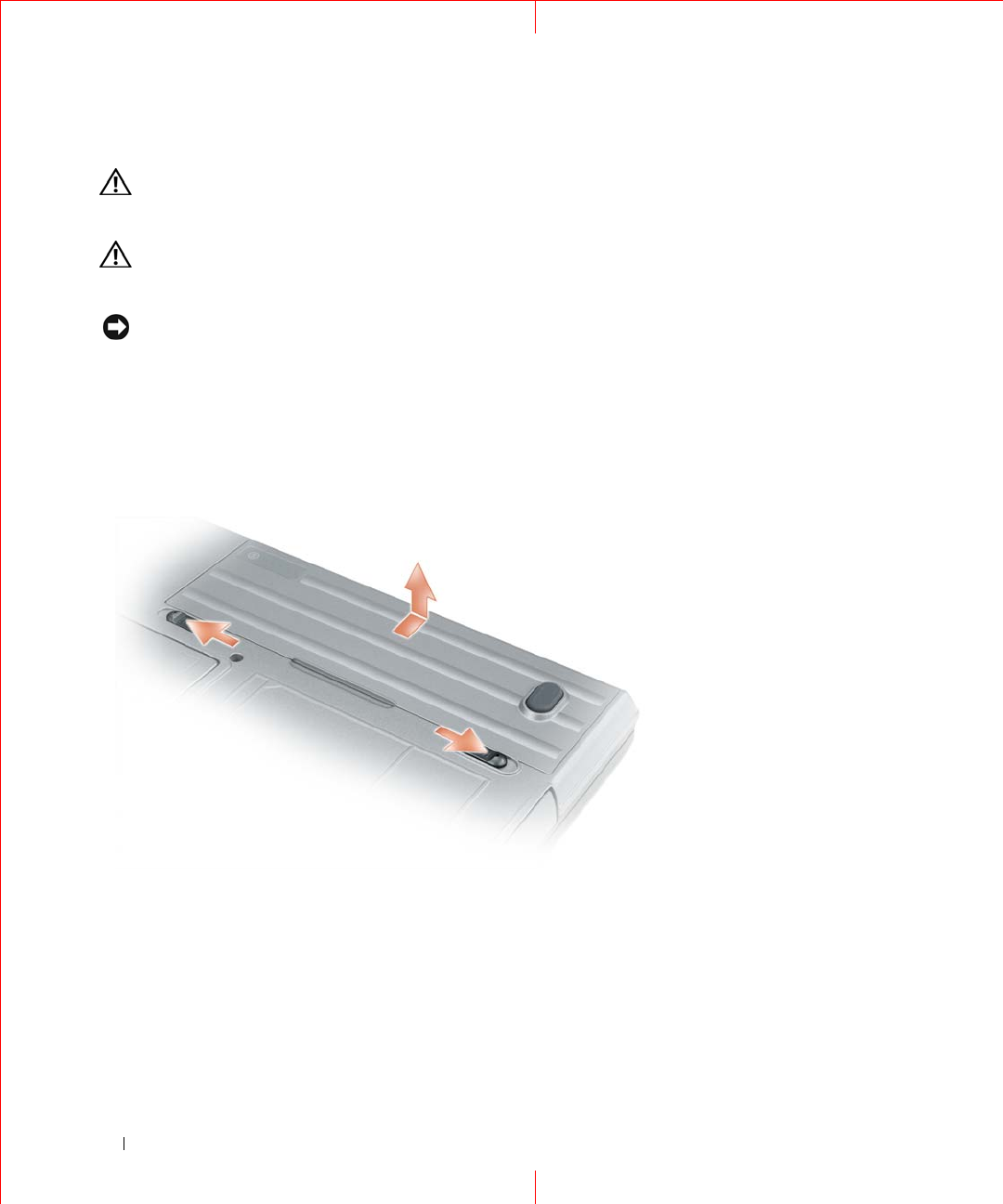
38 Using a Battery
FILE LOCATION: C:\Documents and Settings\reggie_davis\Desktop\Projects-07\BEN\Source\battery.fm
DELL CONFIDENTIAL – PRELIMINARY 1/25/07 – FOR PROOF ONLY
Replacing the Battery
CAUTION: Using an incompatible battery may increase the risk of fire or explosion. Replace the battery only
with a compatible battery purchased from Dell. The battery is designed to work with your Dell™ computer. Do not
use a battery from other computers with your computer.
CAUTION: Before performing these procedures, turn off the computer, disconnect the AC adapter from the
electrical outlet and the computer, disconnect the modem from the wall connector and computer, and remove any
other external cables from the computer.
NOTICE: You must remove all external cables from the computer to avoid possible connector damage.
To remove the battery:
1
If the computer is connected to a docking device (docked), undock it. See the documentation that
came with your docking device for instructions.
2
Ensure that the computer is turned off.
3
Slide the two latch releases on the bottom of the computer, and then remove the battery from the bay.
To replace the battery, follow the removal procedure in reverse order.
Storing a Battery
Remove the battery when you store your computer for an extended period of time. A battery discharges
during prolonged storage. After a long storage period, recharge the battery fully (see "Charging the
Battery" on page 37) before you use it.
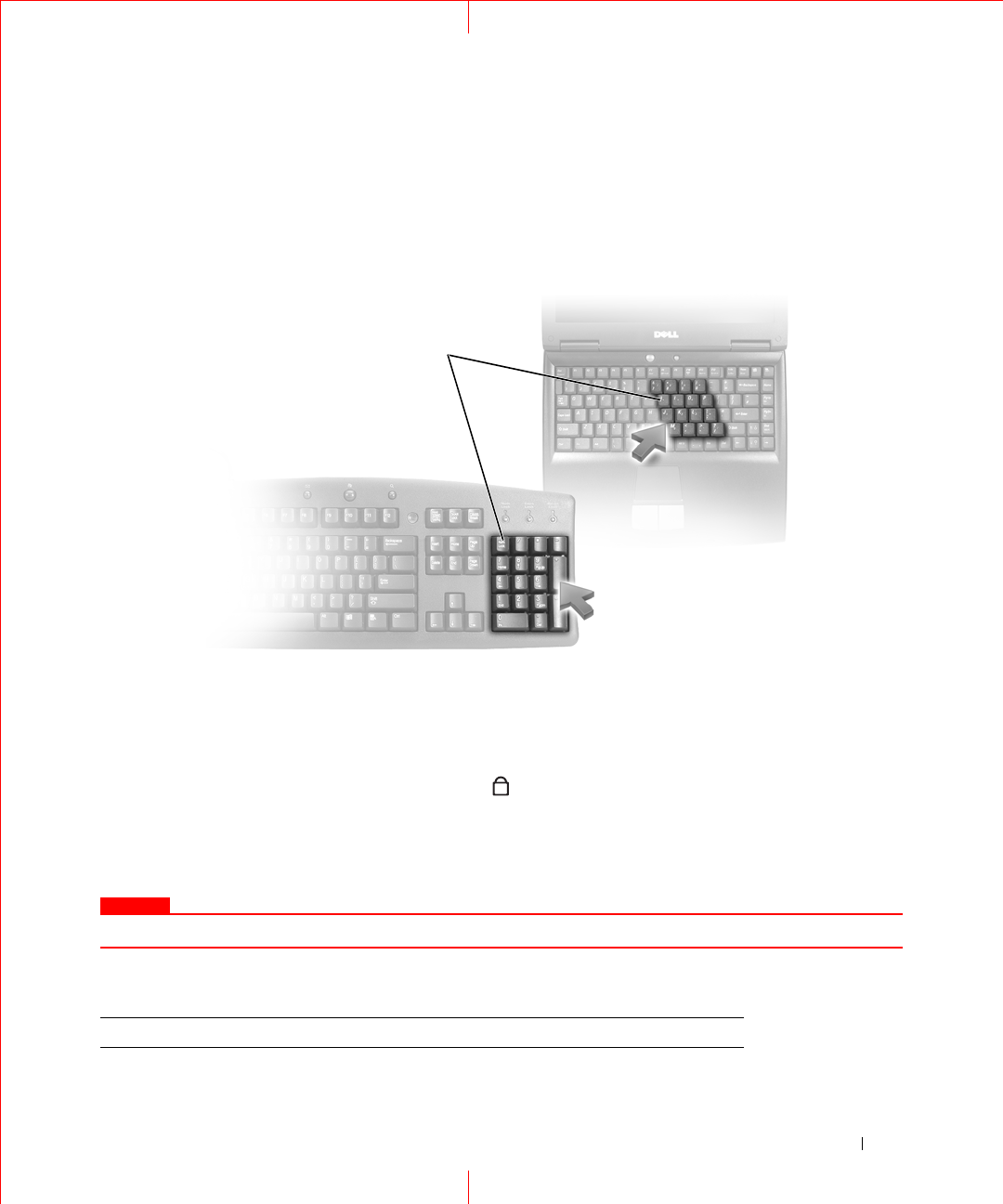
Using the Keyboard 39
FILE LOCATION: C:\Documents and Settings\reggie_davis\Desktop\Projects-07\BEN\Source\keyboard.fm
DELL CONFIDENTIAL – PRELIMINARY 1/25/07 – FOR PROOF ONLY
Using the Keyboard
Numeric Keypad
The numeric keypad functions like the numeric keypad on an external keyboard. Each key on the keypad
has multiple functions. The keypad numbers and symbols are marked in blue on the right of the keypad
keys. To type a number or symbol, hold down <Fn> and press the desired key.
• To enable the keypad, press <Num Lk>. The light indicates that the keypad is active.
• To disable the keypad, press <Num Lk> again.
Key Combinations
COMMENT
Need to verify keycaps and functions.
System Functions
<Ctrl><Shift><Esc> Opens the Task M ana ger window.
numeric keypad
9

40 Using the Keyboard
FILE LOCATION: C:\Documents and Settings\reggie_davis\Desktop\Projects-07\BEN\Source\keyboard.fm
DELL CONFIDENTIAL – PRELIMINARY 1/25/07 – FOR PROOF ONLY
Battery
Display Functions
Power Management
Microsoft® Windows® Logo Key Functions
<Fn><F3> Displays the Dell™ QuickSet Battery Meter (see "Dell™
QuickSet Battery Meter" on page 34).
<Fn><F8> Switches the video image to the next display option. The
options include the integrated display, an external
monitor, and both displays simultaneously.
<Fn><F7> Scales between wide-screen and standard aspect ratio
video resolutions.
<Fn> and left-arrow key Activates the ambient light sensor, which controls
brightness of the display based on light level in the
current environment.
<Fn> and up-arrow key Increases brightness on the integrated display only (not
on an external monitor).
<Fn> and down-arrow key Decreases brightness on the integrated display only (not
on an external monitor).
<Fn><Esc> Activates a power management mode. You can
reprogram this keyboard shortcut to activate a different
power management mode using the Advanced tab in the
Power Options Properties window (see "Accessing Power
Options Properties" on page 37).
<Fn><F1> Puts the computer into hibernate mode. Dell QuickSet is
required (see "Dell™ QuickSet" on page 131).
Windows logo key and <m> Minimizes all open windows.
Windows logo key and <Shift><m> Restores all minimized windows. This key
combination functions as a toggle to restore
minimized windows following the use of the
Windows logo key and <m> key combination.
Windows logo key and <e> Runs Windows Explorer.
Windows logo key and <r> Opens the Run dialog box.
Windows logo key and <f> Opens the Search Results dialog box.
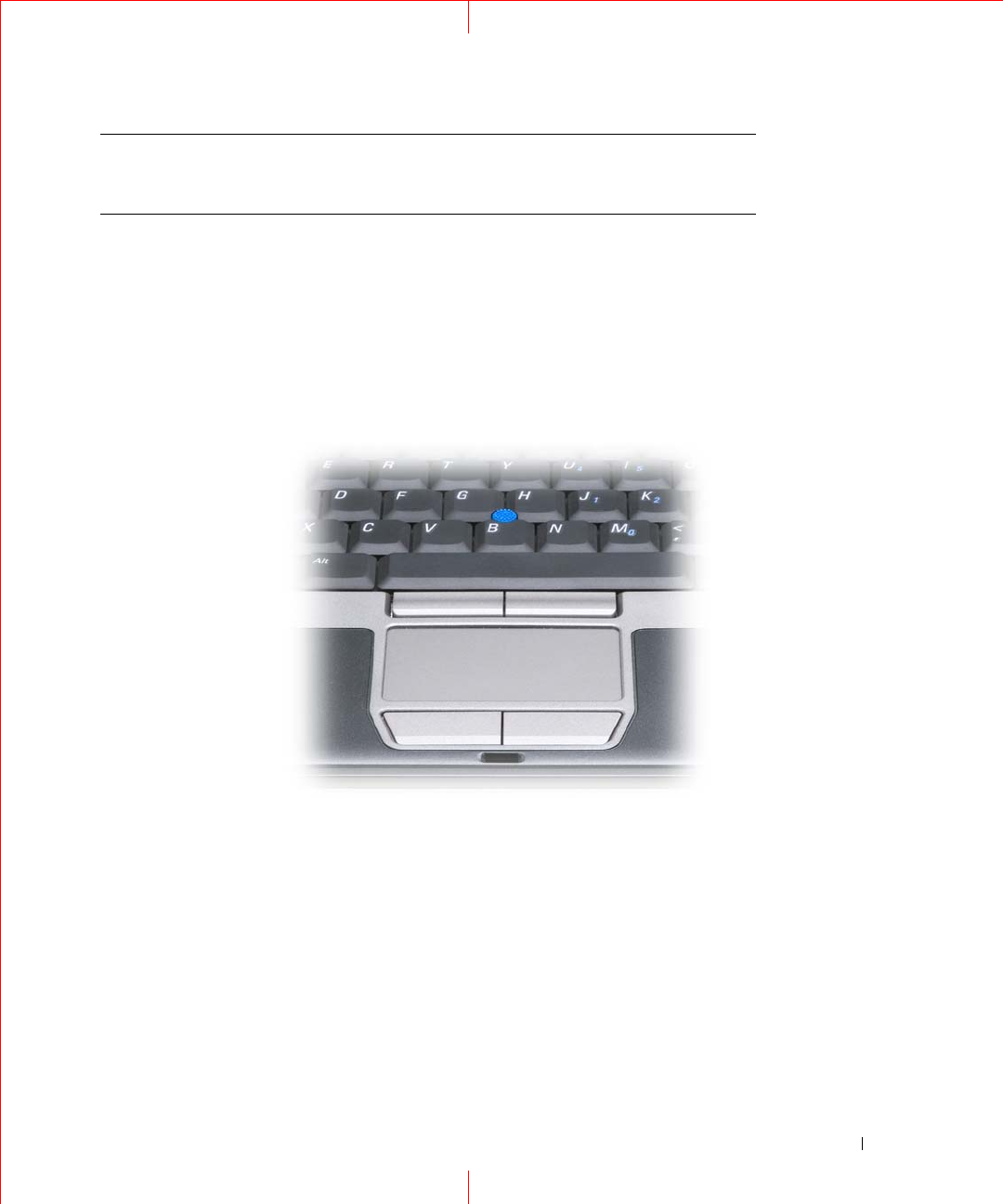
Using the Keyboard 41
FILE LOCATION: C:\Documents and Settings\reggie_davis\Desktop\Projects-07\BEN\Source\keyboard.fm
DELL CONFIDENTIAL – PRELIMINARY 1/25/07 – FOR PROOF ONLY
To adjust keyboard operation, such as the character repeat rate, open the Control Panel, click Printers
and Other Hardware, and click Keyboard. For information about the Control Panel, access the Help and
Support Center (click Start→ Help and Support).
Touch Pad
The touch pad detects the pressure and movement of your finger to allow you to move the cursor on the
display. Use the touch pad and touch pad buttons as you would use a mouse.
• To move the cursor, lightly slide your finger over the touch pad.
• To select an object, lightly tap once on the surface of the touch pad or use your thumb to press the left
touch-pad button.
• To select and move (or drag) an object, position the cursor on the object and tap twice on the touch
pad. On the second tap, leave your finger on the touch pad and move the selected object by sliding
your finger over the surface.
• To double-click an object, position the cursor on the object and tap twice on the touch pad or use your
thumb to press the left touch-pad button twice.
Windows logo key and <Ctrl><f> Opens the Search Results-Computer dialog box (if
the computer is connected to a network).
Windows logo key and <Pause> Opens the System Properties dialog box.
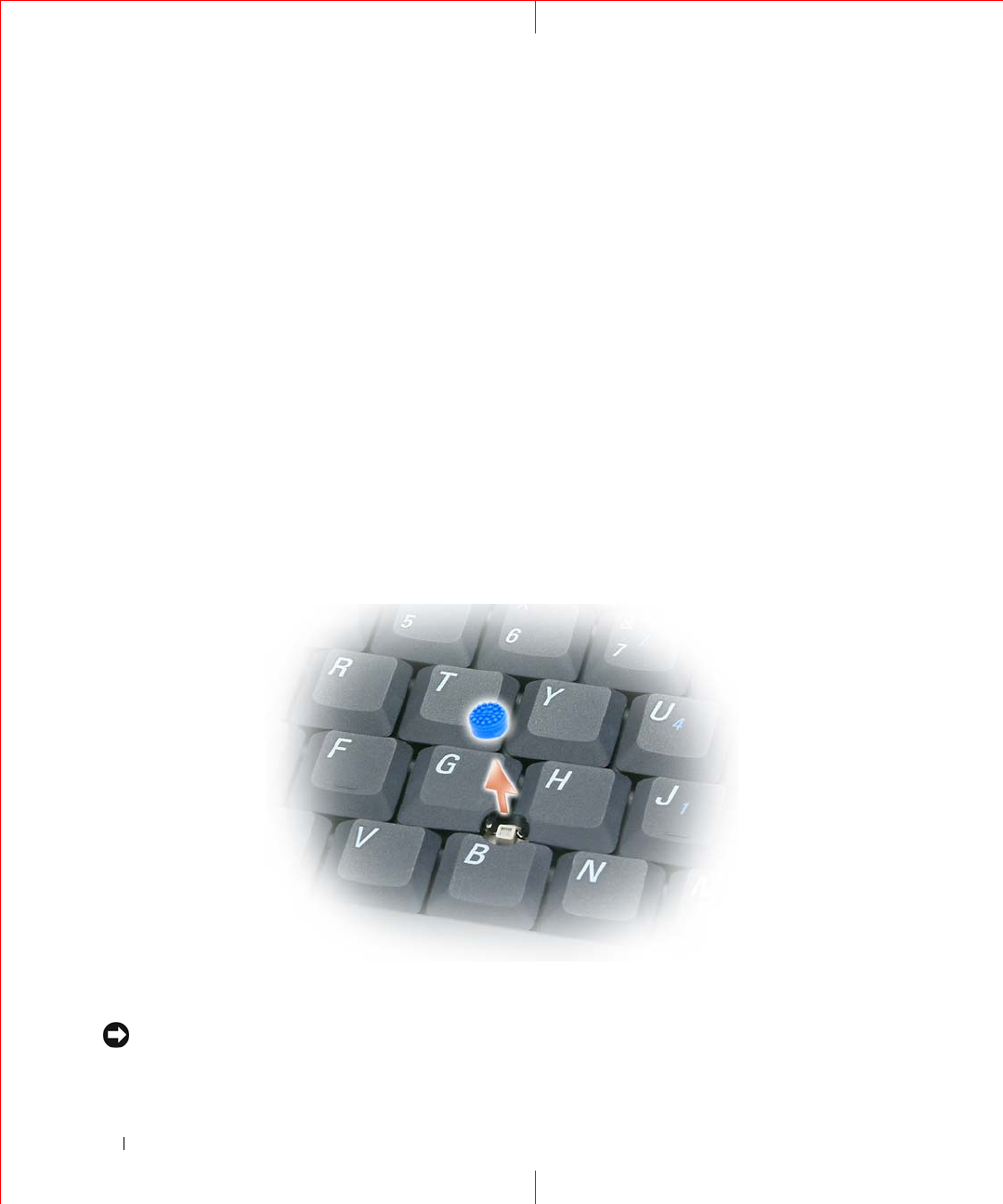
42 Using the Keyboard
FILE LOCATION: C:\Documents and Settings\reggie_davis\Desktop\Projects-07\BEN\Source\keyboard.fm
DELL CONFIDENTIAL – PRELIMINARY 1/25/07 – FOR PROOF ONLY
You can also use the track stick to move the cursor. Press the track stick left, right, up, or down to change
the direction of the cursor on the display. Use the track stick and track stick buttons as you would use a
mouse.
Customizing the Touch Pad and Track Stick
You can use the Mouse Properties window to disable the touch pad and track stick or adjust their
settings.
1
Open the Control Panel, and then click
Mouse
. For information about the Control Panel,
access the
Help and Support Center (click Start→ Help and Support).
2
In the
Mouse Properties
window:
•Click the
Device Select
tab to disable the touch pad and track stick.
•Click the
Touch Pad
tab to adjust touch pad and track stick settings.
3
Click
OK
to save the settings and close the window.
Changing the Track Stick Cap
You can replace your track stick cap if it wears down from prolonged use or if you prefer a different color.
You can purchase additional caps by visiting the Dell website at dell.com.
1
Pull the cap off the track stick.
2
Align the new cap over the square track stick post and gently press the cap down onto the post.
NOTICE: The track stick can damage the display if it is not properly seated on the post.
3
Test the track stick to ensure that the cap is seated properly.
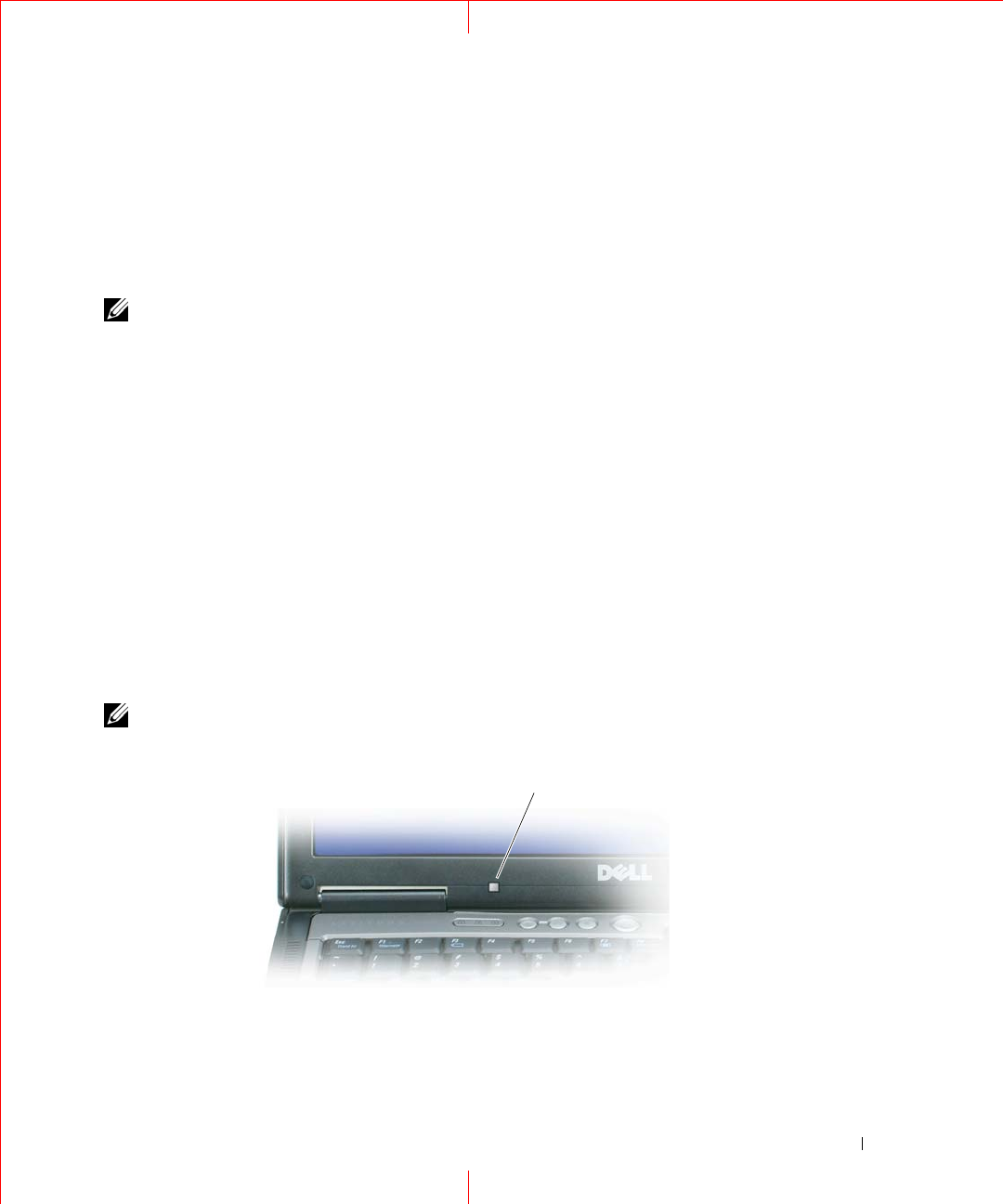
Using the Display 43
FILE LOCATION: C:\Documents and Settings\reggie_davis\Desktop\Projects-07\BEN\Source\display.fm
DELL CONFIDENTIAL – PRELIMINARY 1/25/07 – FOR PROOF ONLY
Using the Display
Adjusting Brightness
When a Dell™ computer is running on battery power, you can conserve power by setting the brightness
to the lowest comfortable setting by pressing <Fn> and the up- or down-arrow key on the keyboard.
NOTE: Brightness key combinations only affect the display on your portable computer, not monitors or projectors
that you attach to your portable computer or docking device. If your computer is connected to an external monitor
and you try to change the brightness level, the Brightness Meter may appear, but the brightness level on the
external device does not change.
You can press the following keys to adjust display brightness:
• Press <Fn> and the up-arrow key to increase brightness on the integrated display only (not on an
external monitor).
• Press <Fn> and the down-arrow key to decrease brightness on the integrated display only (not on an
external monitor).
Using the Ambient Light Sensor
The ambient light sensor is located on the bottom of the computer display panel. The ambient light
sensor detects available environmental light and automatically increases or decreases the display
backlighting to compensate for low-light and high-light environments.
You can enable or disable the ambient light sensor by pressing the <Fn> and left-arrow key
combination.
NOTE: Do not cover the ambient light sensor with any adhesive labels. If covered up, the ambient light sensor
automatically sets the display brightness to the minimum level.
1ambient light sensor
1

44 Using the Display
FILE LOCATION: C:\Documents and Settings\reggie_davis\Desktop\Projects-07\BEN\Source\display.fm
DELL CONFIDENTIAL – PRELIMINARY 1/25/07 – FOR PROOF ONLY
The ambient light sensor is disabled when your computer is shipped to you. If you enable the ambient
light sensor and then use any of the display brightness key combinations, the ambient light sensor is
disabled and the display brightness is increased or decreased accordingly.
Dell™ QuickSet allows you to enable or disable the ambient light sensor. You can also adjust maximum
and minimum brightness settings that are activated when you enable the ambient light sensor feature.
For more information about QuickSet, right-click the icon in the taskbar, and click Help.
NOTE: Rebooting the computer returns the ambient light sensor to the last setting of enabled or disabled.
NOTE: The ambient light sensor adjusts the display backlighting on your portable computer only. It does not
control the brightness on any external monitors or projectors.
Switching the Video Image
When you start the computer with an external device (such as an external monitor or projector)
attached and turned on, the image may appear on either the computer display or the external device.
Press <Fn><F8> to switch the video image between the display only, the external device only, or the
display and the external device simultaneously.
Setting Display Resolution and Refresh Rate
To display a program at a specific resolution, both the graphics card and the display must support the
program, and the necessary video drivers must be installed.
Before you change any of the default display settings, make a note of the default settings for future
reference.
NOTE: Use only the Dell-installed video drivers, which are designed to offer the best performance with your Dell-
installed operating system.
If you choose a resolution or color palette that is higher than the display supports, the settings adjust
automatically to the closest supported values.
1
Click the
Start
button and click
Control Panel
.
2
Under
Pick a category
, click
Appearance and Themes
.
3
Under
Pick a task...
, click the area you want to change, or under
or pick a Control Panel icon
, click
Display
.
4
In the Display Properties window, click the
Settings
tab.
5
Try different settings for
Color quality
and
Screen resolution
.
NOTE: As the resolution increases, icons and text appear smaller on the screen.
If the video resolution setting is higher than that supported by the display, the computer enters pan
mode. In pan mode, the entire screen cannot be displayed at one time. For example, the taskbar that
usually appears at the bottom of the desktop may no longer be visible. To view the rest of the screen, use
the touch pad or track stick to pan up, down, left, and right.

Using the Display 45
FILE LOCATION: C:\Documents and Settings\reggie_davis\Desktop\Projects-07\BEN\Source\display.fm
DELL CONFIDENTIAL – PRELIMINARY 1/25/07 – FOR PROOF ONLY
NOTICE: You can damage an external monitor by using an unsupported refresh rate. Before adjusting the refresh
rate on an external monitor, see the user’s guide for the monitor.
Dual Independent Display Mode
You can attach an external monitor or projector to your computer and use it as an extension of your
display (known as "dual independent display" or "extended desktop" mode). This mode allows you to use
both screens independently and drag objects from one screen to the other, effectively doubling the
amount of viewable work space.
1
Connect the external monitor, TV, or projector to the computer.
2
Under
Pick a category
, click
Appearance and Themes
.
3
Under
Pick a task...
, click the area you want to change, or under
or pick a Control Panel icon
, click
Display
.
4
In the
Display Properties
window, click the
Settings
tab.
NOTE: If you choose a resolution or color palette that is higher than the display supports, the settings adjust
automatically to the closest supported values. For more information, see your operating system documentation.
5
Click the monitor 2 icon, click the
Extend my Windows desktop onto this monitor
check box, and
then click
Apply
.
6
Change
Screen resolution
to the appropriate sizes for both displays and click
Apply
.
7
If prompted to restart the computer, click
Apply the new color setting without restarting
and click
OK
.
8
If prompted, click
OK
to resize your desktop.
9
If prompted, click
Yes
to keep the settings.
10
Click
OK
to close the
Display Properties
window.
To disable dual independent display mode:
1
Click the
Settings
tab in the
Display Properties
window.
2
Click the monitor 2 icon, uncheck the
Extend my Windows desktop onto this monitor
option, and
then click
Apply
.
If necessary, press <Fn><F8> to bring the screen image back to the computer display.
Swapping Primary and Secondary Displays
To swap your primary and secondary display designations (for example, to use your external monitor as
your primary display after docking):
1
Click the
Start
button and click
Control Panel
.
2
Under
Pick a category
, click
Appearance and Themes
.

46 Using the Display
FILE LOCATION: C:\Documents and Settings\reggie_davis\Desktop\Projects-07\BEN\Source\display.fm
DELL CONFIDENTIAL – PRELIMINARY 1/25/07 – FOR PROOF ONLY
3
Under
Pick a task...
, click the area you want to change, or under
or pick a Control Panel icon
, click
Display
.
4
Click the
Settings
tab
→
Advanced
→
Displays
tab.
See the documentation that came with your video card for additional information.
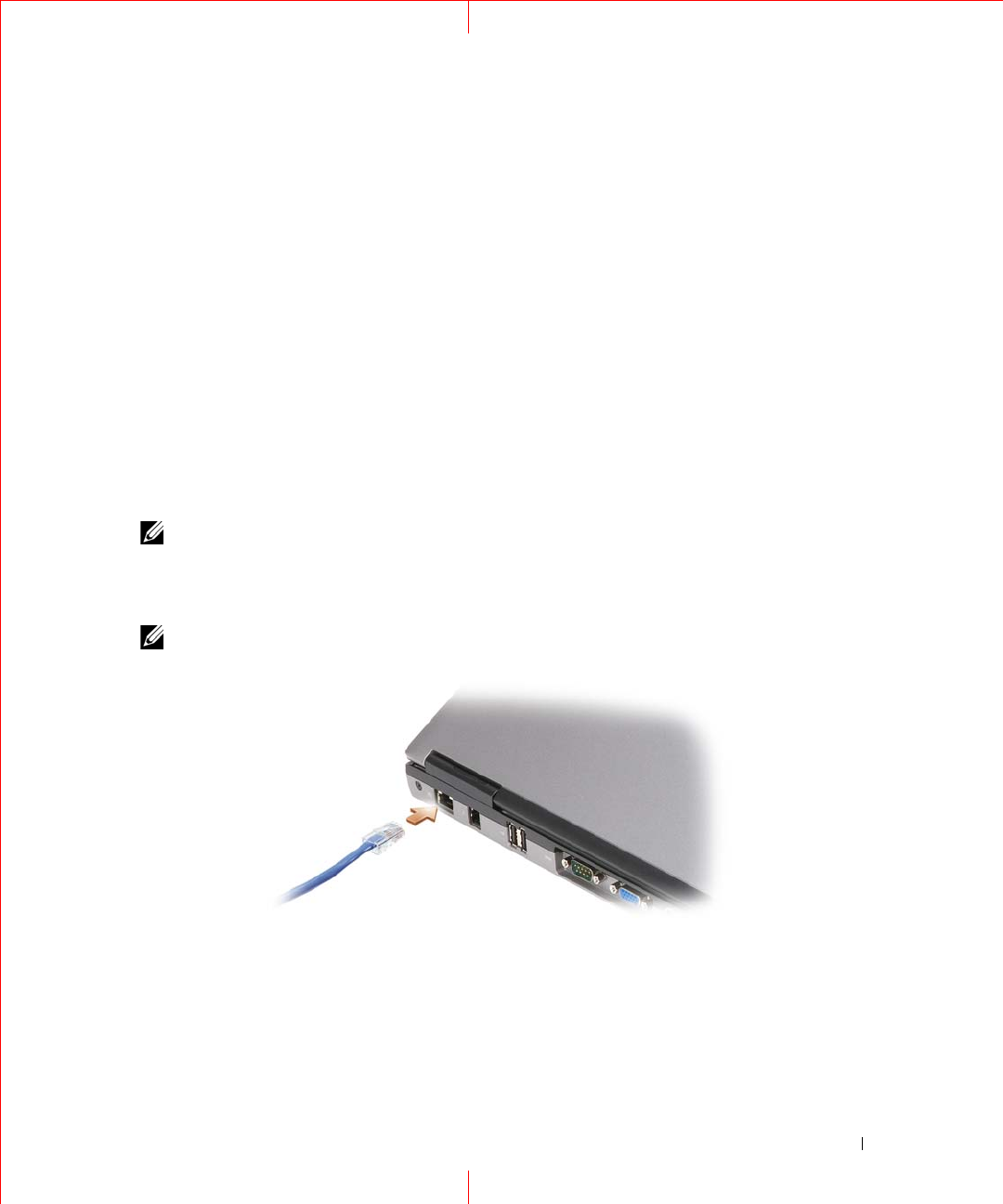
Setting Up and Using Networks 47
FILE LOCATION: C:\Documents and Settings\reggie_davis\Desktop\Projects-07\BEN\Source\network.fm
DELL CONFIDENTIAL – PRELIMINARY 1/25/07 – FOR PROOF ONLY
Setting Up and Using Networks
Setting up a computer network provides connectivity between your computer and the Internet, another
computer, or a network. For example, with a network set up in a home or small office you can print to a
shared printer, access drives and files on another computer, browse other networks, or access the Internet.
You can set up a local area network (LAN) using a network or broadband modem cable, or set up a
wireless LAN (WLAN).
The Windows XP and Windows Vista operating systems provide wizards to help guide you through the
process of networking computers. For more information about Networking, access the Help and Support
Center (click Start→ Help and Support).
Connecting a Network or Broadband Modem Cable
Before you connect your computer to a network, the computer must have a network adapter installed
and a network cable connected to it.
1
Connect the network cable to the network adapter connector on the back of your computer.
NOTE: Insert the cable connector until it clicks into place, and then gently pull the cable to ensure that it is
securely attached.
2
Connect the other end of the network cable to a network connection device or a network wall
connector.
NOTE: Do not use a network cable with a telephone wall connector.
Setting Up a Network in the Microsoft® Windows® XP Operating
System
1
Click
Start
→
All Programs
→
Accessories
→
Communications
→
Network Setup Wizard
→
Next
→
Checklist for creating a network
.

48 Setting Up and Using Networks
FILE LOCATION: C:\Documents and Settings\reggie_davis\Desktop\Projects-07\BEN\Source\network.fm
DELL CONFIDENTIAL – PRELIMINARY 1/25/07 – FOR PROOF ONLY
NOTE: Selecting the connection method labeled This computer connects directly to the Internet enables the
integrated firewall provided with Windows XP Service Pack 2 (SP2).
2
Complete the checklist.
3
Return to the Network Setup Wizard and follow the instructions in the wizard.
Setting Up a Network in the Microsoft Windows Vista™ Operating
System
1
Click the Windows Vista Start button
, ,
and click
Connect To
→
Set up a connection or network
.
2
Select an option under
Choose a connection option
.
3
Click
Next
, and then follow the instructions in the wizard.
Wireless Local Area Network
A wireless local area network (WLAN) is a series of interconnected computers that communicate with
each other over the air waves rather than through a network cable connected to each computer. In a
WLAN, a radio communications device called an access point or wireless router connects network
computers and provides Internet, or network, access. The access point or wireless router and the wireless
network card in the computer communicate by broadcasting data from their antennas over the air waves.
What You Need to Establish a WLAN Connection
Before you can set up a WLAN, you need:
• High-speed (broadband) Internet access (such as cable or DSL)
• A broadband modem that is connected and working
• A wireless router or access point
• A wireless network card for each computer that you want to connect to your WLAN
• A network cable with a network (RJ-45) connector
Checking Your Wireless Network Card
Depending on what you selected when you purchased your computer, the computer has a variety of
configurations. To confirm that your computer has a wireless network card and to determine the type of
card, use one of the following:
•The
Start
button and the
Connect To
option
• The order confirmation for your computer
Start Button and Connect To Option
In Microsoft Windows XP, click Start→ Connect To→ Show all connections.
In Microsoft Windows Vista, click Start→ Connect To→ View network computers and devices.

Setting Up and Using Networks 49
FILE LOCATION: C:\Documents and Settings\reggie_davis\Desktop\Projects-07\BEN\Source\network.fm
DELL CONFIDENTIAL – PRELIMINARY 1/25/07 – FOR PROOF ONLY
If Wireless Network Connection does not appear under LAN or High-Speed Internet, you may not have
a wireless network card.
If Wireless Network Connection appears, you have a wireless network card. To view detailed information
about the wireless network card:
1
Right-click
Wireless Network Connection
.
2
Click
Properties
.
The
Wireless Network Connection Properties
window appears. The wireless network card’s name and
model number are listed on the
General
tab.
NOTE: If your computer is set to the Classic Start menu option, you can view network connections by clicking
the Start
→
Settings
→
Network Connections. If Wireless Network Connection does not appear, you may not
have a wireless network card.
The Order Confirmation for Your Computer
The order confirmation that you received when you ordered your computer lists the hardware and
software that shipped with your computer.
Setting Up a New WLAN Using a Wireless Router and a Broadband Modem
1
Contact your Internet service provider (ISP) to obtain specific information about the connection
requirements for your broadband modem.
2
Ensure that you have wired Internet access through your broadband modem before you attempt to set
up a wireless Internet connection (see "Connecting a Network or Broadband Modem Cable" on
page 47).
3
Install any software required for your wireless router. Your wireless router may have been shipped with
an installation media. Installation media usually contain installation and troubleshooting information.
Install the required software according to the instructions provided by the router manufacturer.
4
Shut down your computer and any other wireless-enabled computers in the vicinity through the
Start
or
menu.
5
Disconnect your broadband modem power cable from the electrical outlet.
6
Disconnect the network cable from the computer and the modem.
7
Disconnect the AC adapter cable from your wireless router to ensure that there is no power connected
to the router.
NOTE: Wait for a minimum of 5 minutes after disconnecting your broadband modem before you continue with the
network setup.
8
Insert a network cable into the network (RJ-45) connector on the unpowered broadband modem.
9
Connect the other end of the network cable into the Internet network (RJ-45) connector on the
unpowered wireless router.
10
Ensure that no network or USB cables, other than the network cable connecting the modem and the
wireless router, are connected to the broadband modem.

50 Setting Up and Using Networks
FILE LOCATION: C:\Documents and Settings\reggie_davis\Desktop\Projects-07\BEN\Source\network.fm
DELL CONFIDENTIAL – PRELIMINARY 1/25/07 – FOR PROOF ONLY
NOTE: Restart your wireless equipment in the order described below to prevent a potential connection failure.
11
Tu r n o n
only
your broadband modem and wait for at least 2 minutes for the broadband modem to
stabilize. After 2 minutes, proceed to step 12.
12
Turn on your wireless router and wait for at least 2 minutes for the wireless router to stabilize. After 2
minutes, proceed to the step 13.
13
Start your computer and wait until the boot process completes.
14
See the documentation that came with your wireless router to do the following in order to set up the
wireless router:
• Establish communication between your computer and your wireless router.
• Configure your wireless router to communicate with your broadband router.
• Find out your wireless router’s broadcast name. The technical term for the name of your router’s
broadcast name is Service Set Identifier (SSID) or network name.
15
If necessary, configure your wireless network card to connect to the wireless network (see "Connecting
to a WLAN" on page 50).
Connecting to a WLAN
NOTE: Before you connect to a WLAN, ensure that you have followed the instructions in "Wireless Local Area
Network" on page 48.
NOTE: The following networking instructions do not apply to internal cards with Bluetooth® wireless technology
or cellular products.
This section provides general procedures for connecting to a network using wireless technology. Specific
network names and configuration details vary. See "Wireless Local Area Network" on page 48 for more
information about how to prepare for connecting your computer to a WLAN.
Your wireless network card requires specific software and drivers for connecting to a network. The
software is already installed.
NOTE: If the software is removed or corrupted, follow the instructions in the user documentation for your wireless
network card. Verify the type of wireless network card installed in your computer and then search for that name on
the Dell™ Support website at support.dell.com. For information on the type of wireless network card that is
installed in your computer, see "Checking Your Wireless Network Card" on page 48.
Determining the Wireless Network Device Manager
Depending on the software installed on your computer, different wireless configuration utilities may
manage your network devices:
• Your wireless network card’s client utility
• The Windows XP or Windows Vista operating system
To determine which wireless configuration utility is managing your wireless network card in Windows
XP:

Setting Up and Using Networks 51
FILE LOCATION: C:\Documents and Settings\reggie_davis\Desktop\Projects-07\BEN\Source\network.fm
DELL CONFIDENTIAL – PRELIMINARY 1/25/07 – FOR PROOF ONLY
1
Click
Start
→
Settings
→
Control Panel
→
Network Connections
.
2
Right-click the
Wireless Network Connection
icon, and then click
View Available Wireless Networks
.
If the Choose a wireless network window states Windows cannot configure this connection, the wireless
network card’s client utility is managing the wireless network card.
If the Choose a wireless network window states Click an item in the list below to connect to a wireless
network in range or to get more information, the Windows XP operating system is managing the
wireless network card.
To determine which wireless configuration utility is managing your wireless network card in Windows
Vista:
1
Click
Start
→
Connect To→ Manage wireless networks.
2
Double-click a profile to open the wireless network properties screen.
For specific information about the wireless configuration utility installed on your computer, see your
wireless network documentation in the Windows Help and Support Center (click Start→ Help and
Support).
Completing the Connection to the WLAN
When you turn on your computer and a network (for which your computer is not configured) is detected
in the area, a pop-up appears near the network icon in the notification area (in the lower-right corner of
the Windows desktop).
Follow the instructions provided in any utility prompts that appear on your screen.
Once you have configured your computer for the wireless network that you selected, another pop-up
notifies you that your computer is connected to that network.
Thereafter, whenever you log on to your computer within the range of the wireless network that you
selected, the same pop-up notifies you of the wireless network connection.
NOTE: If you select a secure network, you must enter a WEP or WPA key when prompted. Network security
settings are unique to your network. Dell cannot provide this information.
NOTE: Your computer can take up to 1 minute to connect to the network.
Monitoring the Status of the Wireless Network Card Through Dell QuickSet
The wireless activity indicator provides you with an easy way to monitor the status of your computer’s
wireless devices. To turn the wireless activity indicator on or off, click the QuickSet icon in the taskbar
and select Hotkey Popups. If Wireless Activity Indicator Off is not checked, the indicator is on. If
Wireless Activity Indicator Off is checked, the indicator is off.
The wireless activity indicator displays whether your computer’s integrated wireless devices are enabled
or disabled. When you turn the wireless networking function on or off, the wireless activity indicator
changes to display the status.
For more information about the Dell QuickSet wireless activity indicator, right-click the QuickSet icon in
the taskbar and select Help.

52 Setting Up and Using Networks
FILE LOCATION: C:\Documents and Settings\reggie_davis\Desktop\Projects-07\BEN\Source\network.fm
DELL CONFIDENTIAL – PRELIMINARY 1/25/07 – FOR PROOF ONLY
Mobile Broadband (or Wireless Wide Area Network)
A Mobile Broadband network, also known as a Wireless Wide Area Network (WWAN), is a high-speed
digital cellular network that provides Internet access over a much wider geographical area than a WLAN,
which typically covers only from 100 to 1000 feet. Your computer can maintain Mobile Broadband
network access as long as the computer is within a cellular-data coverage zone. Contact your service
provider for coverage of a high-speed digital cellular network.
NOTE: Even if you are able to make a call from your cellular phone in a specific geographical location, that
location may not necessarily be within a cellular-data coverage zone.
What You Need to Establish a Mobile Broadband Network Connection
NOTE: Depending on your computer, you can use a Mini Card to establish a Mobile Broadband network
connection.
To set up a Mobile Broadband network connection, you need:
•A Mini Card
• An activated Subscriber Identity Module (SIM) for your service provider
NOTE: Only Cingular and Vodafone need a SIM card. Verizon, Sprint, and Telus do not use a SIM.
• The Dell Mobile Broadband Card Utility (already installed on your computer if you purchased the card
when you purchased your computer, or on the media that accompanied your card if purchased
separately from your computer)
If the utility is corrupted or deleted from your computer, see the Dell Mobile Broadband Card Utility
user’s guide for instructions. The user’s guide is available through the Windows Help and Support
Center
(click Start→ Help and Support)
or on the media that accompanied your card if you
purchased it separately from your computer.
Checking Your Dell Mobile Broadband Card
Depending on what you selected when you purchased your computer, the computer has a variety of
configurations. To determine your computer configuration, see one of the following:
• Your order confirmation
• Microsoft Windows Help and Support Center
To check your Mobile Broadband card in the Windows Help and Support Center:
1
Click
Start
→
Help and Support
→
Use Tools to view your computer information and diagnose
problems
.
2
Under
Tools
, click
My Computer Information
→
Find information about the hardware installed on
this computer.
On the My Computer Information - Hardware screen, you can view the type of Mobile Broadband card
installed in your computer as well as other hardware components.
NOTE: The Mobile Broadband card is listed under Modems.

Setting Up and Using Networks 53
FILE LOCATION: C:\Documents and Settings\reggie_davis\Desktop\Projects-07\BEN\Source\network.fm
DELL CONFIDENTIAL – PRELIMINARY 1/25/07 – FOR PROOF ONLY
Connecting to a Mobile Broadband Network
NOTE: These instructions only apply to Mini-Cards. They do not apply to internal cards with wireless technology.
NOTE: Before you connect to the Internet, you must activate Mobile Broadband service through your cellular
service provider. For instructions and for additional information about using the Dell Mobile Broadband Card Utility,
see the user's guide available through the Windows Help and Support Center (click Start→ Help and Support). The
user's guide is also available on the Dell Support website at support.dell.com and on the media included with your
Mobile Broadband card if you purchased the card separately from your computer.
Use the Dell Mobile Broadband Card Utility to establish and manage a Mobile Broadband network
connection to the Internet:
1
Click the
Dell Mobile Broadband Card Utility icon
on the Windows desktop, to run the utility.
2
Click
Connect
.
NOTE: The Connect button changes to the Disconnect button.
3
Follow the instructions on the screen to manage the network connection with the utility.
Or
1
Click
Start
→
All Programs
→
Dell Wireless
.
2
Click
Dell Wireless Broadband
and follow the instructions on the screen.
Enabling/Disabling the Dell™ Mobile Broadband Card
NOTE: If you are unable to connect to a Mobile Broadband network, ensure that you have all the components for
establishing a Mobile Broadband connection (see "What You Need to Establish a Mobile Broadband Network
Connection" on page 52), and then verify that your Mobile Broadband card is enabled by verifying the setting of the
wireless switch.
You can turn your Mobile Broadband card on and off using the wireless switch on your computer.
You can turn your computer’s wireless devices on and off with the wireless switch on the left side of the
computer (see "Left Side View" on page 18).
If the switch is in the "on" position, move the switch to the "off" position to disable the switch and the
Mobile Broadband card. If the switch is in the "off" position, move the switch to the "on" position to
enable the switch and the Dell Mobile Broadband card. For information about the wireless switch
positions, see "wireless switch" on page 19.
To monitor the status of your wireless device, see "Monitoring the Status of the Wireless Network Card
Through Dell QuickSet" on page 51.
Managing Your Network Settings Through the Dell QuickSet Location Profiler
The Dell QuickSet Location Profiler helps you manage network settings that correspond to your
computer’s physical location. It includes two categories of profile settings:
• Location Profile Settings
• General Mobility Settings

54 Setting Up and Using Networks
FILE LOCATION: C:\Documents and Settings\reggie_davis\Desktop\Projects-07\BEN\Source\network.fm
DELL CONFIDENTIAL – PRELIMINARY 1/25/07 – FOR PROOF ONLY
You can use Location Profile Settings to create profiles for accessing the Internet with your computer in
your office, home, or other public places with Internet services. General Mobility Settings allows you to
change the way network connections are handled. The profiles consist of different network settings and
equipment that you need when using your computer in different locations.
For more information about Dell QuickSet, right-click the QuickSet icon in the taskbar and select Help.
Dell Wi-Fi Catcher™ Network Locator
The wireless switch on your Dell computer uses the Dell Wi-Fi Catcher Network Locator to scan
specifically for WiFi WLAN in your vicinity. For more information about the wireless switch, see
"wireless switch" on page 19.
To scan for WiFi WLAN, slide and hold the switch in the "momentary" position for a few seconds. The
Wi-Fi Catcher Network Locator functions regardless of whether your computer is turned on or off, in
hibernate mode, or in standby mode, as long as the switch is configured through Dell QuickSet or the
BIOS (system setup program) to control WiFi network connections.
Because the Wi-Fi Catcher Network Locator is disabled and not configured for use when your computer
is shipped to you, you must first use Dell QuickSet to enable and configure the switch to control WiFi
network connections.
For more information on the Wi-Fi Catcher Network Locator and to enable the feature through Dell
QuickSet, right-click the QuickSet icon in the taskbar and select Help.
Microsoft® Windows® Firewall
Windows Firewall provides basic protection from unauthorized access to your computer while it is
connected to the Internet. Windows Firewall is automatically enabled when you run the Network Setup
Wizard.
When Windows Firewall is enabled for a network connection, the firewall icon appears with a red
background in the Network Connections section of the Control Panel.
NOTE: Enabling Windows Firewall does not reduce the need for virus-checking software.
For more information, click
Start
→
Control Panel
→
Security
→
Windows Firewall
, or access the Help and
Support Center (click Start→ Help and Support).
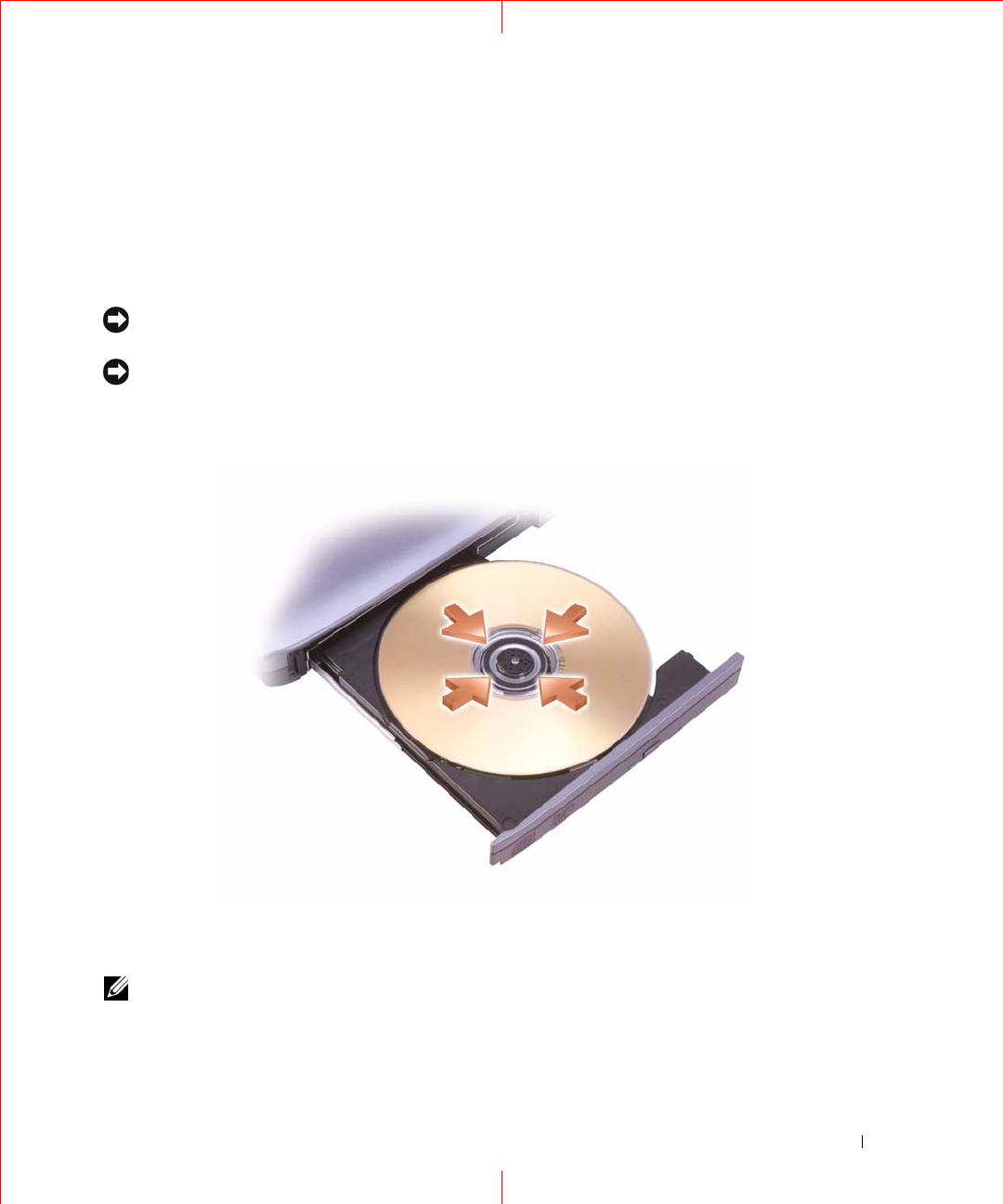
FILE LOCATION: C:\Documents and Settings\reggie_davis\Desktop\Projects-07\BEN\Source\media.fm
DELL CONFIDENTIAL – PRELIMINARY 1/25/07 – FOR PROOF ONLY
Template Last Updated - 7/01/2005 Using Multimedia 55
1
Using Multimedia
Playing Media
NOTICE: Do not press down on the media tray when you open or close it. Keep the tray closed when you are
not using the drive.
NOTICE: Do not move the computer while playing media.
1
Press the eject button on the front of the drive.
2
Pull out the tray.
3
Place the disc, label side up, in the center of the tray and snap the disc onto the spindle.
NOTE: If you use a module that shipped with another computer, you need to install the drivers and software
necessary to play DVDs or write data. For more information, see the Drivers and Utilities media (the Drivers
and Utilities media is optional and may not be available for your computer or in certain countries).

56 Using Multimedia
FILE LOCATION: C:\Documents and Settings\reggie_davis\Desktop\Projects-07\BEN\Source\media.fm
DELL CONFIDENTIAL – PRELIMINARY 1/25/07 – FOR PROOF ONLY
4
Push the tray back into the drive.
To format media for storing data, to create music media, or to copy media, see the media software that
came with your computer.
NOTE: Ensure that you follow all copyright laws when you create media.
A CD player includes the following basic buttons:
A DVD player includes the following basic buttons:
For more information on playing media, click Help on the CD or DVD player (if available).
Copying Media
NOTE: Ensure that you observe all copyright laws when creating media.
Play.
Move backward within the current track.
Pause.
Move forward within the current track.
Stop.
Go to the previous track.
Eject.
Go to the next track.
Stop.
Restart the current chapter.
Play.
Fast forward.
Pause.
Fast reverse.
Advance a single frame while in pause mode.
Go to the next title or chapter.
Continuously play the current title or chapter.
Go to the previous title or chapter.
Eject.

Using Multimedia 57
FILE LOCATION: C:\Documents and Settings\reggie_davis\Desktop\Projects-07\BEN\Source\media.fm
DELL CONFIDENTIAL – PRELIMINARY 1/25/07 – FOR PROOF ONLY
This section applies only to computers that have a CD-RW, DVD+/-RW, or CD-RW/DVD (combo)
drive.
NOTE: The types of media drives offered by Dell may vary by country.
The following instructions explain how to make a copy using Roxio Creator Plus - Dell Edition. You can
also use Roxio Creator Plus for other purposes, such as creating music CDs from audio files stored on
your computer or backing up important data. For help, open Roxio Creator Plus, and then click the
question mark icon in the upper-right corner of the window.
How to Copy Media
NOTE: CD-RW/DVD combo drives cannot write to DVD media. If you have a CD-RW/DVD combo drive and you
experience recording problems, check for available software patches on the Sonic support website at sonic.com.
The DVD-writable drives installed in Dell™ computers can write to and read DVD+/-R, DVD+/-RW
and DVD+R DL (dual layer) media, but cannot write to and may not read DVD-RAM or DVD-R DL
media.
NOTE: Most commercial DVDs have copyright protection and cannot be copied using Roxio Creator Plus.
1
Open Roxio Creator Plus.
2
Under the
Copy
tab, click
Disc Copy
.
3
To copy media:
•
If you have one media drive
, ensure that the settings are correct, and then click
Disc Copy
. The
computer reads your source media and copies the data to a temporary folder on your computer
hard drive.
When prompted, insert a blank media into the drive and click
OK
.
•
If you have two media drives
, select the drive into which you have inserted your source media, and
then click
Disc
Copy
. The computer copies the data from the source media to the blank one.
Once you have finished copying the source media, the media that you have created automatically
ejects.
Using Blank Media
CD-RW drives can write to CD recording media only (including high-speed CD-RW media) while
DVD-writable drives can write to both CD and DVD recording media.
Use blank CD-Rs to record music or permanently store data files. After the maximum storage capacity of
a CD-R is reached, you cannot write to that CD-R again (see the Sonic documentation for more
information). Use blank CD-RWs if you plan to erase, rewrite, or update information on the CD later.
Blank DVD+/-Rs can be used to permanently store large amounts of data. After you create a DVD+/-R
disc, you may not be able to write to that disc again if the disc is finalized or closed during the final stage
of the disc creation process. Use blank DVD+/-RWs if you plan to erase, rewrite, or update information
on the disc later.

58 Using Multimedia
FILE LOCATION: C:\Documents and Settings\reggie_davis\Desktop\Projects-07\BEN\Source\media.fm
DELL CONFIDENTIAL – PRELIMINARY 1/25/07 – FOR PROOF ONLY
CD-Writable Drives
DVD-Writable Drives
Helpful Tips
• Use Microsoft
®
Windows
®
Explorer to drag and drop files to a CD-R or CD-RW only after you start
Roxio Creator Plus and open a Creator project.
• Use CD-Rs to burn music CDs that you want to play in regular stereos. CD-RWs may not play in
many home or car stereos.
• You cannot create audio DVDs with Roxio Creator Plus.
• Music MP3 files can be played only on MP3 players or on computers that have MP3 software installed.
• Commercially available DVD players used in home theater systems may not support all available DVD
formats. For a list of formats supported by your DVD player, see the documentation provided with your
DVD player or contact the manufacturer.
• Do not burn a blank CD-R or CD-RW to its maximum capacity; for example, do not copy a 650-MB
file to a blank 650-MB CD. The CD-RW drive needs 1–2 MB of blank space to finalize the recording.
• Use a blank CD-RW to practice CD recording until you are familiar with CD recording techniques. If
you make a mistake, you can erase the data on the CD-RW and try again. You can also use blank CD-
RWs to test music file projects before you record the project permanently to a blank CD-R.
• See the Sonic website at
sonic.com
for additional information.
Media Type Read Write Rewritable
CD-R Yes Yes No
CD-RW Yes Yes Yes
Media Type Read Write Rewritable
CD-R Yes Yes No
CD-RW Yes Yes Yes
DVD+R Yes Yes No
DVD-R Yes Yes No
DVD+RW Yes Yes Yes
DVD-RW Yes Yes Yes
DVD+R DL Yes Yes No
DVD-R DL Maybe No No
DVD-RAM Maybe No No
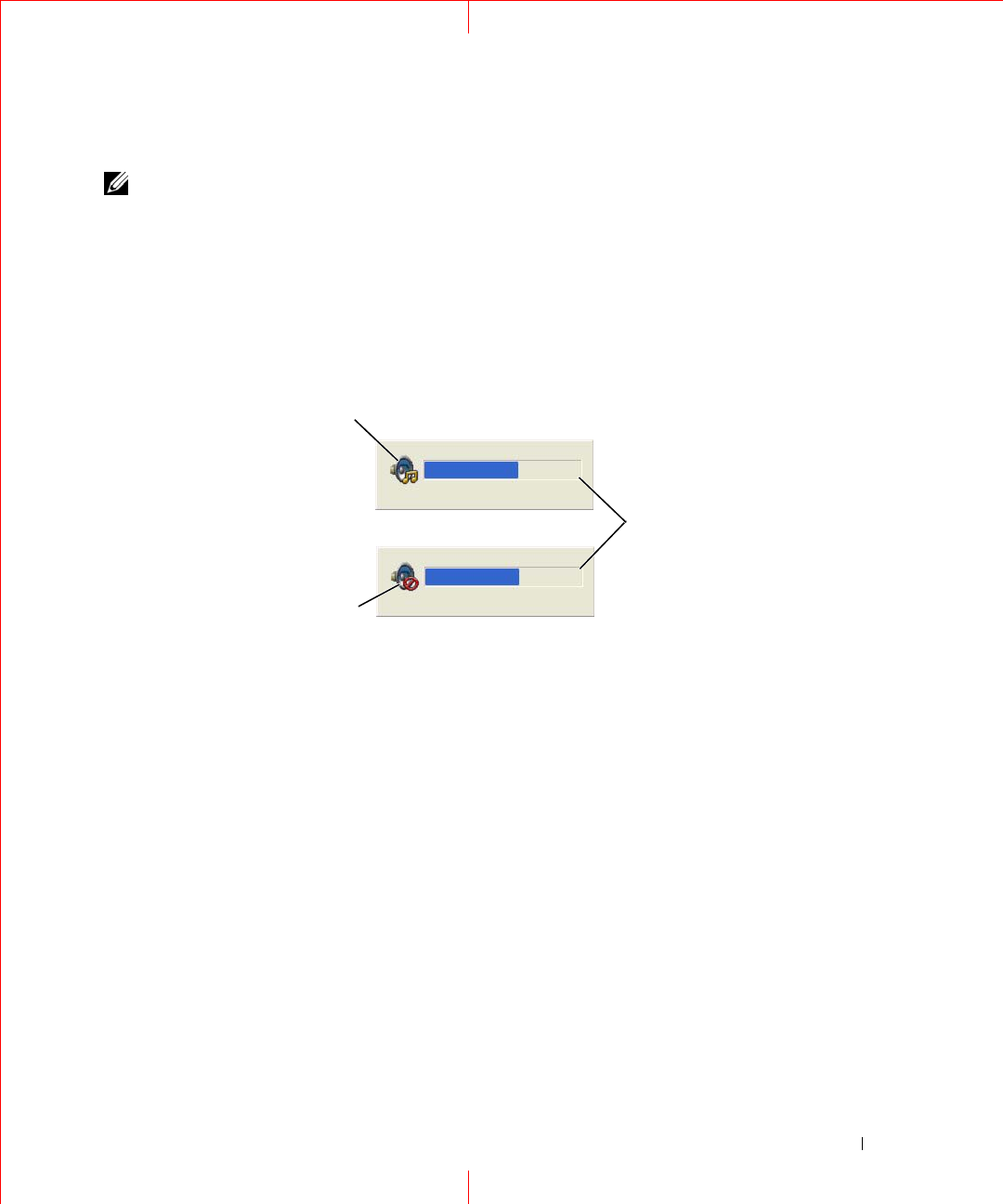
Using Multimedia 59
FILE LOCATION: C:\Documents and Settings\reggie_davis\Desktop\Projects-07\BEN\Source\media.fm
DELL CONFIDENTIAL – PRELIMINARY 1/25/07 – FOR PROOF ONLY
Adjusting the Volume
NOTE: When the speakers are muted, you do not hear the media playing.
1
Open the
Volume Control
window.
2
Click and drag the bar in the
Volume Control
column and slide it up or down to increase or decrease
the volume.
For more information on volume control options, click Help in the Volume Control window.
The Volume Meter displays the current volume level, including mute, on your computer. Either click the
QuickSet icon in the taskbar and select or deselect Disable On Screen Volume Meter, or press the
volume control buttons to enable or disable the Volume Meter on the screen.
When the meter is enabled, adjust the volume with the volume control buttons.
For more information about QuickSet, right-click the icon in the taskbar and click Help.
Adjusting the Picture
If an error message notifies you that the current resolution and color depth are using too much memory
and preventing DVD playback, adjust the display properties.
Microsoft® Windows® XP Operating System
1
Click
Start
→
Control Panel
→
Appearance and Themes
.
2
Under
Pick a task...
, click
Change the screen resolution
.
3
Under
Screen resolution
, click and drag the bar to reduce the resolution setting.
4
In the drop-down menu under
Color quality
, click
Medium (16 bit).
5
Click
OK
.
1volume icon 2Volume Meter 3mute icon
1
3
2

60 Using Multimedia
FILE LOCATION: C:\Documents and Settings\reggie_davis\Desktop\Projects-07\BEN\Source\media.fm
DELL CONFIDENTIAL – PRELIMINARY 1/25/07 – FOR PROOF ONLY
Microsoft Windows Vista™ Operating System
1
Click the Windows Vista Start button
, ,
and click
Control Panel
→
Appearance and
Personalization
.
2
Under
Personalization
, click
Adjust Screen Resolution
.
3
Under
Resolution:
click and drag the bar to reduce the resolution setting.
4
In the drop-down menu under
Colors
, click
Medium (16 bit)
and click
OK
.

FILE LOCATION: C:\Documents and Settings\reggie_davis\Desktop\Projects-07\BEN\Source\cards.fm
DELL CONFIDENTIAL – PRELIMINARY 1/25/07 – FOR PROOF ONLY
Template Last Updated - 7/01/2005 Using Cards 61
1
Using Cards
NOTE: Electrical and electronic devices are sensitive to electrostatic discharge (ESD). If a substantial ESD
occurs, the device may reset and the device software may attempt to reinitialize a connection. If the software
is not operational after an ESD occurrence, restart the modem software program.
Card Types
PC Cards
See "PC Card" on page 163 for information on supported PC Cards.
NOTE: A PC Card is not a bootable device.
The PC Card slot has one connector that supports a single Type I or Type II card. The PC Card slot
supports CardBus technology and extended PC Cards. "Type" of card refers to its thickness, not its
functionality.
Smart Cards
Smart cards provide valuable tools for security, data storage, and special programs (see "Smart Card"
on page 65).
Card Blanks
Your computer shipped with a plastic blank installed in the card slots. Blanks protect unused slots
from dust and other particles. Save the blank for use when no card is installed in the slots; blanks
from other computers may not fit your computer.
To remove a blank, see "Removing a Card or Blank" on page 62.
Extended Cards
An extended PC Card (for example, a wireless network adapter) is longer than a standard PC Card
and extends outside the computer. Follow these precautions when using extended PC Cards:
• Protect the exposed end of an installed card. Striking the end of the card can damage the system
board.
• Always remove an extended PC Card before you pack the computer in its carrying case.
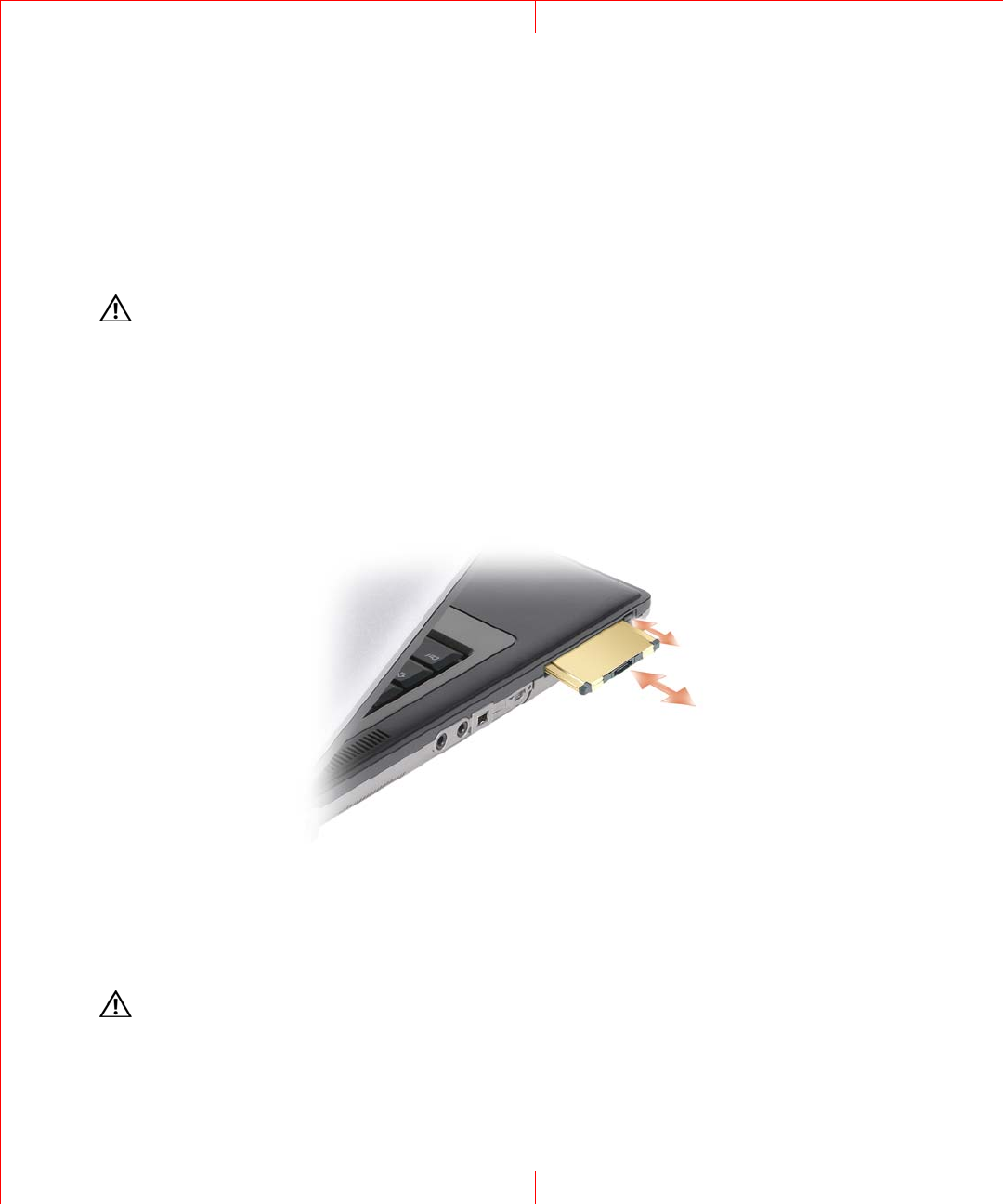
62 Using Cards
FILE LOCATION: C:\Documents and Settings\reggie_davis\Desktop\Projects-07\BEN\Source\cards.fm
DELL CONFIDENTIAL – PRELIMINARY 1/25/07 – FOR PROOF ONLY
Installing a PC Card
You can install a PC Card in the computer while the computer is running. The computer automatically
detects the card.
PC Cards are generally marked with a symbol (such as a triangle or an arrow) to indicate which end to
insert into the slot. The cards are keyed to prevent incorrect insertion. If card orientation is not clear, see
the documentation that came with the card.
CAUTION: Before you begin any of the procedures in this section, follow the safety instructions in the
Product
Information Guide
.
PC Card
1
Hold the card with its orientation symbol pointing into the slot and the top side of the card facing up.
The latch may need to be in the "in" position before you insert the card.
2
Slide the card into the slot until the card is completely seated in its connector.
If you encounter too much resistance, do not force the card. Check the card orientation and try again.
The computer recognizes most PC Cards and automatically loads the appropriate device driver. If the
configuration program tells you to load the manufacturer's drivers, use the floppy disk or CD that came
with the PC Card.
Removing a Card or Blank
CAUTION: Before you begin any of the procedures in this section, follow the safety instructions in the
Product
Information Guide
.

Using Cards 63
FILE LOCATION: C:\Documents and Settings\reggie_davis\Desktop\Projects-07\BEN\Source\cards.fm
DELL CONFIDENTIAL – PRELIMINARY 1/25/07 – FOR PROOF ONLY
NOTICE: Click the icon in the taskbar to select a card and stop it from functioning before you remove it from
the computer. If you do not stop the card in the configuration utility, you could lose data. Do not attempt to eject a
card by pulling its cable, if one is attached.
Press the latch and remove the card or blank. For some latches, you must press the latch twice: once to
pop the latch out, and then a second time to pop the card out.

64 Using Cards
FILE LOCATION: C:\Documents and Settings\reggie_davis\Desktop\Projects-07\BEN\Source\cards.fm
DELL CONFIDENTIAL – PRELIMINARY 1/25/07 – FOR PROOF ONLY
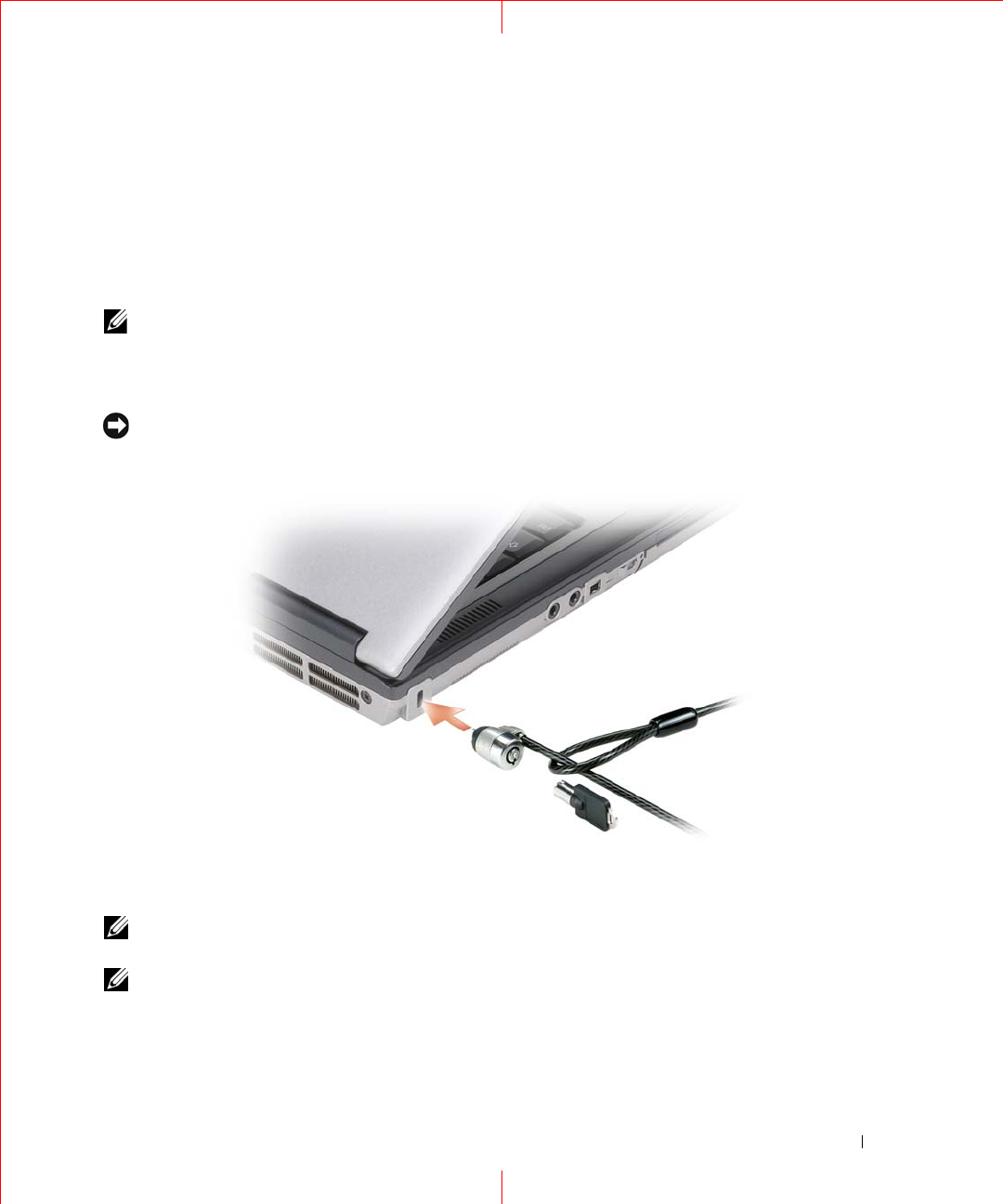
FILE LOCATION: C:\Documents and Settings\reggie_davis\Desktop\Projects-07\BEN\Source\security.fm
DELL CONFIDENTIAL – PRELIMINARY 1/25/07 – FOR PROOF ONLY
Template Last Updated - 7/01/2005 Securing Your Computer 65
1
Securing Your Computer
Security Cable Lock
NOTE: Your computer does not ship with a security cable lock.
A security cable lock is a commercially available antitheft device. To use the lock, attach it to the
security cable slot on your Dell™ computer. For more information, see the instructions included
with the device.
NOTICE: Before you buy an antitheft device, ensure that it will work with the security cable slot on your
computer.
Smart Card
NOTE: For information on how to secure your computer while traveling, see "Traveling With Your Computer"
on page 133.
NOTE: The smart card feature may not be available on your computer.
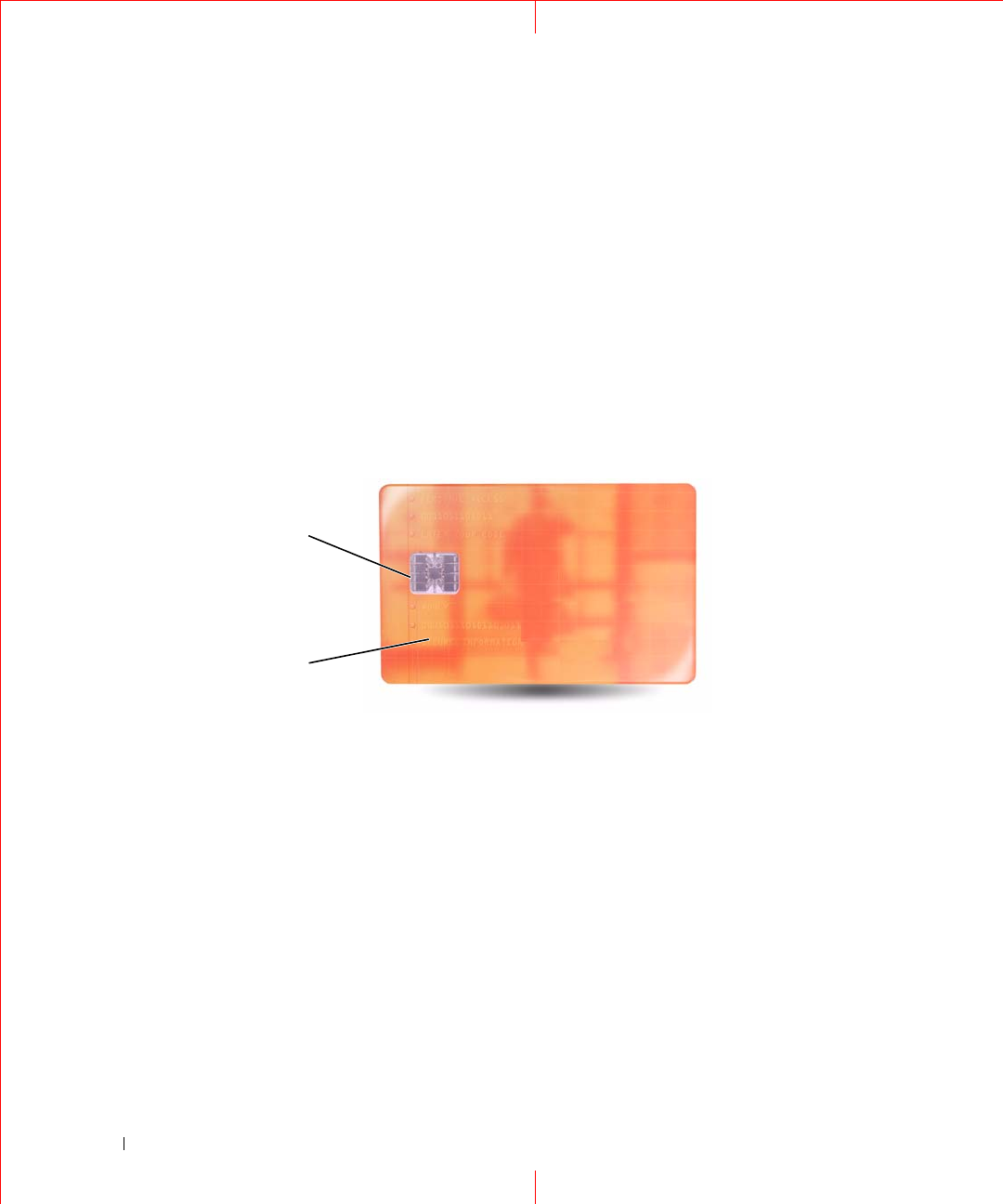
66 Securing Your Computer
FILE LOCATION: C:\Documents and Settings\reggie_davis\Desktop\Projects-07\BEN\Source\security.fm
DELL CONFIDENTIAL – PRELIMINARY 1/25/07 – FOR PROOF ONLY
About Smart Cards
Smart cards are portable credit-card shaped devices with internal integrated circuits. The top surface of
the smart card usually contains an embedded processor under the gold contact pad. The combination of
the small size and integrated circuits make smart cards valuable tools for security, data storage, and
special programs. Using smart cards can improve system security by combining something a user has (the
smart card) with something only the user should know (a PIN) to provide more secure user-
authentication than passwords alone.
Installing a Smart Card
You can install a smart card in the computer while the computer is running. The computer automatically
detects the card.
To install a smart card:
1
Hold the card so that the gold contact pad is facing upward and pointing toward the smart card slot.
2
Slide the smart card into the smart card slot until the card is completely seated in its connector. The
smart card will protrude approximately 1/2 inch from the slot. The smart card slot is located below the
PC Card slot.
If you encounter too much resistance, do not force the card. Check the card orientation and try again.
1gold contact pad 2smart card (top)
1
2
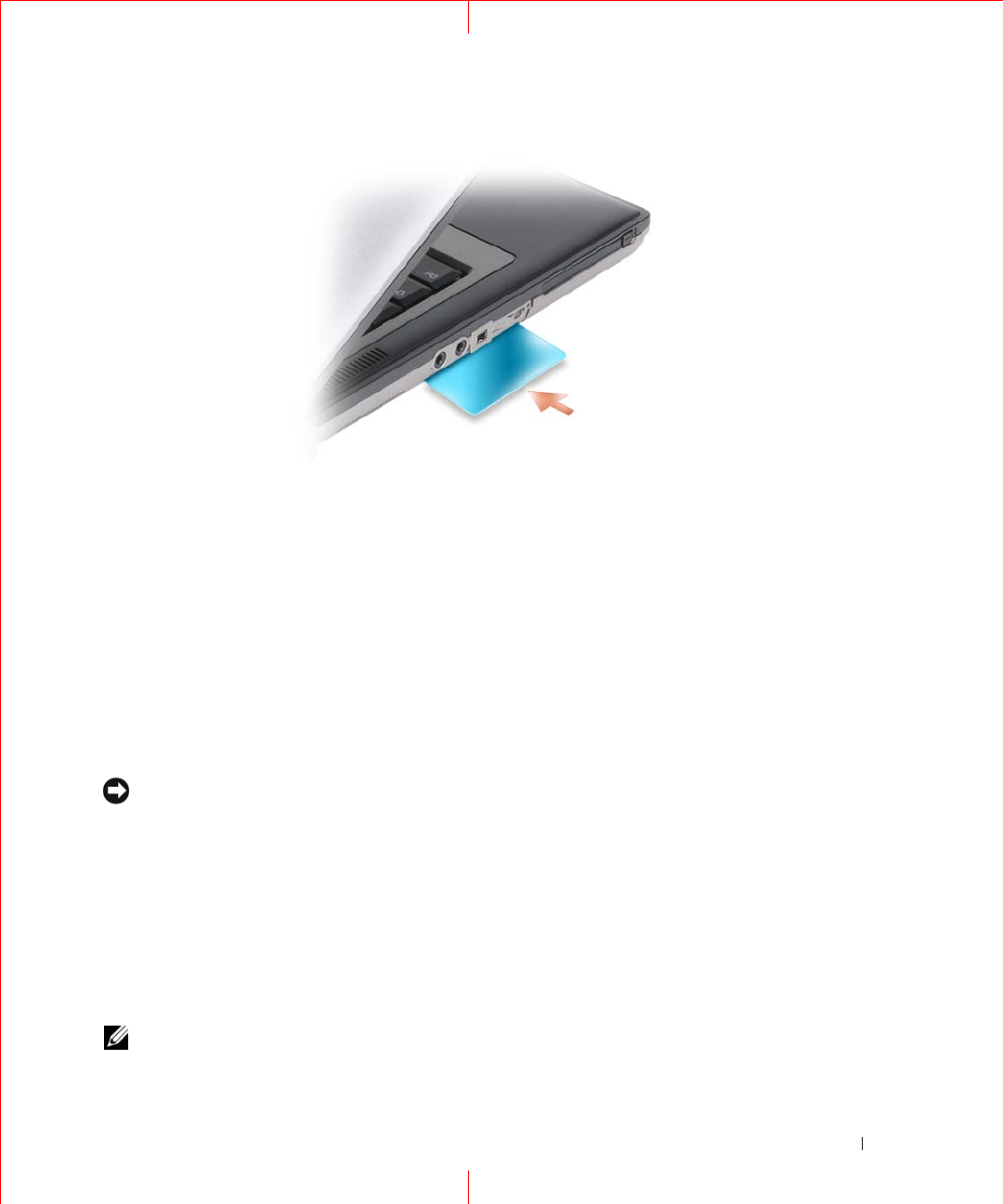
Securing Your Computer 67
FILE LOCATION: C:\Documents and Settings\reggie_davis\Desktop\Projects-07\BEN\Source\security.fm
DELL CONFIDENTIAL – PRELIMINARY 1/25/07 – FOR PROOF ONLY
Passwords
Passwords prevent unauthorized access to your computer. When using passwords, observe the following
guidelines:
• Choose a password that you can remember, but not one that is easy to guess. For example, do not use
the names of family members or pets for passwords.
• It is recommended that you do not write down your password. If you do write it down, however, ensure
that the password is stored in a secure place.
• Do not share your password with other people.
• Ensure that people are not watching you when you type your password.
NOTICE: Passwords provide a high level of security for data in your computer or hard drive. However, they are not
foolproof. If you require more security, obtain and use additional forms of protection, such as smart cards, data
encryption programs, or PC Cards with encryption features.
Use the User Accounts option in the Control Panel in the Microsoft® Windows® operating system to
create user accounts or to change passwords. Once you create a user password, you must enter it each
time you turn on or unlock your computer. If you do not enter a password within 2 minutes, the
computer returns to its previous operating state.
For more information, see your Windows documentation.
About Passwords
NOTE: Passwords are disabled when you receive your computer.

68 Securing Your Computer
FILE LOCATION: C:\Documents and Settings\reggie_davis\Desktop\Projects-07\BEN\Source\security.fm
DELL CONFIDENTIAL – PRELIMINARY 1/25/07 – FOR PROOF ONLY
A primary (or system) password, an administrator password, and a hard drive password all prevent
unauthorized access to your computer in different ways. The following table identifies types and features
of passwords available on your computer.
NOTE: Some hard drives do not support hard drive passwords.
NOTE: Passwords provide a high level of security for data in your computer or hard drive. However, they are not
foolproof. For security, the Dell Latitude D630 ships with a smart card reader.
When using passwords, observe the following guidelines:
• Choose passwords that you can remember, but not ones that are easy to guess. For example, do not use
the names of family members or pets for passwords.
• It is recommended that you do not write down passwords. If you do write it down, however, ensure that
the password is stored in a secure place.
• Do not share passwords with other people.
• Ensure that people are not watching you when you type your password(s).
NOTICE: Passwords provide a high level of security for data in your computer or hard drive. However, they are not
foolproof. If you require more security, obtain and use additional forms of protection, such as smart cards, data
encryption programs, or PC Cards with encryption features.
If you forget any of your passwords, contact Dell (see "Contacting Dell" on page 140). For your
protection, Dell technical support staff will ask you for proof of your identity to ensure that only an
authorized person can use the computer.
Using a Primary (or System) Password
The primary password allows you to protect the computer from unauthorized access.
When you first start your computer, you must assign a primary password at the prompt.
If you do not enter a password within 2 minutes, the computer returns to its previous operating state.
NOTICE: If you disable the administrator password, the primary password is also disabled.
To add or change passwords, access User Accounts from the Control Panel.
Type of Password Features
Primary (or system)
• Protects the computer from unauthorized access
Administrator
• Gives system administrators or service technicians
access to computers for repair or reconfiguration
• Allows you to restrict access to system setup in the same
way a primary password restricts access to the computer
• Can be used instead of the primary password
Hard drive
• Helps protect the data on your hard drive from
unauthorized access

Securing Your Computer 69
FILE LOCATION: C:\Documents and Settings\reggie_davis\Desktop\Projects-07\BEN\Source\security.fm
DELL CONFIDENTIAL – PRELIMINARY 1/25/07 – FOR PROOF ONLY
If you have assigned an administrator password, you can use it instead of the primary password. The
computer does not specifically prompt you for the administrator password.
Using an Administrator Password
The administrator password is designed to give system administrators or service technicians access to
computers for repair or reconfiguration. The administrators or technicians can assign identical
administrator passwords to groups of computers, allowing you to assign a unique primary password.
To set or change administrator passwords, access User Accounts from the Control Panel.
When you set an administrator password, the Configure Setup option becomes available in system
setup. The Configure Setup option allows you to restrict access to system setup in the same way that a
primary password restricts access to the computer.
The administrator password can be used instead of the primary password. Whenever you are prompted
to enter the primary password, you can enter the administrator password.
NOTICE: If you disable the administrator password, the primary password is also disabled.
NOTE: The administrator password provides access to the computer, but it does not provide access to the hard
drive when a hard drive password is assigned.
If you forget the primary password and do not have an administrator password assigned, or if you have
both a primary and an administrator password assigned but forget them both, contact your system
administrator or contact Dell (see "Obtaining Assistance" on page 135).
Using a Hard Drive Password
The hard drive password helps protect the data on your hard drive from unauthorized access.
To assign or change a hard drive password, enter system setup (see "System Setup Program" on page 97).
After assigning a hard drive password, you must enter it each time you turn on the computer and each
time you restore the computer to normal operation from standby mode.
If the hard drive password is enabled, you must enter it each time you turn on the computer: A message
appears asking for the hard drive password.
To continue, enter your password (with no more than eight characters) and press <Enter>.
If you do not enter a password within two minutes, the computer returns to its previous operating state.
If you enter the wrong password, a message tells you that the password is invalid. Press <Enter> to try
again.
If you do not enter the correct password in three attempts, the computer tries to start from another
bootable device if the Boot First Device option in system setup is set to allow start-up from another
device. If the Boot First Device option is not set to allow the computer to start from another device, the
computer returns to the operating state it was in when you turned it on.
If the hard drive password, the external hard-drive password, and the primary password are the same, the
computer prompts you only for the primary password. If the hard drive password is different from the
primary password, the computer prompts you for both. Two different passwords provide greater security.

70 Securing Your Computer
FILE LOCATION: C:\Documents and Settings\reggie_davis\Desktop\Projects-07\BEN\Source\security.fm
DELL CONFIDENTIAL – PRELIMINARY 1/25/07 – FOR PROOF ONLY
NOTE: The administrator password provides access to the computer, but it does not provide access to the hard
drive when a hard drive password is assigned.
Trusted Platform Module (TPM)
NOTE: The TPM feature supports encryption only if the operating system supports TPM. For more information, see
the TPM software documentation and the help files that came with the software.
TPM is a hardware-based security feature that can be used to create and manage computer-generated
encryption keys. When combined with security software, the TPM enhances existing network and
computer security by enabling features such as file protection capabilities and protected e-mail. The
TPM feature is enabled through a system setup option.
NOTICE: To secure your TPM data and encryption keys, follow the backup procedures documented in the
Broadcom Secure Foundation Getting Started Guide. In the event of these backups being incomplete, lost, or
damaged, Dell will be unable to assist in the recovery of encrypted data.
Enabling the TPM Feature
1
Enable the TPM software:
a
Restart the computer and press <F2> during the Power On Self Test to enter the system setup
program.
b
Select
Security
→
TPM Security
and press <Enter>.
c
Under
TPM Security
, select
On
.
d
Press <Esc> to exit the setup program.
e
If prompted, click
Save/Exit
.
2
Activate the TPM setup program:
a
Restart the computer and press <F2> during the Power On Self Test to enter the system setup
program.
b
Select
Security
→
TPM Activation
and press <Enter>.
c
Under
TPM Activation
, select
Activate
and press <Enter>.
NOTE: You only need to activate the program once.
d
Once the process is complete, the computer either restarts automatically or prompts you to restart
your computer.
Security Management Software
The security management software is designed to utilize four different features to help you secure your
computer:
• Log-in management
• Pre-boot authentication (using a fingerprint reader, smart card, or password)

Securing Your Computer 71
FILE LOCATION: C:\Documents and Settings\reggie_davis\Desktop\Projects-07\BEN\Source\security.fm
DELL CONFIDENTIAL – PRELIMINARY 1/25/07 – FOR PROOF ONLY
•Encryption
• Private information management
Activating the Security Management Software
NOTE: You must first enable the TPM in order for the security management software to have full functionality.
1
Enable the TPM feature (see "Enabling the TPM Feature" on page 70).
2
Load the security management software:
a
Turn on (or restart) your computer.
b
When the DELL™ logo appears, press <F2> immediately. If you wait too long and the Windows
logo appears, continue to wait until you see the Windows desktop. Then shut down your computer
and try again.
c
In the drop-down menu, select
Wave EMBASSY Trust Suite
and press <Enter> to create the
icons for the software components on the computer desktop.
d
Press <Esc> to exit the setup program.
e
If prompted, click
Save/Exit
.
Using the Security Management Software
For information about how to use the software and the different security features, see the Getting Started
Guide for the software:
Click Start
→
All Programs
→
Wave EMBASSY Trust Suite
→
Getting Started Guide
.
Computer Tracking Software
Computer tracking software may enable you to locate your computer if it is lost or stolen. The software is
optional and may be purchased when you order your Dell™ computer, or you can contact your Dell sales
representative for information about this security feature.
NOTE: Computer tracking software may not be available in certain countries.
NOTE: If you have computer tracking software and your computer is lost or stolen, you must contact the company
that provides the tracking service to report the missing computer.
If Your Computer Is Lost or Stolen
• Call a law enforcement agency to report the lost or stolen computer. Include the Service Tag in your
description of the computer. Ask that a case number be assigned and write down the number, along
with the name, address, and phone number of the law enforcement agency. If possible, obtain the
name of the investigating officer.
NOTE: If you know where the computer was lost or stolen, call a law enforcement agency in that area. If you do not
know, call a law enforcement agency where you live.

72 Securing Your Computer
FILE LOCATION: C:\Documents and Settings\reggie_davis\Desktop\Projects-07\BEN\Source\security.fm
DELL CONFIDENTIAL – PRELIMINARY 1/25/07 – FOR PROOF ONLY
• If the computer belongs to a company, notify the security office of the company.
• Contact Dell customer service to report the missing computer. Provide the computer Service Tag, the
case number, and the name, address, and phone number of the law enforcement agency to which you
reported the missing computer. If possible, give the name of the investigating officer.
The Dell customer service representative will log your report under the computer Service Tag and record
the computer as missing or stolen. If someone calls Dell for technical assistance and gives your Service
Tag, the computer is identified automatically as missing or stolen. The representative will attempt to get
the phone number and address of the caller. Dell will then contact the law enforcement agency to which
you reported of the missing computer.

73
FILE LOCATION: C:\Documents and Settings\reggie_davis\Desktop\Projects-07\BEN\Source\cleaning.fm
DELL CONFIDENTIAL – PRELIMINARY 1/25/07 – FOR PROOF ONLY
Cleaning Your Computer
CAUTION: Before you begin any of the procedures in this section, follow the safety instructions in the
Product
Information Guide
.
Computer, Keyboard, and Display
CAUTION: Before you clean your computer, disconnect the computer from the electrical outlet and remove any
installed batteries. Clean your computer with a soft cloth dampened with water. Do not use liquid or aerosol
cleaners, which may contain flammable substances.
• Use a can of compressed air to remove dust from between the keys on the keyboard.
NOTICE: To avoid damaging the computer or display, do not spray cleaning solution directly onto the display. Only
use products specifically designed for cleaning displays, and follow the instructions that are included with the
product.
• Moisten a soft, lint-free cloth with either water or a display cleaner, and wipe the display until it is
clean.
NOTICE: To prevent damage to the antiglare coating, do not wipe the display with soap or alcohol.
• Moisten a soft, lint-free cloth with water and wipe the computer and keyboard. Do not allow water
from the cloth to seep between the touch pad and the surrounding palm rest.
• To clean your monitor screen, lightly dampen a soft, clean cloth with water. You can also use a special
screen-cleaning tissue or solution suitable for the monitor’s antistatic coating.
• Wipe the keyboard, computer, and monitor plastics with a soft cleaning cloth moistened with a
solution of three parts water and one part dishwashing detergent.
Do not soak the cloth or let water drip inside your computer or keyboard.
Touch Pad
1
Shut down and turn off your computer.
2
Disconnect any attached devices from the computer and from their electrical outlets.
3
Remove any installed batteries (see "Replacing the Battery" on page 37).
4
Moisten a soft, lint-free cloth with water, and wipe it gently across the surface of the touch pad. Do not
allow water from the cloth to seep between the touch pad and the surrounding palm rest.
Mouse
NOTICE: Disconnect the mouse from the computer before cleaning the mouse
If your screen cursor skips or moves abnormally, clean the mouse.
Cleaning a Non-Optical Mouse
1
Clean the outside casing of the mouse with a cloth moistened with a mild cleaning solution.

74
FILE LOCATION: C:\Documents and Settings\reggie_davis\Desktop\Projects-07\BEN\Source\cleaning.fm
DELL CONFIDENTIAL – PRELIMINARY 1/25/07 – FOR PROOF ONLY
2
Turn the retainer ring on the underside of your mouse counterclockwise, and then remove the ball.
3
Wipe the ball with a clean, lint-free cloth.
4
Blow carefully into the ball cage or use a can of compressed air to dislodge dust and lint.
5
If the rollers inside the ball cage are dirty, clean the rollers with a cotton swab moistened lightly with
isopropyl alcohol.
6
Recenter the rollers in their channels if they are misaligned. Ensure that fluff from the swab is not left
on the rollers.
7
Replace the ball and retainer ring, and turn the retainer ring clockwise until it clicks into place.
Cleaning an Optical Mouse
Clean the outside casing of the mouse with a cloth moistened with a mild cleaning solution.
Floppy Drive
NOTICE: Do not attempt to clean drive heads with a swab. You might accidentally misalign the heads which
prevents the drive from operating.
Clean your floppy drive using a commercially available cleaning kit. These kits contain pretreated floppy
disks to remove contaminants that accumulate during normal operation.
CDs and DVDs
NOTICE: Always use compressed air to clean the lens in the CD/DVD drive, and follow the instructions that come
with the compressed-air product. Never touch the lens in the drive.
If you notice problems, such as skipping, with the playback quality of your CDs or DVDs, try cleaning
the discs.
1
Hold the disc by its outer edge. You can also touch the inside edge of the center hole.
NOTICE: To avoid damaging the surface, do not wipe in a circular motion around the disc.
2
With a soft, lint-free cloth, gently wipe the bottom of the disc (the unlabeled side) in a straight line
from the center to the outer edge of the disc.
For stubborn dirt, try using water or a diluted solution of water and mild soap. You can also purchase
commercial products that clean discs and provide some protection from dust, fingerprints, and
scratches. Cleaning products for CDs are also safe to use on DVDs.

FILE LOCATION: C:\Documents and Settings\reggie_davis\Desktop\Projects-07\BEN\Source\trouble.fm
DELL CONFIDENTIAL – PRELIMINARY 1/25/07 – FOR PROOF ONLY
Template Last Updated - 7/01/2005 Troubleshooting 75
2
Troubleshooting
Dell™ Technical Update Service
The Dell Technical Update service provides proactive e-mail notification of software and hardware
updates for your computer. The service is free and can be customized for content, format, and how
frequently you receive notifications.
To enroll for the Dell Technical Update service, go to http://support.dell.com/technicalupdate.
Dell Diagnostics
Fill out the Diagnostics Checklist (see "Diagnostics Checklist" on page 139) as you complete these
checks.
CAUTION: Before you begin any of the procedures in this section, follow the safety instructions in the
Product Information Guide
.
When to Use the Dell Diagnostics
If you experience a problem with your computer, perform the checks in "Lockups and Software
Problems" on page 86 and run the Dell Diagnostics before you contact Dell for technical assistance.
It is recommended that you print these procedures before you begin.
NOTICE: The Dell Diagnostics works only on Dell™ computers.
NOTE: The Drivers and Utilities media is optional and may not ship with your computer.
Enter the System Setup Program (see "System Setup Program" on page 97), review your computer’s
configuration information, and ensure that the device you want to test displays in system setup and
is active.
Start the Dell Diagnostics from your hard drive or from the Drivers and Utilities media.
Starting the Dell Diagnostics From Your Hard Drive
The Dell Diagnostics is located on a hidden diagnostic utility partition on your hard drive.
NOTE: If your computer cannot display a screen image, contact Dell (see "Contacting Dell" on page 140).
1
If the computer is connected to a docking device (docked), undock it. See the documentation that
came with your docking device for instructions. Ensure the computer is connected to a known
good electrical outlet.

76 Troubleshooting
FILE LOCATION: C:\Documents and Settings\reggie_davis\Desktop\Projects-07\BEN\Source\trouble.fm
DELL CONFIDENTIAL – PRELIMINARY 1/25/07 – FOR PROOF ONLY
2
Turn on (or restart) your computer.
3
Diagnostics can be invoked one of two ways:
a
When the DELL™ logo appears, press <F12> immediately. Select Diagnostics from the boot
menu and press <Enter>.
NOTE: If you wait too long and the operating system logo appears, continue to wait until you see the
Microsoft® Windows® desktop; then, shut down your computer and try again.
NOTE: Before attempting option B, the computer must be powered down completely.
b
Press and hold the <Fn> key while powering the computer on.
NOTE: If you see a message stating that no diagnostics utility partition has been found, run the Dell
Diagnostics from the Drivers and Utilities media.
The computer runs the Pre-boot System Assessment, a series of initial tests of your system board,
keyboard, display, memory, hard drive, etc.
• During the assessment, answer any questions that appear.
• If a failure is detected, the computer stops and beeps. To stop the assessment and restart the
computer, press <N>; to continue to the next test, press <Y>; to retest the component that
failed, press <R>.
• If failures are detected during the Pre-boot System Assessment, write down the error code(s) and
contact Dell.
If the Pre-boot System Assessment completes successfully, you will receive the following message:
Booting Dell Diagnostic Utility Partition. Press any key to continue.
4
Press any key to start the Dell Diagnostics from the diagnostics utility partition on your hard drive.
Starting the Dell Diagnostics from the Drivers and Utilities Media
1
Insert the
Drivers and Utilities
media.
2
Shut down and restart the computer.
When the DELL logo appears, press <F12> immediately.
NOTE: If you wait too long and the operating system logo appears, continue to wait until you see the
Microsoft® Windows® desktop; then, shut down your computer and try again.
NOTE: The next steps change the boot sequence for one time only. On the next start-up, the computer boots
according to the devices specified in the system setup program.
3
When the boot device list appears, highlight
IDE CD-ROM DeviceCD/DVD/CD-RW Drive
and
press <Enter>.
4
Select the
Boot from CD-ROM
option from the menu that appears and press <Enter>.
5
Ty p e
1
to start the media menu and press <Enter> to proceed.
6
Select
Run the 32 Bit Dell Diagnostics
from the numbered list. If multiple versions are listed, select
the version appropriate for your computer.

Troubleshooting 77
FILE LOCATION: C:\Documents and Settings\reggie_davis\Desktop\Projects-07\BEN\Source\trouble.fm
DELL CONFIDENTIAL – PRELIMINARY 1/25/07 – FOR PROOF ONLY
7
When the Dell Diagnostics
Main Menu
appears, select the test you want to run.
Dell Diagnostics Main Menu
1
After the Dell Diagnostics loads and the
Main
Menu
screen appears, click the button for the option
you want.
2
If a problem is encountered during a test, a message appears with an error code and a description of the
problem. Write down the error code and problem description and follow the instructions on the
screen.
If you cannot resolve the error condition, contact Dell (see "Obtaining Assistance" on page 135).
NOTE: The Service Tag for your computer is located at the top of each test screen. If you contact Dell,
technical support will ask for your Service Tag.
3
If you run a test from the
Custom Test
or
Symptom Tree
option, click the applicable tab described in
the following table for more information.
Option Function
Express Test Performs a quick test of devices. This test typically takes
10 to 20 minutes and requires no interaction on your
part. Run Express Test first to increase the possibility of
tracing the problem quickly.
Extended Test Performs a thorough check of devices. This test typically
takes 1 hour or more and requires you to answer
questions periodically.
Custom Test Tests a specific device. You can customize the tests you
want to run.
Symptom Tree Lists the most common symptoms encountered and
allows you to select a test based on the symptom of the
problem you are having.
Tab Function
Results Displays the results of the test and any error conditions
encountered.
Errors Displays error conditions encountered, error codes, and
the problem description.
Help Describes the test and may indicate requirements for
running the test.

78 Troubleshooting
FILE LOCATION: C:\Documents and Settings\reggie_davis\Desktop\Projects-07\BEN\Source\trouble.fm
DELL CONFIDENTIAL – PRELIMINARY 1/25/07 – FOR PROOF ONLY
4
When the tests are completed, if you are running the Dell Diagnostics from the
Drivers and Utilities
media
,
remove the media.
5
When the tests are complete, close the test screen to return to the
Main
Menu
screen. To exit the Dell
Diagnostics and restart the computer, close the
Main
Menu
screen.
Dell Support Utility
The Dell Support Utility is installed on your computer and available from the Dell Support icon on the
taskbar or from the Start button. Use this support utility for self-support information, software updates,
and health scans of your computing environment.
Accessing the Dell Support Utility
Access the Dell Support Utility from the Dell Support icon on the taskbar or from the Start menu.
If the Dell Support icon does not appear in your taskbar:
1
Click the
Start
button and point to
Programs
.
2
Click
Dell Support
and point to
Dell Support Settings
.
3
Ensure that the
Show icon on the taskbar
option is checked.
NOTE: If the Dell Support Utility is not available from the Start menu, go to support.dell.com and download the
software.
The Dell Support Utility is customized for your computing environment.
The Dell Support icon in the taskbar functions differently when you click, double-click, or right-click the
icon.
Clicking the Dell Support Icon
Click or right-click the
icon to perform the following tasks:
• Check your computing environment
Configuration Displays your hardware configuration for the selected
device.
The Dell Diagnostics obtains configuration information
for all devices from system setup, memory, and various
internal tests, and it displays the information in the
device list in the left pane of the screen. The device list
may not display the names of all the components
installed on your computer or all devices attached to your
computer.
Parameters Allows you to customize the test by changing the test
settings.
Tab Function
(continued)

Troubleshooting 79
FILE LOCATION: C:\Documents and Settings\reggie_davis\Desktop\Projects-07\BEN\Source\trouble.fm
DELL CONFIDENTIAL – PRELIMINARY 1/25/07 – FOR PROOF ONLY
• View the Dell Support Utility settings
• Access the help file for the Dell Support Utility
• View frequently asked questions
• Learn more about the Dell Support Utility
• Turn the Dell Support Utility off
Double-Clicking the Dell Support Icon
Double-click the icon to manually check your computing environment, view frequently asked
questions, access the help file for the Dell Support Utility, and view Dell Support settings.
For more information about the Dell Support Utility, click the question mark (?) at the top of the Dell
Support screen.
Drive Problems
Fill out the Diagnostics Checklist (see "Diagnostics Checklist" on page 139) as you complete these
checks.
CAUTION: Before you begin any of the procedures in this section, follow the safety instructions in the
Product
Information Guide
.
ENSURE THAT MICROSOFT® WINDOWS® RECOGNIZES THE DRIVE —Click the Start button and click My
Computer. If the floppy, CD, or DVD drive is not listed, perform a full scan with your antivirus software
to check for and remove viruses. Viruses can sometimes prevent Windows from recognizing the drive.
TEST THE DRIVE —
• Insert another floppy disk, CD, or DVD to eliminate the possibility that the original one is defective.
• Insert a bootable floppy disk and restart the computer.
CLEAN THE DRIVE OR DISK.
ENSURE THAT THE CD IS SNAPPED ONTO THE SPINDLE.
CHECK THE CABLE CONNECTIONS.
CHECK FOR HARDWARE INCOMPATIBILITIES.
RUN THE DELL DIAGNOSTICS —
See "Dell Diagnostics" on page 75.
Media drive problems
NOTE: High-speed media drive vibration is normal and may cause noise, which does not indicate a defect in the
drive or the media.
NOTE: Because of different regions worldwide and different disc formats, not all DVD titles work in all DVD drives.

80 Troubleshooting
FILE LOCATION: C:\Documents and Settings\reggie_davis\Desktop\Projects-07\BEN\Source\trouble.fm
DELL CONFIDENTIAL – PRELIMINARY 1/25/07 – FOR PROOF ONLY
Problems writing to a CD/DVD-RW drive
CLOSE OTHER PROGRAMS —The CD/DVD-RW drive must receive a steady stream of data when writing.
If the stream is interrupted, an error occurs. Try closing all programs before you write to the CD/DVD-
RW.
TURN OFF STANDBY MODE IN WINDOWS BEFORE WRITING TO A CD/DVD-RW DISC —Search for the
keyword standby in the Windows Help and Support Center for information on power management
modes. To access the Help and Support Center, click Start→ Help and Support.
CHANGE THE WRITE SPEED TO A SLOWER RATE —See the help files for your media creation software.
If you cannot eject the CD, CD-RW, DVD, or DVD+RW drive tray
1
Ensure that the computer is shut down.
2
Straighten a paper clip and insert one end into the eject hole at the front of the drive; push firmly until
the tray is partially ejected.
3
Gently pull out the tray until it stops.
If you hear an unfamiliar scraping or grinding sound
• Ensure that the sound is not caused by the program that is running.
• Ensure that the disk or disc is inserted properly.
Hard drive problems
ALLOW THE COMPUTER TO COOL BEFORE TURNING IT ON —A hot hard drive may prevent the operating
system from starting. Try allowing the computer to return to room temperature before turning it on.
RUN CHECK DISK —
1
Click the
Start
button and click
My Computer
.
2
Right-click
Local Disk C:
.
3
Click
Properties
.
4
Click the
Tools
tab.
5
Under
Error-checking
, click
Check Now
.
6
Click
Scan for and attempt recovery of bad sectors
.
7
Click
Start
.
E-Mail, Modem, and Internet Problems
Fill out the Diagnostics Checklist (see "Diagnostics Checklist" on page 139) as you complete these
checks.
CAUTION: Before you begin any of the procedures in this section, follow the safety instructions in the
Product
Information Guide
.

Troubleshooting 81
FILE LOCATION: C:\Documents and Settings\reggie_davis\Desktop\Projects-07\BEN\Source\trouble.fm
DELL CONFIDENTIAL – PRELIMINARY 1/25/07 – FOR PROOF ONLY
NOTE: Connect the modem to an analog telephone jack only. The modem does not operate while it is connected to
a digital telephone network.
CHECK THE MICROSOFT OUTLOOK® EXPRESS SECURITY SETTINGS —If you cannot open your e-mail
attachments:
1
In Outlook Express, click
Tools
, click
Options
, and then click
Security
.
2
Click
Do not allow attachments
to remove the checkmark.
CHECK THE TELEPHONE LINE CONNECTION.
CHECK THE TELEPHONE JACK.
CONNECT THE MODEM DIRECTLY TO THE TELEPHONE WALL JACK.
USE A DIFFERENT TELEPHONE LINE —
•Verify that the telephone line is connected to the jack on the
modem. (The jack has either a green label or a connector-shaped icon next to it.)
• Ensure that you hear a click when you insert the telephone line connector into the modem.
• Disconnect the telephone line from the modem and connect it to a telephone. Listen for a dial tone.
• If you have other telephone devices sharing the line, such as an answering machine, fax machine, surge
protector, or line splitter, then bypass them and connect the modem directly to the telephone wall jack.
If you are using a line that is 3 m (10 ft) or more in length, try a shorter one.
RUN THE MODEM DIAGNOSTIC TOOL —Click the Start button, point to All Programs and then click
Modem Diagnostic Tool. Follow the instructions on the screen to identify and resolve modem problems.
VERIFY THAT THE MODEM IS COMMUNICATING WITH WINDOWS —
1
Click the
Start
button and click
Control Panel
.
2
Click
Printers and Other Hardware
.
3
Click
Phone and Modem Options
.
4
Click the
Modems
tab.
5
Click the COM port for your modem.
6
Click
Properties
, click the
Diagnostics
tab, and then click
Query Modem
to verify that the modem is
communicating with Windows.
If all commands receive responses, the modem is operating properly.
ENSURE THAT YOU ARE CONNECTED TO THE INTERNET —Ensure that you have subscribed to an Internet
provider. With the Outlook Express e-mail program open, click File. If Work Offline has a checkmark
next to it, click the checkmark to remove it and connect to the Internet. For help, contact your Internet
service provider.
SCAN THE COMPUTER FOR SPYWARE —If you are experiencing slow computer performance, you
frequently receive pop-up advertisements, or you are having problems connecting to the Internet, your
computer might be infected with spyware. Use an anti-virus program that includes anti-spyware
protection (your program may require an upgrade) to scan the computer and remove spyware. For more
information, go to support.dell.com and search for the keyword spyware.

82 Troubleshooting
FILE LOCATION: C:\Documents and Settings\reggie_davis\Desktop\Projects-07\BEN\Source\trouble.fm
DELL CONFIDENTIAL – PRELIMINARY 1/25/07 – FOR PROOF ONLY
Error Messages
Fill out the Diagnostics Checklist (see "Diagnostics Checklist" on page 139) as you complete these
checks.
CAUTION: Before you begin any of the procedures in this section, follow the safety instructions in the
Product
Information Guide
.
If the message is not listed, see the documentation for the operating system or the program that was
running when the message appeared.
AUXILIARY DEVICE FAILURE —The touch pad, track stick, or external mouse may be faulty. For an external
mouse, check the cable connection. Enable the Pointing Device option in the system setup program. If
the problem persists, contact Dell (see "Obtaining Assistance" on page 135).
BAD COMMAND OR FILE NAME —Ensure that you have spelled the command correctly, put spaces in the
proper place, and used the correct pathname.
CACHE DISABLED DUE TO FAILURE —The primary cache internal to the microprocessor has failed. Contact
Dell (see "Obtaining Assistance" on page 135).
CD DRIVE CONTROLLER FAILURE —The CD drive does not respond to commands from the computer (see
"Dell Support Utility" on page 78).
DATA ERROR —The hard drive cannot read the data (see "Dell Support Utility" on page 78).
DECREASING AVAILABLE MEMORY —One or more memory modules may be faulty or improperly seated.
Reinstall the memory modules and, if necessary, replace them (see "Memory Problems" on page 88).
DISK C: FAILED INITIALIZATION —The hard drive failed initialization. Run the hard drive tests in the Dell
Diagnostics (see "Dell Diagnostics" on page 75).
DRIVE NOT READY —The operation requires a hard drive in the bay before it can continue. Install a hard
drive in the hard drive bay (see "Drive Problems" on page 79).
ERROR READING PCMCIA CARD —The computer cannot identify the PC Card. Reinsert the card or try
another PC Card (see "Installing a PC Card" on page 62).
EXTENDED MEMORY SIZE HAS CHANGED —The amount of memory recorded in NVRAM does not match
the memory installed in the computer. Restart the computer. If the error appears again, contact Dell (see
"Obtaining Assistance" on page 135).
THE FILE BEING COPIED IS TOO LARGE FOR THE DESTINATION DRIVE —The file that you are trying to copy is
too large to fit on the disk, or the disk is too full. Try copying the file to a different disk or use a larger
capacity disk.
A FILENAME CANNOT CONTAIN ANY OF THE FOLLOWING CHARACTERS: \ / : * ? “ < > | — Do not use these
characters in filenames.
GATE A20 FAILURE —A memory module may be loose. Reinstall the memory modules and, if necessary,
replace them (see "Memory Problems" on page 88).
GENERAL FAILURE —The operating system is unable to carry out the command. The message is usually
followed by specific information—for example, Printer out of paper. Take the appropriate
action.

Troubleshooting 83
FILE LOCATION: C:\Documents and Settings\reggie_davis\Desktop\Projects-07\BEN\Source\trouble.fm
DELL CONFIDENTIAL – PRELIMINARY 1/25/07 – FOR PROOF ONLY
HARD-DISK DRIVE CONFIGURATION ERROR —The computer cannot identify the drive type. Shut down the
computer, remove the hard drive (see "Hard drive problems" on page 80), and boot the computer from
media. Then shut down the computer, reinstall the hard drive, and restart the computer. Run the Hard-
Disk Drive tests in the Dell Diagnostics (see "Dell Diagnostics" on page 75).
HARD-DISK DRIVE CONTROLLER FAILURE 0—The hard drive does not respond to commands from the
computer. Shut down the computer, remove the hard drive (see "Hard drive problems" on page 80), and
boot the computer from media. Then shut down the computer, reinstall the hard drive, and restart the
computer. If the problem persists, try another drive. Run the Hard-Disk Drive tests in the Dell
Diagnostics (see "Dell Diagnostics" on page 75).
HARD-DISK DRIVE FAILURE —The hard drive does not respond to commands from the computer. Shut
down the computer, remove the hard drive (see "Hard drive problems" on page 80), and boot the
computer from media. Then shut down the computer, reinstall the hard drive, and restart the computer.
If the problem persists, try another drive. Run the Hard-Disk Drive tests in the Dell Diagnostics (see
"Dell Diagnostics" on page 75).
HARD-DISK DRIVE READ FAILURE —The hard drive may be defective. Shut down the computer, remove
the hard drive (see "Hard drive problems" on page 80), and boot the computer from media. Then shut
down the computer, reinstall the hard drive, and restart the computer. If the problem persists, try another
drive. Run the Hard-Disk Drive tests in the Dell Diagnostics (see "Dell Diagnostics" on page 75).
INSERT BOOTABLE MEDIA —The operating system is trying to boot to nonbootable media. Insert bootable
media.
INVALID CONFIGURATION INFORMATION-PLEASE RUN SYSTEM SETUP PROGRAM —The system configuration
information does not match the hardware configuration. The message is most likely to occur after a
memory module is installed. Correct the appropriate options in the system setup program (see "System
Setup Program" on page 97).
KEYBOARD CLOCK LINE FAILURE —For external keyboards, check the cable connection. Run the Keyboard
Controller test in the Dell Diagnostics (see "Dell Diagnostics" on page 75).
KEYBOARD CONTROLLER FAILURE —For external keyboards, check the cable connection. Restart the
computer, and avoid touching the keyboard or the mouse during the boot routine. Run the Keyboard
Controller test in the Dell Diagnostics (see "Dell Diagnostics" on page 75).
KEYBOARD DATA LINE FAILURE —For external keyboards, check the cable connection. Run the Keyboard
Controller test in the Dell Diagnostics (see "Dell Diagnostics" on page 75).
KEYBOARD STUCK KEY FAILURE —For external keyboards or keypads, check the cable connection. Restart
the computer, and avoid touching the keyboard or keys during the boot routine. Run the Stuck Key test
in the Dell Diagnostics (see "Dell Diagnostics" on page 75).
MEMORY ADDRESS LINE FAILURE AT ADDRESS, READ VALUE EXPECTING VALUE —A memory module may be
faulty or improperly seated. Reinstall the memory modules and, if necessary, replace them (see "Memory
Problems" on page 88.
MEMORY ALLOCATION ERROR —The software you are attempting to run is conflicting with the operating
system, another program, or a utility. Shut down the computer, wait 30 seconds, and then restart it. Try
to run the program again. If the error message still appears, see the software documentation.

84 Troubleshooting
FILE LOCATION: C:\Documents and Settings\reggie_davis\Desktop\Projects-07\BEN\Source\trouble.fm
DELL CONFIDENTIAL – PRELIMINARY 1/25/07 – FOR PROOF ONLY
MEMORY DATA LINE FAILURE AT ADDRESS, READ VALUE EXPECTING VALUE —A memory module may be
faulty or improperly seated. Reinstall the memory modules (see "Memory Problems" on page 88) and, if
necessary, replace them.
MEMORY DOUBLE WORD LOGIC FAILURE AT ADDRESS, READ VALUE EXPECTING VALUE —A memory module
may be faulty or improperly seated. Reinstall the memory modules (see "Memory Problems" on page 88)
and, if necessary, replace them.
MEMORY ODD/EVEN LOGIC FAILURE AT ADDRESS, READ VALUE EXPECTING VALUE —A memory module may
be faulty or improperly seated. Reinstall the memory modules (see "Memory Problems" on page 88) and,
if necessary, replace them.
MEMORY WRITE/READ FAILURE AT ADDRESS, READ VALUE EXPECTING VALUE —A memory module may be
faulty or improperly seated. Reinstall the memory modules (see "Memory Problems" on page 88) and, if
necessary, replace them.
NO BOOT DEVICE AVAILABLE —The computer cannot find the hard drive. If the hard drive is your boot
device, ensure that the drive is installed, properly seated, and partitioned as a boot device.
NO BOOT SECTOR ON HARD DRIVE —The operating system may be corrupted. Contact Dell (see
"Obtaining Assistance" on page 135).
NO TIMER TICK INTERRUPT —A chip on the system board may be malfunctioning. Run the System Set
tests in the Dell Diagnostics (see "Dell Diagnostics" on page 75).
NOT ENOUGH MEMORY OR RESOURCES. EXIT SOME PROGRAMS AND TRY AGAIN —You have too many
programs open. Close all windows and open the program that you want to use.
OPERATING SYSTEM NOT FOUND —Reinstall the hard drive (see "Drive Problems" on page 79). If the
problem persists, contact Dell (see "Obtaining Assistance" on page 135).
OPTIONAL ROM BAD CHECKSUM —The optional ROM apparently failed. Contact Dell (see "Obtaining
Assistance" on page 135).
A REQUIRED .DLL FILE WAS NOT FOUND —The program that you are trying to open is missing an essential
file. Remove and then reinstall the program.
1
Click the
Start
button and click
Control Panel
.
2
Click
Add or Remove Programs
.
3
Select the program you want to remove.
4
Click
Remove
or
Change/Remove
and follow the prompts on the screen.
5
See the program documentation for installation instructions.
SECTOR NOT FOUND —The operating system cannot locate a sector on the hard drive. You may have a
defective sector or corrupted FAT on the hard drive. Run the Windows error-checking utility to check the
file structure on the hard drive. For instructions, access the Help and Support Center (click Start→ Help
and Support). If a large number of sectors are defective, back up the data (if possible), and then reformat
the hard drive.
SEEK ERROR —The operating system cannot find a specific track on the hard drive.

Troubleshooting 85
FILE LOCATION: C:\Documents and Settings\reggie_davis\Desktop\Projects-07\BEN\Source\trouble.fm
DELL CONFIDENTIAL – PRELIMINARY 1/25/07 – FOR PROOF ONLY
SHUTDOWN FAILURE —A chip on the system board may be malfunctioning. Run the System Set tests in
the Dell Diagnostics (see "Dell Diagnostics" on page 75).
TIME-OF-DAY CLOCK LOST POWER —System configuration settings are corrupted. Connect your computer
to an electrical outlet to charge the battery. If the problem persists, try to restore the data by entering the
system setup program. Then immediately exit the program. If the message reappears, contact Dell (see
"Obtaining Assistance" on page 135).
TIME-OF-DAY CLOCK STOPPED —The reserve battery that supports the system configuration settings may
require replacement (see "Coin-Cell Battery" on page 114).
TIME-OF-DAY NOT SET-PLEASE RUN THE SYSTEM SETUP PROGRAM —The time or date stored in the system
setup program does not match the system clock. Correct the settings for the Date and Time options (see
"System Setup Program" on page 97).
TIMER CHIP COUNTER 2 FAILED —A chip on the system board may be malfunctioning. Run the System
Set tests in the Dell Diagnostics (see "Dell Diagnostics" on page 75).
UNEXPECTED INTERRUPT IN PROTECTED MODE —The keyboard controller may be malfunctioning, or a
memory module may be loose. Run the System Memory tests and the Keyboard Controller test in the
Dell Diagnostics (see "Dell Diagnostics" on page 75).
X:\ IS NOT ACCESSIBLE. THE DEVICE IS NOT READY —Insert a disk into the drive and try again.
WARNING: BATTERY IS CRITICALLY LOW —The battery is running out of charge. Replace the battery, or
connect the computer to an electrical outlet. Otherwise, activate hibernate mode or shut down the
computer.
IEEE 1394 Device Problems
Fill out the Diagnostics Checklist (see "Diagnostics Checklist" on page 139) as you complete these
checks.
CAUTION: Before you begin any of the procedures in this section, follow the safety instructions in the
Product
Information Guide
.
ENSURE THAT THE IEEE 1394 DEVICE IS RECOGNIZED BY WINDOWS —
1
Click the
Start
button and click
Control Panel
.
2
Click
Printers and Other Hardware
.
If your IEEE 1394 device is listed, Windows recognizes the device.
IF YOU HAVE PROBLEMS WITH A DELL-PROVIDED IEEE 1394 DEVICE —
IF YOU HAVE PROBLEMS WITH AN IEEE 1394 DEVICE NOT PROVIDED BY DELL —
Contact Dell (
see "Obtaining Assistance" on page 135)
or the IEEE 1394 device manufacturer.
ENSURE THAT THE IEEE 1394 DEVICE IS PROPERLY INSERTED INTO THE CONNECTOR.

86 Troubleshooting
FILE LOCATION: C:\Documents and Settings\reggie_davis\Desktop\Projects-07\BEN\Source\trouble.fm
DELL CONFIDENTIAL – PRELIMINARY 1/25/07 – FOR PROOF ONLY
Keyboard Problems
Fill out the Diagnostics Checklist (see "Diagnostics Checklist" on page 139) as you complete these
checks.
CAUTION: Before you begin any of the procedures in this section, follow the safety instructions in the
Product
Information Guide
.
NOTE: Use the integrated keyboard when running the Dell Diagnostics or the system setup program. When you
attach an external keyboard, the integrated keyboard remains fully functional.
External Keyboard problems
NOTE: When you attach an external keyboard, the integrated keyboard remains fully functional.
CHECK THE KEYBOARD CABLE —Shut down the computer. Disconnect the keyboard cable and check it for
damage, and firmly reconnect the cable.
If you are using a keyboard extension cable, disconnect it and connect the keyboard directly to the
computer.
CHECK THE EXTERNAL KEYBOARD —
1
Shut down the computer, wait 1 minute, and turn it on again.
2
Verify that the numbers, capitals, and scroll lock lights on the keyboard blink during the boot routine.
3
From the Windows desktop, click the
Start
button, point to
Programs
, point to
Accessories
, and click
Notepad
.
4
Type some characters on the external keyboard and verify that they appear on the display.
If you cannot verify these steps, you may have a defective external keyboard.
TO VERIFY THAT THE PROBLEM IS WITH THE EXTERNAL KEYBOARD, CHECK THE INTEGRATED KEYBOARD —
1
Shut down the computer.
2
Disconnect the external keyboard.
3
Turn on the computer.
4
From the Windows desktop, click the
Start
button, point to
Programs
, point to
Accessories
, and click
Notepad
.
5
Type some characters on the internal keyboard and verify that they appear on the display.
If the characters appear now but did not with the external keyboard, you may have a defective external
keyboard. Contact Dell (see "Obtaining Assistance" on page 135).
RUN THE KEYBOARD DIAGNOSTICS TESTS —Run the PC-AT Compatible Keyboards tests in the Dell
Diagnostics (see "Dell Diagnostics" on page 75). If the tests indicate a defective external keyboard,
contact Dell (see "Obtaining Assistance" on page 135).

Troubleshooting 87
FILE LOCATION: C:\Documents and Settings\reggie_davis\Desktop\Projects-07\BEN\Source\trouble.fm
DELL CONFIDENTIAL – PRELIMINARY 1/25/07 – FOR PROOF ONLY
Unexpected characters
DISABLE THE NUMERIC KEYPAD —Press <Num Lk> to disable the numeric keypad if numbers are
displayed instead of letters. Verify that the numbers lock light is not lit.
Lockups and Software Problems
Fill out the Diagnostics Checklist (see "Diagnostics Checklist" on page 139) as you complete these
checks.
CAUTION: Before you begin any of the procedures in this section, follow the safety instructions in the
Product
Information Guide
.
The computer does not start up
ENSURE THAT THE AC ADAPTER IS FIRMLY CONNECTED TO THE COMPUTER AND TO THE ELECTRICAL OUTLET.
The computer stops responding
NOTICE: You might lose data if you are unable to perform an operating system shutdown.
TURN THE COMPUTER OFF —If you are unable to get a response by pressing a key on your keyboard or
moving your mouse, press and hold the power button for at least 8 to 10 seconds until the computer
turns off. Then restart your computer.
A program stops responding or crashes repeatedly
NOTE: Software usually includes installation instructions in its documentation or on a floppy disk or CD.
END THE PROGRAM —
1
Press <Ctrl><Shift><Esc> simultaneously.
2
Click
Task Ma n a ger
.
3
Click the program that is no longer responding.
4
Click
End Task
.
CHECK THE SOFTWARE DOCUMENTATION —If necessary, uninstall and then reinstall the program.
A program is designed for an earlier Microsoft® Windows® operating system
RUN THE PROGRAM COMPATIBILITY WIZARD —The Program Compatibility Wizard configures a program
so it runs in an environment similar to non-Windows operating system environments.
1
Click
Start
→
All Programs
→
Accessories
→
Program Compatibility Wizard
→
Next
.
2
Follow the instructions on the screen.

88 Troubleshooting
FILE LOCATION: C:\Documents and Settings\reggie_davis\Desktop\Projects-07\BEN\Source\trouble.fm
DELL CONFIDENTIAL – PRELIMINARY 1/25/07 – FOR PROOF ONLY
A solid blue screen appears
TURN THE COMPUTER OFF —If you are unable to get a response by pressing a key on your keyboard or
moving your mouse, press and hold the power button for at least 8 to 10 seconds until the computer
turns off. Then restart your computer.
Other software problems
CHECK THE SOFTWARE DOCUMENTATION OR CONTACT THE SOFTWARE MANUFACTURER FOR TROUBLESHOOTING
INFORMATION —
• Ensure that the program is compatible with the operating system installed on your computer.
• Ensure that your computer meets the minimum hardware requirements needed to run the software.
See the software documentation for information.
• Ensure that the program is installed and configured properly.
• Verify that the device drivers do not conflict with the program.
• If necessary, uninstall and then reinstall the program.
BACK UP YOUR FILES IMMEDIATELY.
USE A VIRUS-SCANNING PROGRAM TO CHECK THE HARD DRIVE, FLOPPY DISKS, OR CDS.
SAVE AND CLOSE ANY OPEN FILES OR PROGRAMS AND SHUT DOWN YOUR COMPUTER THROUGH THE Start MENU.
SCAN THE COMPUTER FOR SPYWARE —If you are experiencing slow computer performance, you
frequently receive pop-up advertisements, or you are having problems connecting to the Internet, your
computer might be infected with spyware. Use an anti-virus program that includes anti-spyware
protection (your program may require an upgrade) to scan the computer and remove spyware. For more
information, go to support.dell.com and search for the keyword spyware.
RUN THE DELL DIAGNOSTICS —See "Dell Diagnostics" on page 75. If all tests run successfully, the error
condition is related to a software problem.
Memory Problems
Fill out the Diagnostics Checklist (see "Diagnostics Checklist" on page 139) as you complete these
checks.
CAUTION: Before you begin any of the procedures in this section, follow the safety instructions in the
Product
Information Guide
.
IF YOU RECEIVE AN INSUFFICIENT MEMORY MESSAGE —
• Save and close any open files and exit any open programs you are not using to see if that resolves the
problem.
• See the software documentation for minimum memory requirements. If necessary, install additional
memory (s
ee "Memory Problems" on page 88).
• Reseat the memory modules to ensure that your computer is successfully communicating with the
memory (see "Memory Problems" on page 88).

Troubleshooting 89
FILE LOCATION: C:\Documents and Settings\reggie_davis\Desktop\Projects-07\BEN\Source\trouble.fm
DELL CONFIDENTIAL – PRELIMINARY 1/25/07 – FOR PROOF ONLY
• Run the Dell Diagnostics (see "Dell Diagnostics" on page 75).
IF YOU EXPERIENCE OTHER MEMORY PROBLEMS —
• Reseat the memory modules (see "Memory Problems" on page 88) to ensure that your computer is
successfully communicating with the memory.
• Ensure that you are following the memory installation guidelines (see "Memory Problems" on page 88).
• Run the Dell Diagnostics
(see "Dell Diagnostics" on page 75)
.
Network Problems
Fill out the Diagnostics Checklist (see "Diagnostics Checklist" on page 139) as you complete these
checks.
CAUTION: Before you begin any of the procedures in this section, follow the safety instructions in the
Product
Information Guide
.
General
CHECK THE NETWORK CABLE CONNECTOR —Ensure that the network cable is firmly inserted into both the
network connector on the back of the computer and the network connector.
CHECK THE NETWORK LIGHTS ON THE NETWORK CONNECTOR —No light indicates that no network
communication exists. Replace the network cable.
RESTART THE COMPUTER AND LOG ON TO THE NETWORK AGAIN.
CHECK YOUR NETWORK SETTINGS —Contact your network administrator or the person who set up your
network to verify that your network settings are correct and that the network is functioning.
Wireless Local Area Network (WLAN)
For information about troubleshooting wireless local area networks, see "Wireless Local Area Network"
on page 48.
Mobile Broadband (Wireless Wide Area Network)
NOTE: The Dell Mobile Broadband Card Utility user’s guide is available through the Windows Help and Support
Center. To access the Help and Support Center, click Start
→
Help and Support. You can also download the Dell
Mobile Broadband Card Utility user’s guide from support.dell.com.
NOTE: Remove any network cables from the computer and disable the WLAN card. To disable the WLAN card,
click Start
→
Connect To
→
Wireless Network Connection
→
Disable.
NOTE: The icon appears on the Windows desktop if the computer has a Dell Mobile Broadband card
installed. Double-click the icon to launch the utility. Once the utility has launched, the icon appears in the
notification area.

90 Troubleshooting
FILE LOCATION: C:\Documents and Settings\reggie_davis\Desktop\Projects-07\BEN\Source\trouble.fm
DELL CONFIDENTIAL – PRELIMINARY 1/25/07 – FOR PROOF ONLY
CANNOT CONNECT —The Dell Mobile Broadband Card must be activated on the network in order to
connect. Once the Dell Mobile Broadband Card Utility has been launched, position the mouse over the
icon in the taskbar to read the status of the connection. If the status indicates the mobile broadband
card is not activated, see "Activate your Mobile Broadband card" on page 90 for more information. If
problems persist, contact your Mobile Broadband service carrier for details on your plan.
CHECK YOUR MOBILE BROADBAND NETWORK SERVICE —Contact your Mobile Broadband service carrier to
verify coverage plan and supported services.
CHECK THE STATUS IN THE DELL MOBILE BROADBAND CARD UTILITY —Click the icon on the Windows
desktop to launch the utility. Check the status in the main window:
•
No card detected
– Restart the computer and launch the utility again.
•
Radio Off
– Ensure the Mobile Broadband card is enabled by viewing the status in the Dell Mobile
Broadband Card Utility. If the card is disabled, enable the Mobile Broadband card by clicking the
Tu rn
Radio On
button in the main screen of the Dell Mobile Broadband Card Utility.
•
Searching
– The Dell Mobile Broadband Card Utility has not yet located a Mobile Broadband
network. If the searching state persists, ensure that the signal strength is adequate.
•
No service
– The Dell Mobile Broadband Card Utility did not locate a Mobile Broadband network.
Ensure that the signal strength is adequate. Restart the Dell wireless utility or contact your Mobile
Broadband network provider.
•
Check your Mobile Broadband Network Service
– Contact your Mobile Broadband
network service provider to verify coverage plan and supported services.
ACTIVATE YOUR MOBILE BROADBAND CARD —Before you connect to the Internet, you must activate the
Mobile Broadband service through your cellular service provider. For instructions and for additional
information about using the Dell Mobile Broadband Card Utility, see the user's guide available through
the Windows Help and Support Center (click Start→ Help and Support). The user's guide is also
available on the Dell Support website at support.dell.com and on the media included with your Mobile
Broadband card if you purchased the card separately from your computer.
PC Card Problems
Fill out the Diagnostics Checklist (see "Diagnostics Checklist" on page 139) as you complete these
checks.
CAUTION: Before you begin any of the procedures in this section, follow the safety instructions in the
Product
Information Guide
.
CHECK THE CARD —Ensure that the card is properly inserted into the connector.
ENSURE THAT THE CARD IS RECOGNIZED BY WINDOWS —Double-click the Safely Remove Hardware icon
in the Windows taskbar. Ensure that the card is listed.
IF YOU HAVE PROBLEMS WITH A DELL-PROVIDED CARD —Contact Dell (see "Obtaining Assistance" on
page 135).
IF YOU HAVE PROBLEMS WITH A CARD NOT PROVIDED BY DELL —Contact the card manufacturer.

Troubleshooting 91
FILE LOCATION: C:\Documents and Settings\reggie_davis\Desktop\Projects-07\BEN\Source\trouble.fm
DELL CONFIDENTIAL – PRELIMINARY 1/25/07 – FOR PROOF ONLY
Power Problems
Fill out the Diagnostics Checklist (see "Diagnostics Checklist" on page 139) as you complete these
checks.
CAUTION: Before you begin any of the procedures in this section, follow the safety instructions in the
Product
Information Guide
.
CHECK THE POWER LIGHT —When the power light is lit or blinking, the computer has power. If the power
light is blinking, the computer is in standby mode—press the power button to exit standby mode. If the
light is off, press the power button to turn on the computer.
CHARGE THE BATTERY —The battery charge may be depleted.
1
Reinstall the battery.
2
Use the AC adapter to connect the computer to an electrical outlet.
3
Turn on the computer.
NOTE: Battery operating time (the time the battery can hold a charge) decreases over time. Depending on how
often the battery is used and the conditions under which it is used, you may need to purchase a new battery during
the life of your computer.
CHECK THE BATTERY STATUS LIGHT —If the battery status light flashes orange or is a steady orange the
battery charge is low or depleted. Connect the computer to an electrical outlet.
If the battery status light flashes green and orange, the battery is too hot to charge. Shut down the
computer, disconnect the computer from the electrical outlet, and then let the battery and computer
cool to room temperature.
If the battery status light rapidly flashes orange, the battery may be defective. Contact Dell (see
"Obtaining Assistance" on page 135).
CHECK THE BATTERY TEMPERATURE —If the battery temperature is below 0° C (32° F), the computer will
not start up.
TEST THE ELECTRICAL OUTLET —Ensure that the electrical outlet is working by testing it with another
device, such as a lamp.
CHECK THE AC ADAPTER —Check the AC adapter cable connections. If the AC adapter has a light,
ensure that the light is on.
CONNECT THE COMPUTER DIRECTLY TO AN ELECTRICAL OUTLET —Bypass power protection devices, power
strips, and the extension cable to verify that the computer turns on.
ELIMINATE POSSIBLE INTERFERENCE —Turn off nearby fans, fluorescent lights, halogen lamps, or other
appliances.
ADJUST THE POWER PROPERTIES —See "Configuring Power Management Settings" on page 36.
RESEAT THE MEMORY MODULES —If the computer power light turns on but the display remains blank,
reinstall the memory modules (see "Memory Problems" on page 88).

92 Troubleshooting
FILE LOCATION: C:\Documents and Settings\reggie_davis\Desktop\Projects-07\BEN\Source\trouble.fm
DELL CONFIDENTIAL – PRELIMINARY 1/25/07 – FOR PROOF ONLY
Ensuring Sufficient Power for Your Computer
Your computer is designed to use a 65-W or higher AC adapter.
Using AC adapters that are less-powerful than 65 W will cause you to receive a WARNING message.
Docking Power Considerations
Due to the extra power consumption when a computer is docked to the Dell D/Dock, normal computer
operation is not possible on battery power alone. Ensure that the AC adapter is connected to your
computer when the computer is docked to the Dell D/Dock.
Docking While the Computer Is Running
If a computer is connected to the Dell D/Dock or Dell D/Port while the computer is running, presence of
the docking device is ignored until the AC adapter is connected to the computer.
AC Power Loss While the Computer Is Docked
If a computer loses AC power while docked to the Dell D/Dock or Dell D/Port, the computer
immediately goes into low-performance mode.
Printer Problems
Fill out the Diagnostics Checklist (see "Diagnostics Checklist" on page 139) as you complete these
checks.
CAUTION: Before you begin any of the procedures in this section, follow the safety instructions in the
Product
Information Guide
.
NOTE: If you need technical assistance for your printer, contact the printer’s manufacturer.
ENSURE THAT THE PRINTER IS TURNED ON.
CHECK THE PRINTER CABLE CONNECTIONS —
• See the printer documentation for cable connection information.
• Ensure that the printer cables are securely connected to the printer and the computer.
TEST THE ELECTRICAL OUTLET —Ensure that the electrical outlet is working by testing it with another
device, such as a lamp.
VERIFY THAT THE PRINTER IS RECOGNIZED BY WINDOWS —
1
Click the
Start
button, click
Control Panel
, and then click
Printers and Other Hardware
.
2
Click
View installed printers or fax printers
.
If the printer is listed, right-click the printer icon.
3
Click
Properties
and click the
Ports
tab. For a parallel printer, ensure that the
Print to the following
port(s):
setting is
LPT1 (Printer Port)
. For a USB printer, ensure that the
Print to the following
port(s):
setting is
USB
.

Troubleshooting 93
FILE LOCATION: C:\Documents and Settings\reggie_davis\Desktop\Projects-07\BEN\Source\trouble.fm
DELL CONFIDENTIAL – PRELIMINARY 1/25/07 – FOR PROOF ONLY
REINSTALL THE PRINTER DRIVER —See the printer documentation for instructions.
Scanner Problems
Fill out the Diagnostics Checklist (see "Diagnostics Checklist" on page 139) as you complete these
checks.
CAUTION: Before you begin any of the procedures in this section, follow the safety instructions in the
Product
Information Guide
.
NOTE: If you need technical assistance for your scanner, contact the scanner’s manufacturer.
CHECK THE SCANNER DOCUMENTATION —See the scanner documentation for setup and troubleshooting
information.
UNLOCK THE SCANNER —Ensure that your scanner is unlocked if it has a locking tab or button.
RESTART THE COMPUTER AND TRY THE SCANNER AGAIN.
CHECK THE CABLE CONNECTIONS —
• See the scanner documentation for cable connection information.
• Ensure that the scanner cables are securely connected to the scanner and the computer.
VERIFY THAT THE SCANNER IS RECOGNIZED BY MICROSOFT WINDOWS —
1
Click
Start
→
Control Panel
→
Printers and Other Hardware
.
2
Click
Scanners and Cameras
.
If your scanner is listed, Windows recognizes the scanner.
REINSTALL THE SCANNER DRIVER —See the scanner documentation for instructions.
Sound and Speaker Problems
Fill out the Diagnostics Checklist (see "Diagnostics Checklist" on page 139) as you complete these
checks.
CAUTION: Before you begin any of the procedures in this section, follow the safety instructions in the
Product
Information Guide
.
No sound from integrated speakers
ADJUST THE WINDOWS VOLUME CONTROL —Double-click the speaker icon in the lower-right corner of
your screen. Ensure that the volume is turned up and that the sound is not muted. Adjust the volume,
bass, or treble controls to eliminate distortion.
ADJUST THE VOLUME USING KEYBOARD SHORTCUTS —Press <Fn><End> to disable (mute) or reenable
the integrated speakers.
REINSTALL THE SOUND (AUDIO) DRIVER —See "Reinstalling Drivers and Utilities" on page 102.

94 Troubleshooting
FILE LOCATION: C:\Documents and Settings\reggie_davis\Desktop\Projects-07\BEN\Source\trouble.fm
DELL CONFIDENTIAL – PRELIMINARY 1/25/07 – FOR PROOF ONLY
No sound from external speakers
ENSURE THAT THE SUBWOOFER AND THE SPEAKERS ARE TURNED ON —See the setup diagram supplied with
the speakers. If your speakers have volume controls, adjust the volume, bass, or treble to eliminate
distortion.
ADJUST THE WINDOWS VOLUME CONTROL —Click or double-click the speaker icon in the lower-right
corner of your screen. Ensure that the volume is turned up and that the sound is not muted.
DISCONNECT HEADPHONES FROM THE HEADPHONE CONNECTOR —Sound from the speakers is automatically
disabled when headphones are connected to the computer’s front-panel headphone connector.
TEST THE ELECTRICAL OUTLET —Ensure that the electrical outlet is working by testing it with another
device, such as a lamp.
ELIMINATE POSSIBLE INTERFERENCE —Turn off nearby fans, fluorescent lights, or halogen lamps to check
for interference.
REINSTALL THE AUDIO DRIVER —
See "Reinstalling Drivers and Utilities" on page 102
.
RUN THE DELL DIAGNOSTICS —See "Dell Diagnostics" on page 75.
NOTE: The volume control in some MP3 players overrides the Windows volume setting. If you have been listening
to MP3 songs, ensure that you did not turn the player volume down or off.
No sound from headphones
CHECK THE HEADPHONE CABLE CONNECTION —Ensure that the headphone cable is securely inserted into
the headphone connector.
ADJUST THE WINDOWS VOLUME CONTROL —Click or double-click the speaker icon in the lower-right
corner of your screen. Ensure that the volume is turned up and that the sound is not muted.
Touch Pad or Mouse Problems
CHECK THE TOUCH PAD SETTINGS —
1
Click the
Start
button, click
Control Panel
, and then click
Printers and Other Hardware
.
2
Click
Mouse
.
3
Try adjusting the settings.
CHECK THE MOUSE CABLE —Shut down the computer. Disconnect the mouse cable, check it for damage,
and firmly reconnect the cable.
If you are using a mouse extension cable, disconnect it and connect the mouse directly to the computer.
TO VERIFY THAT THE PROBLEM IS WITH THE MOUSE, CHECK THE TOUCH PAD —
1
Shut down the computer.
2
Disconnect the mouse.
3
Turn on the computer.
4
At the Windows
desktop, use the touch pad to move the cursor around, select an icon, and open it.

Troubleshooting 95
FILE LOCATION: C:\Documents and Settings\reggie_davis\Desktop\Projects-07\BEN\Source\trouble.fm
DELL CONFIDENTIAL – PRELIMINARY 1/25/07 – FOR PROOF ONLY
If the touch pad operates correctly, the mouse may be defective.
CHECK THE SYSTEM SETUP PROGRAM SETTINGS —Verify that the system setup program lists the correct
device for the pointing device option. (The computer automatically recognizes a USB mouse without
making any setting adjustments.)
TEST THE MOUSE CONTROLLER —To test the mouse controller (which affects pointer movement) and the
operation of the touch pad or mouse buttons, run the Mouse test in the Pointing Devices test group in
the Dell Diagnostics (see "Dell Diagnostics" on page 75).
REINSTALL THE TOUCH PAD DRIVER —See "Reinstalling Drivers and Utilities" on page 102.
Video and Display Problems
Fill out the Diagnostics Checklist (see "Diagnostics Checklist" on page 139) as you complete these
checks.
CAUTION: Before you begin any of the procedures in this section, follow the safety instructions in the
Product
Information Guide
.
If the display is blank
NOTE: If you are using a program that requires a higher resolution than your computer supports, it is
recommended that you attach an external monitor to your computer.
CHECK THE BATTERY —If you are using a battery to power your computer, the battery charge may be
depleted. Connect the computer to an electrical outlet using the AC adapter, and turn on the computer.
TEST THE ELECTRICAL OUTLET —Ensure that the electrical outlet is working by testing it with another
device, such as a lamp.
CHECK THE AC ADAPTER —Check the AC adapter cable connections. If the AC adapter has a light,
ensure that the light is on.
CONNECT THE COMPUTER DIRECTLY TO AN ELECTRICAL OUTLET —Bypass power protection devices, power
strips, and the extension cable to verify that the computer turns on.
ADJUST THE POWER PROPERTIES —Search for the keyword standby in the Windows Help and Support
Center (click Start→ Help and Support).
SWITCH THE VIDEO IMAGE —If your computer is attached to an external monitor, press <Fn><F8> to
switch the video image to the display.
If the display is difficult to read
ADJUST THE BRIGHTNESS —Press <Fn> and the up- or down-arrow key
MOVE THE EXTERNAL SUBWOOFER AWAY FROM THE COMPUTER OR MONITOR —If your external speaker
system includes a subwoofer, ensure that the subwoofer is at least 60 cm (2 ft) away from the computer
or external monitor.
ELIMINATE POSSIBLE INTERFERENCE —Turn off nearby fans, fluorescent lights, halogen lamps, or other
appliances.

96 Troubleshooting
FILE LOCATION: C:\Documents and Settings\reggie_davis\Desktop\Projects-07\BEN\Source\trouble.fm
DELL CONFIDENTIAL – PRELIMINARY 1/25/07 – FOR PROOF ONLY
ROTATE THE COMPUTER TO FACE A DIFFERENT DIRECTION —Eliminate sunlight glare, which can cause poor
picture quality.
ADJUST THE WINDOWS DISPLAY SETTINGS —
1
Click the
Start
button and then click
Control Panel
.
2
Click
Appearance and Themes
.
3
Click the area you want to change or click the
Display
icon.
4
Try different settings for
Color quality
and
Screen resolution
.
RUN THE VIDEO DIAGNOSTICS TESTS —If no error message appears and you still have a display problem,
but the display is not completely blank, run the Video device group in the Dell Diagnostics. If the
problem persists, contact Dell (see "Obtaining Assistance" on page 135).
SEE "ERROR MESSAGES"—If an error message appears, see "Error Messages" on page 81.
If only part of the display is readable
CONNECT AN EXTERNAL MONITOR —
1
Shut down your computer and connect an external monitor to the computer.
2
Turn on the computer and the monitor and adjust the monitor brightness and contrast controls.
If the external monitor works, the computer display or video controller may be defective. Contact Dell
(see "Obtaining Assistance" on page 135).

System Setup Program 97
FILE LOCATION: C:\Documents and Settings\reggie_davis\Desktop\Projects-07\BEN\Source\setup.fm
DELL CONFIDENTIAL – PRELIMINARY 1/25/07 – FOR PROOF ONLY
System Setup Program
Overview
NOTE: Your operating system may automatically configure most of the options available in the system setup
program, thus overriding options that you set through the system setup program. (An exception is the External Hot
Key option, which you can disable or enable only through the system setup program.) For more information on
configuring features for your operating system, access the Help and Support Center (click Start
→
Help and
Support).
You can use the system setup program as follows:
• To set or change user-selectable features—for example, your computer password
• To verify information about the computer's current configuration, such as the amount of system
memory
After you set up the computer, run the system setup program to familiarize yourself with your system
configuration information and optional settings. You may want to write down the information for future
reference.
The system setup screens display the current setup information and settings for your computer, such as:
• System configuration
• Boot order
• Boot (start-up) configuration and docking-device configuration settings
• Basic device-configuration settings
• System security and hard-drive password settings
NOTE: Unless you are an expert computer user or are directed to do so by Dell technical support, do not change
the system setup settings. Certain changes might make your computer work incorrectly.
Viewing the System Setup Screens
1
Turn on (or restart) your computer.
2
When the DELL™ logo appears, press <F2> immediately. If you wait too long and the Microsoft
®
Windows
®
logo appears, continue to wait until you see the Windows desktop. Then shut down your
computer and try again.
System Setup Screens
NOTE: For information about a specific item on a system setup screen, highlight the item and see the Help area on
the screen.

98 System Setup Program
FILE LOCATION: C:\Documents and Settings\reggie_davis\Desktop\Projects-07\BEN\Source\setup.fm
DELL CONFIDENTIAL – PRELIMINARY 1/25/07 – FOR PROOF ONLY
On each screen, the system setup options are listed at the left. To the right of each option is the setting
or value for that option. You can change settings that appear as white type on the screen. Options or
values that you cannot change (because they are determined by the computer) appear less bright.
The upper-right corner of the screen displays help information for the currently highlighted option; the
lower-right corner displays information about the computer. System-setup key functions are listed across
the bottom of the screen.
Commonly Used Options
Certain options require that you reboot the computer for new settings to take effect.
Changing the Boot Sequence
The boot sequence, or boot order, tells the computer where to look to find the software needed to start the
operating system. You can control the boot sequence and enable/disable devices using the Boot Order
page of the system setup program.
NOTE: To change the boot sequence on a one-time-only basis, see "Performing a One-Time Boot" on page 98.
The Boot Order page displays a general list of the bootable devices that may be installed in your
computer, including but not limited to the following:
•
Diskette Drive
•
Modular bay HDD
•
Internal HDD
•
Optical Drive
During the boot routine, the computer starts at the top of the list and scans each enabled device for the
operating system start-up files. When the computer finds the files, it stops searching and starts the
operating system.
To control the boot devices, select (highlight) a device by pressing the down-arrow or up-arrow key, and
then enable or disable the device or change its order in the list.
• To enable or disable a device, highlight the item and press the space bar. Enabled items appear as white
and display a small triangle to the left; disabled items appear blue or dimmed without a triangle.
• To reorder a device in the list, highlight the device and then press <u> or <d> (not case-sensitive) to
move the highlighted device up or down.
Boot sequence changes take effect as soon as you save the changes and exit the system setup program.
Performing a One-Time Boot
You can set a one-time-only boot sequence without entering the system setup program. (You can also use
this procedure to boot the Dell Diagnostics on the diagnostics utility partition on your hard drive.)
1
Shut down the computer through the
Start
menu.

System Setup Program 99
FILE LOCATION: C:\Documents and Settings\reggie_davis\Desktop\Projects-07\BEN\Source\setup.fm
DELL CONFIDENTIAL – PRELIMINARY 1/25/07 – FOR PROOF ONLY
2
If the computer is connected to a docking device (docked), undock it. See the documentation that
came with your docking device for instructions.
3
Connect the computer to an electrical outlet.
4
Turn on the computer. When the DELL logo appears, press <F12> immediately.
If you wait too long and the Windows logo appears, continue to wait until you see the Windows
desktop. Then shut down your computer and try again.
5
When the boot device list appears, highlight the device from which you want to boot and press
<Enter>.
The computer boots to the selected device.
The next time you reboot the computer, the previous boot order is restored.
Changing Printer Modes
Set the Parallel Mode option according to the type of printer or device connected to the parallel
connector. To determine the correct mode to use, see the documentation that came with the device.
Setting Parallel Mode to Disabled disables the parallel port and the port’s LPT address, which frees
computer resources for another device to use.
Changing COM Ports
Serial Port allows you to map the serial port COM address or disable the serial port and its address,
which frees computer resources for another device to use.

100 System Setup Program
FILE LOCATION: C:\Documents and Settings\reggie_davis\Desktop\Projects-07\BEN\Source\setup.fm
DELL CONFIDENTIAL – PRELIMINARY 1/25/07 – FOR PROOF ONLY

FILE LOCATION: C:\Documents and Settings\reggie_davis\Desktop\Projects-07\BEN\Source\software.fm
DELL CONFIDENTIAL – PRELIMINARY 1/25/07 – FOR PROOF ONLY
Template Last Updated - 10/13/2005 Reinstalling Software 101
1
Reinstalling Software
Drivers
What Is a Driver?
A driver is a program that controls a device such as a printer, mouse, or keyboard. All devices require
a driver program.
A driver acts like a translator between the device and any other programs that use the device. Each
device has its own set of specialized commands that only its driver recognizes.
Dell ships your computer to you with required drivers already installed—no further installation or
configuration is needed.
NOTICE: The Drivers and Utilities media may contain drivers for operating systems that are not on your
computer. Ensure that you are installing software appropriate for your operating system.
Many drivers, such as the keyboard driver, come with your Microsoft Windows operating system. You
may need to install drivers if you:
• Upgrade your operating system.
• Reinstall your operating system.
• Connect or install a new device.
Identifying Drivers
If you experience a problem with any device, identify whether the driver is the source of your
problem and, if necessary, update the driver.
Microsoft® Windows® XP
1
Click
Start
→
Control Panel
.
2
Under
Pick a Category
, click
Performance and Maintenance
, and click
System
.
3
In the
System Properties
window, click the
Hardware
tab, and click
Device Manager
.
Microsoft Windows Vista™
1
Click the Windows Vista start button
, ,
and right-click
Computer
.
2
Click
Properties
→
Device Manager
.

102 Reinstalling Software
FILE LOCATION: C:\Documents and Settings\reggie_davis\Desktop\Projects-07\BEN\Source\software.fm
DELL CONFIDENTIAL – PRELIMINARY 1/25/07 – FOR PROOF ONLY
NOTE: The User Account Control window may appear. If you are an administrator on the computer, click
Continue; otherwise, contact your administrator to continue.
Scroll down the list to see if any device has an exclamation point (a yellow circle with a "!") on the device
icon.
If an exclamation point is next to the device name, you may need to reinstall the driver or install a new
driver (see "Reinstalling Drivers and Utilities
" on page 102
).
Reinstalling Drivers and Utilities
NOTICE: The Dell Support website at support.dell.com and your Drivers and Utilities media provide approved
drivers for Dell™ computers. If you install drivers obtained from other sources, your computer might not work
correctly.
Installing Drivers in the Correct Order
Microsoft Windows XP (with service pack 2 and later) does not require a system driver installation order.
However, the following order preference works best.
NOTE: The list below is a general overview of Dell desktop and portable systems. Actual system configurations
may vary.
•
Desktop System Software (DSS) or Notebook System Software (NSS)
- A compilation of critical
Microsoft updates.
•
Intel Chipset
- Helps Windows control system board components and controllers.
•
Video Card
- Enhances video performance.
•
Network Interface Card (NIC)
- Enables and enhances the network controller.
•
Sound Card
- Enables and enhances the audio controller.
•
Modem
- Enables and enhances the modem.
•
Wireless Network Card
- Enables and enhances the wireless network controller.
•
BlueTooth® Module
- Enables and enhances the Bluetooth controller.
•
PCMCIA/Smartcard controller
- Enables and enhances the PCMCIA/SmartCard controller.
•
Touch Pad/Track Stick/Pointer
- Enhances the pointing device features.
•
Other
- Other devices and peripherals such as printers and digital cameras that are connected to the
computer.
Using Windows Device Driver Rollback
If a problem occurs on your computer after you install or update a driver, use Windows Device Driver
Rollback to replace the driver with the previously installed version.
Microsoft Windows XP
1
Click
Start
→
My Computer
→
Properties
→
Hardware
→
Device Manager
.

Template Last Updated - 7/01/2005 Reinstalling Software 103
FILE LOCATION: C:\Documents and Settings\reggie_davis\Desktop\Projects-07\BEN\Source\software.fm
DELL CONFIDENTIAL – PRELIMINARY 1/25/07 – FOR PROOF ONLY
2
Right-click the device for which the new driver was installed and click
Properties
.
3
Click the
Drivers
tab
→
Roll Back Driver
.
Microsoft Windows Vista
1
Click the Windows Vista start button
, ,
and right-click
Computer
.
2
Click
Properties
→
Device Manager
.
NOTE: The User Account Control window may appear. If you are an administrator on the computer, click
Continue; otherwise, contact your administrator to enter the Device Manager.
3
Right-click the device for which the new driver was installed and click
Properties
.
4
Click the
Drivers
tab
→
Roll Back Driver
.
If Device Driver Rollback does not resolve the problem, then use System Restore (see "Restoring Your
Operating System" on page 105) to return your computer to the operating state that existed before you
installed the new driver.
Using the Drivers and Utilities Media
If using Device Driver Rollback or System Restore (see "Restoring Your Operating System" on page 105)
does not resolve the problem, then reinstall the driver from the Drivers and Utilities media.
1
Save and close any open files, and exit any open programs.
2
Insert the
Drivers and Utilities
media.
In most cases, the media starts running automatically. If it does not, start Windows Explorer, click your
media drive directory to display the media contents, and then double-click the
autorcd.exe
file. The
first time that you run the media, it might prompt you to install setup files. Click
OK
and follow the
instructions on the screen to continue.
3
From the
Language
drop-down menu in the toolbar, select your preferred language for the driver or
utility (if available).
4
At the welcome screen, click
Next
and wait for the media to complete the hardware scan.
5
To detect other drivers and utilities, under
Search Criteria
, select the appropriate categories from the
System Model
,
Operating System
, and
Topic
drop-down menus.
A link or links appear(s) for the specific drivers and utilities used by your computer.
6
Click the link of a specific driver or utility to display information about the driver or utility that you
want to install.
7
Click the
Install
button (if present) to begin installing the driver or utility. At the welcome screen,
follow the screen prompts to complete the installation.
If no
Install
button is present, automatic installation is not an option. For installation instructions,
either see the appropriate instructions in the following subsections, or click
Extract
, follow the
extracting instructions, and then read the readme file.

104 Reinstalling Software
FILE LOCATION: C:\Documents and Settings\reggie_davis\Desktop\Projects-07\BEN\Source\software.fm
DELL CONFIDENTIAL – PRELIMINARY 1/25/07 – FOR PROOF ONLY
If instructed to navigate to the driver files, click the media directory on the driver information window
to display the files associated with that driver.
Manually Reinstalling Drivers
After extracting the driver files to your hard drive as described in the previous section, reinstall the
drivers:
Microsoft Windows XP
1
Click
Start
→
My Computer
→
Properties
→
Hardware
→
Device Manager
.
2
Double-click the type of device for which you are installing the driver (for example,
Audio
or
Video
).
3
Double-click the name of the device for which you are installing the driver.
4
Click the
Driver
tab
→
Update Driver
.
5
Click
Install from a list or specific location (Advanced)
→
Next
.
6
Click
Browse
and browse to the location to which you previously copied the driver files.
7
When the name of the appropriate driver appears, click
Next
.
8
Click
Finish
and restart your computer.
Microsoft Windows Vista
1
Click the Windows Vista start button
, ,
and right-click
Computer
.
2
Click
Properties
→
Device Manager
.
NOTE: The User Account Control window may appear. If you are an administrator on the computer, click
Continue; otherwise, contact your administrator to enter the Device Manager.
3
Double-click the type of device for which you are installing the driver (for example,
Audio
or
Video
).
4
Double-click the name of the device for which you are installing the driver.
5
Click the
Driver
tab
→
Update Driver
→
Browse my computer for driver software
.
6
Click
Browse
and browse to the location to which you previously copied the driver files.
7
When the name of the appropriate driver appears, click the name of the driver
→
OK
→
Next
.
8
Click
Finish
and restart your computer.
Using the Hardware Troubleshooter Tool
If a device is either not detected during the operating system setup or is detected but incorrectly
configured, you can use the Hardware Troubleshooter to resolve the incompatibility.
Microsoft Windows XP
1
Click
Start
→
Help and Support
.
2
Ty p e
hardware troubleshooter
in the search field and press <Enter> to start the search.

Template Last Updated - 7/01/2005 Reinstalling Software 105
FILE LOCATION: C:\Documents and Settings\reggie_davis\Desktop\Projects-07\BEN\Source\software.fm
DELL CONFIDENTIAL – PRELIMINARY 1/25/07 – FOR PROOF ONLY
3
In the
Fix a Problem
section, click
Hardware Troubleshooter
.
4
In the
Hardware Troubleshooter
list, select the option that best describes the problem and click
Next
to follow the remaining troubleshooting steps.
Microsoft Windows Vista
1
Click the Windows Vista start button
, ,
and click
Help and Support
.
2
Ty p e
hardware troubleshooter
in the search field and press <Enter> to start the search.
3
In the search results, select the option that best describes the problem and follow the remaining
troubleshooting steps.
Restoring Your Operating System
You can restore your operating system in the following ways:
• Microsoft Windows XP System Restore and Microsoft Windows Vista System Restore return your
computer to an earlier operating state without affecting data files. Use System Restore as the first
solution for restoring your operating system and preserving data files.
•If you received an
Operating System
media with your computer, you can use it to restore your operating
system. However, using the
Operating System
media also deletes all data on the hard drive. Use the
media
only
if System Restore did not resolve your operating system problem.
Using Microsoft® Windows® System Restore
The Windows operating systems provide a System Restore option which allows you to return your
computer to an earlier operating state (without affecting data files) if changes to the hardware, software,
or other system settings have left the computer in an undesirable operating state. Any changes that
System Restore makes to your computer are completely reversible.
NOTICE: Make regular backups of your data files. System Restore does not monitor your data files or recover
them.
NOTE: The procedures in this document were written for the Windows default view, so they may not apply if you
set your Dell™ computer to the Windows Classic view.
Starting System Restore
NOTICE: Before you restore the computer to an earlier operating state, save and close any open files and exit any
open programs. Do not alter, open, or delete any files or programs until the system restoration is complete.
Microsoft Windows XP
1
Click
Start
→
All Programs
→
Accessories
→
System Tools
→
System Restore
.
2
Click either
Restore my computer to an earlier time
or
Create a restore point
.
3
Click
Next
and follow the remaining on-screen prompts.

106 Reinstalling Software
FILE LOCATION: C:\Documents and Settings\reggie_davis\Desktop\Projects-07\BEN\Source\software.fm
DELL CONFIDENTIAL – PRELIMINARY 1/25/07 – FOR PROOF ONLY
Microsoft Windows Vista
1
Click the Windows Vista Start button
, ,
and click
Help and Support.
2
In the search box, type
System Restore
and press <Enter>.
NOTE: The User Account Control window may appear. If you are an administrator on the computer, click
Continue; otherwise, contact your administrator to continue the desired action.
3
Click
Next
and follow the remaining prompts on the screen.
In the event that System Restore did not resolve the issue, you may undo the last system restore.
Undoing the Last System Restore
NOTICE: Before you undo the last system restore, save and close all open files and exit any open programs. Do not
alter, open, or delete any files or programs until the system restoration is complete.
Microsoft Windows XP
1
Click
Start
→
All Programs
→
Accessories
→
System Tools
→
System Restore
.
2
Click
Undo my last restoration
and click
Next
.
Microsoft Windows Vista
1
Click the Windows Vista Start button
, ,
and click
Help and Support
.
2
In the search box, type
System Restore
and press <Enter>.
3
Click
Undo my last restoration
and click
Next
.
Enabling System Restore
NOTE: Windows Vista does not disable System Restore regardless of low disk space. Therefore, the steps below
apply only to Windows XP.
If you reinstall Windows XP with less than 200 MB of free hard-disk space available, System Restore is
automatically disabled.
To see if System Restore is enabled:
1
Click
Start
→
Control
Panel
→
Performance and Maintenance
→
System
.
2
Click the
System Restore
tab and ensure that
Turn off System Restore
is unchecked.
Using the Operating System Media
Before You Begin
If you are considering reinstalling the Windows operating system to correct a problem with a newly
installed driver, first try using Windows Device Driver Rollback (see "Using Windows Device Driver
Rollback" on page 102). If Device Driver Rollback does not resolve the problem, then use
System Restore
to return your operating system to the operating state it was in before you installed the new device driver
(see "Using Microsoft® Windows® System Restore" on page 105).

Template Last Updated - 7/01/2005 Reinstalling Software 107
FILE LOCATION: C:\Documents and Settings\reggie_davis\Desktop\Projects-07\BEN\Source\software.fm
DELL CONFIDENTIAL – PRELIMINARY 1/25/07 – FOR PROOF ONLY
NOTICE: Before performing the installation, back up all data files on your primary hard drive. For conventional
hard drive configurations, the primary hard drive is the first drive detected by the computer.
To reinstall Windows, you need the following items:
•Dell™
Operating System
media
•Dell
Drivers and Utilities
media (also known as
ResourceCD
)
NOTE: The Dell Drivers and Utilities media contains drivers that were installed during the assembly of the
computer. Use the Dell Drivers and Utilities media to load any required drivers. Depending on the region from which
you ordered your computer, or whether you requested the media, the Dell Drivers and Utilities media and Operating
System media may not ship with your computer.
Reinstalling Windows
The reinstallation process can take 1 to 2 hours to complete. After you reinstall the operating system, you
must also reinstall the device drivers, virus protection program, and other software.
NOTICE: The Operating System media provides options for reinstalling Windows XP. The options can overwrite
files and possibly affect programs that are installed on your hard drive. Therefore, do not reinstall Windows XP
unless a Dell technical support representative instructs you to do so.
1
Save and close any open files and exit any open programs.
2
Insert the
Operating System
media.
3
Click
Exit
if the
Install Windows
message appears.
4
Restart the computer.
When the DELL logo appears, press <F12> immediately.
NOTE: If you wait too long and the operating system logo appears, continue to wait until you see the
Microsoft® Windows® desktop; then, shut down your computer and try again.
NOTE: The next steps change the boot sequence for one time only. On the next start-up, the computer boots
according to the devices specified in the system setup program.
5
When the boot device list appears, highlight
CD/DVD/CD-RW Drive
and press <Enter>.
6
Press any key to
Boot from CD-ROM
.
7
Follow the instructions on the screen to complete the installation.

108 Reinstalling Software
FILE LOCATION: C:\Documents and Settings\reggie_davis\Desktop\Projects-07\BEN\Source\software.fm
DELL CONFIDENTIAL – PRELIMINARY 1/25/07 – FOR PROOF ONLY
